Forums
- Forums
- Axis And Allies Forum
- General Discussion
- Aviation News
Aviation News
Post a reply
- Go to Next topic
- Go to Welcome
- Go to Introduce Yourself
- Go to General Discussion
- Go to Screenshots, Images and Videos
- Go to Off topic
- Go to Works in Progress
- Go to Skinning Tips / Tutorials
- Go to Skin Requests
- Go to IJAAF Library
- Go to Luftwaffe Library
- Go to RAF Library
- Go to USAAF / USN Library
- Go to Misc Library
- Go to The Ops Room
- Go to Made in Germany
- Go to Campaigns and Missions
- Go to Works in Progress
- Go to Juri's Air-Raid Shelter
- Go to Campaigns and Missions
- Go to Works in Progress
- Go to Skinpacks
- Go to External Projects Discussion
- Go to Books & Resources
-
 Main AdminAn F-35B Lighitng II performs deck landing qualifications on the USS Wasp (LHD-1), March 5, 2018. Marine Fighter Attack Squadron 121 embarked a detachment of F-35Bs on the USS Wasp for the 31st Marine Expeditionary Unit?s Spring Patrol 2018, marking the first operational deployment of the F-35B with a MEU. As the Marine Corps' only continuously forward-deployed MEU, the 31st MEU provides a flexible force ready to perform a wide range of military operations. (U.S. Marine Corps photo's by Cpl. Bernadette Wildes)
Main AdminAn F-35B Lighitng II performs deck landing qualifications on the USS Wasp (LHD-1), March 5, 2018. Marine Fighter Attack Squadron 121 embarked a detachment of F-35Bs on the USS Wasp for the 31st Marine Expeditionary Unit?s Spring Patrol 2018, marking the first operational deployment of the F-35B with a MEU. As the Marine Corps' only continuously forward-deployed MEU, the 31st MEU provides a flexible force ready to perform a wide range of military operations. (U.S. Marine Corps photo's by Cpl. Bernadette Wildes)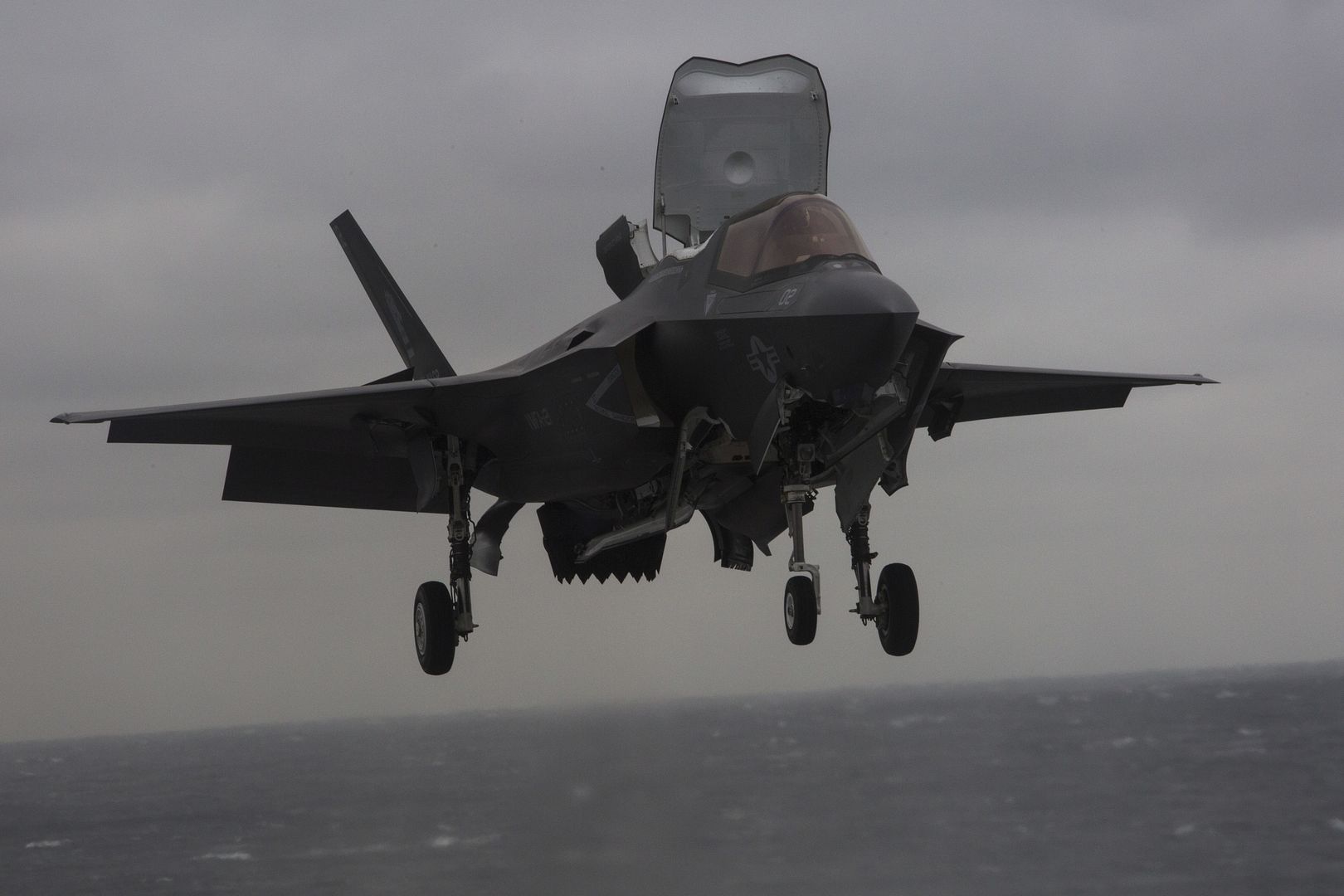
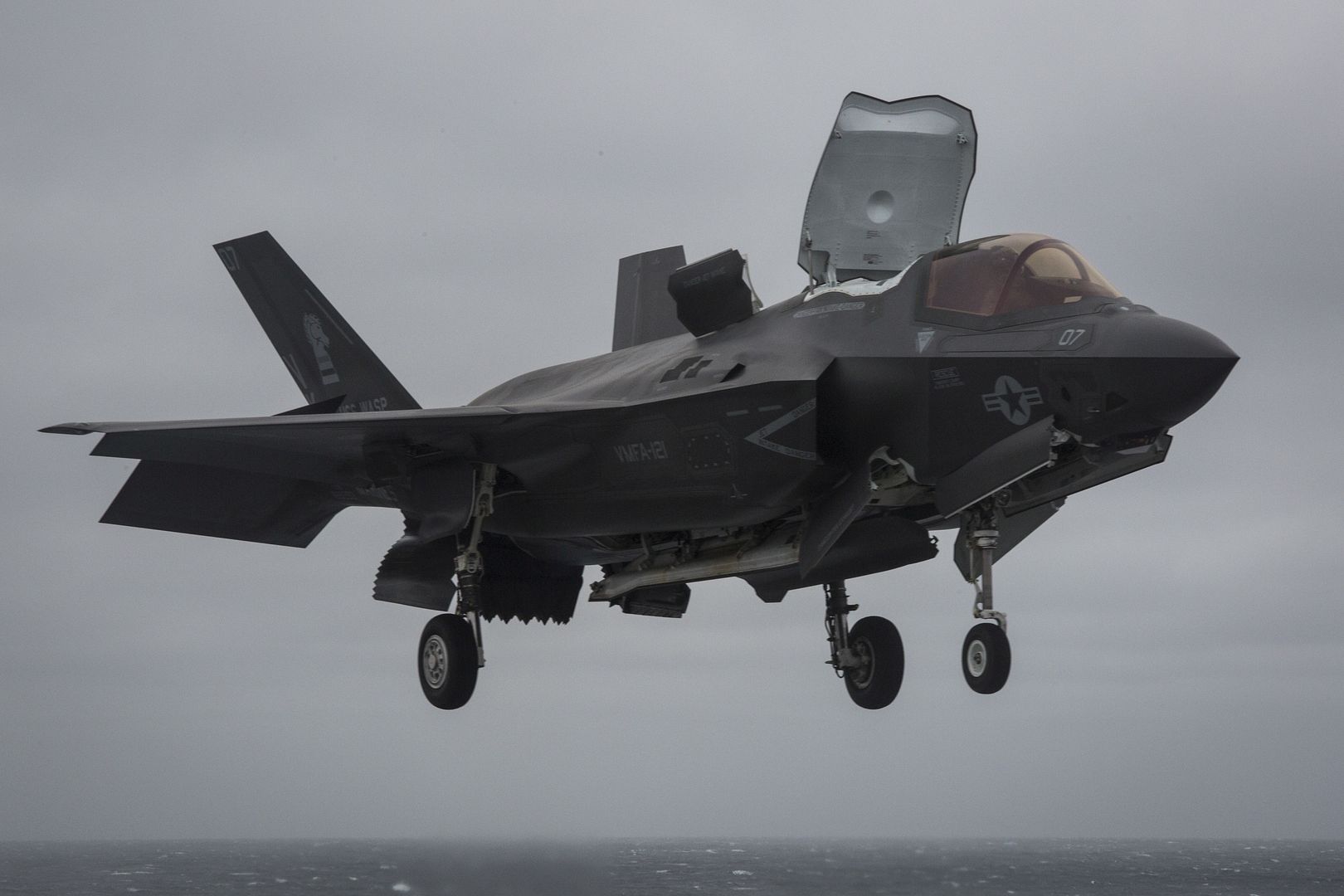
A U.S. Air Force F-22 Raptor performs aerial maneuvers during the annual Heritage Flight Training and Certification Course at Davis-Monthan Air Force Base, Ariz., March 3, 2018. Established in 1997, the HFTCC certifies civilian pilots of historic military aircraft and U.S. Air Force pilots to fly in formation during the upcoming air shows. (U.S. Air Force photo by Airman 1st Class Frankie D. Moore)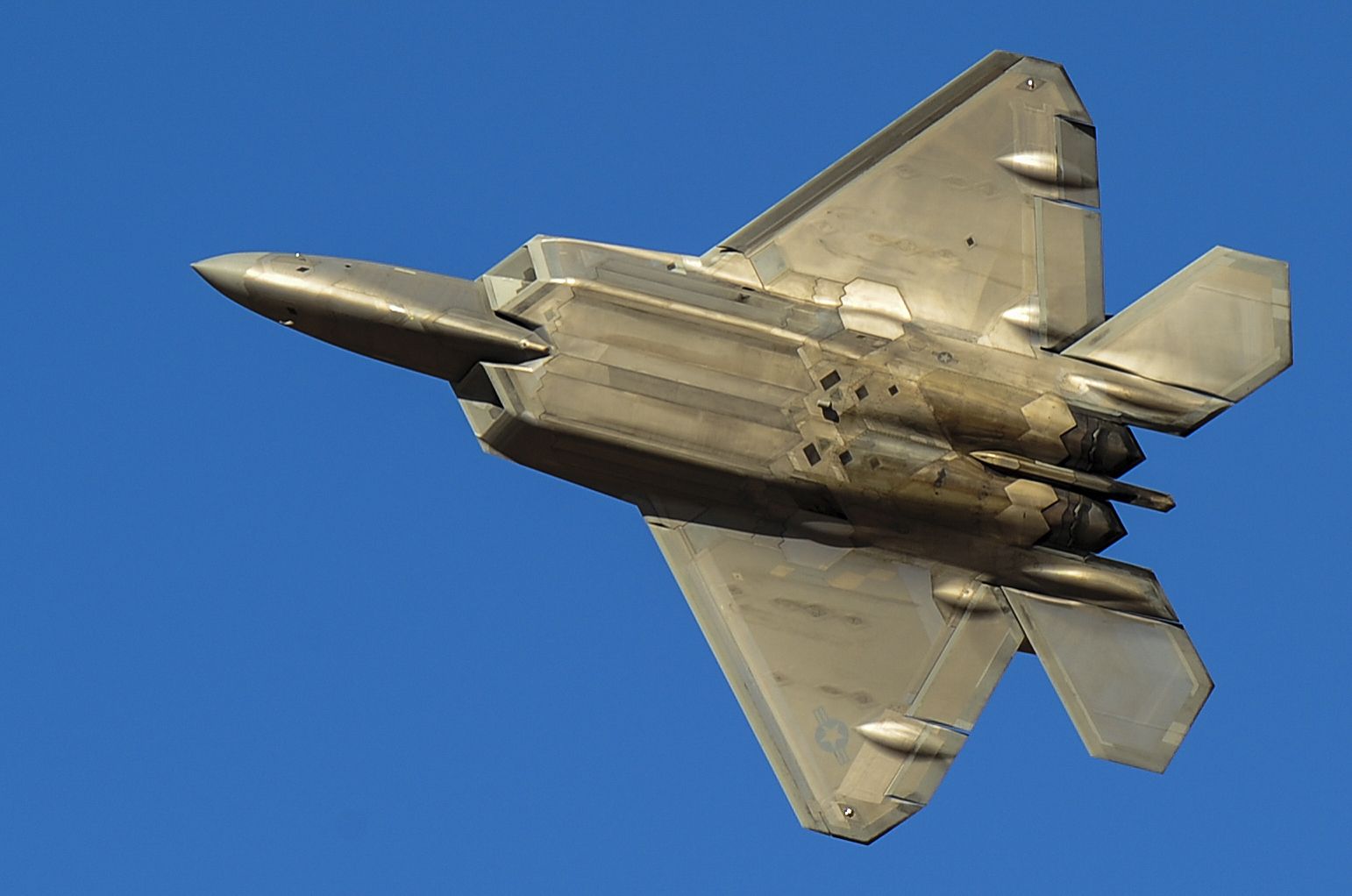
-
 Main AdminA U.S. Air Force F-22 Raptor performs aerial maneuvers during the annual Heritage Flight Training and Certification Course at Davis-Monthan Air Force Base, Ariz., March 4, 2018. The Raptor performs both air-to-air and air-to-ground missions allowing full realization of operational concepts vital to the 21st Century Air Force. (U.S. Air Force photo by Airman 1st Class Michael X. Beyer)
Main AdminA U.S. Air Force F-22 Raptor performs aerial maneuvers during the annual Heritage Flight Training and Certification Course at Davis-Monthan Air Force Base, Ariz., March 4, 2018. The Raptor performs both air-to-air and air-to-ground missions allowing full realization of operational concepts vital to the 21st Century Air Force. (U.S. Air Force photo by Airman 1st Class Michael X. Beyer)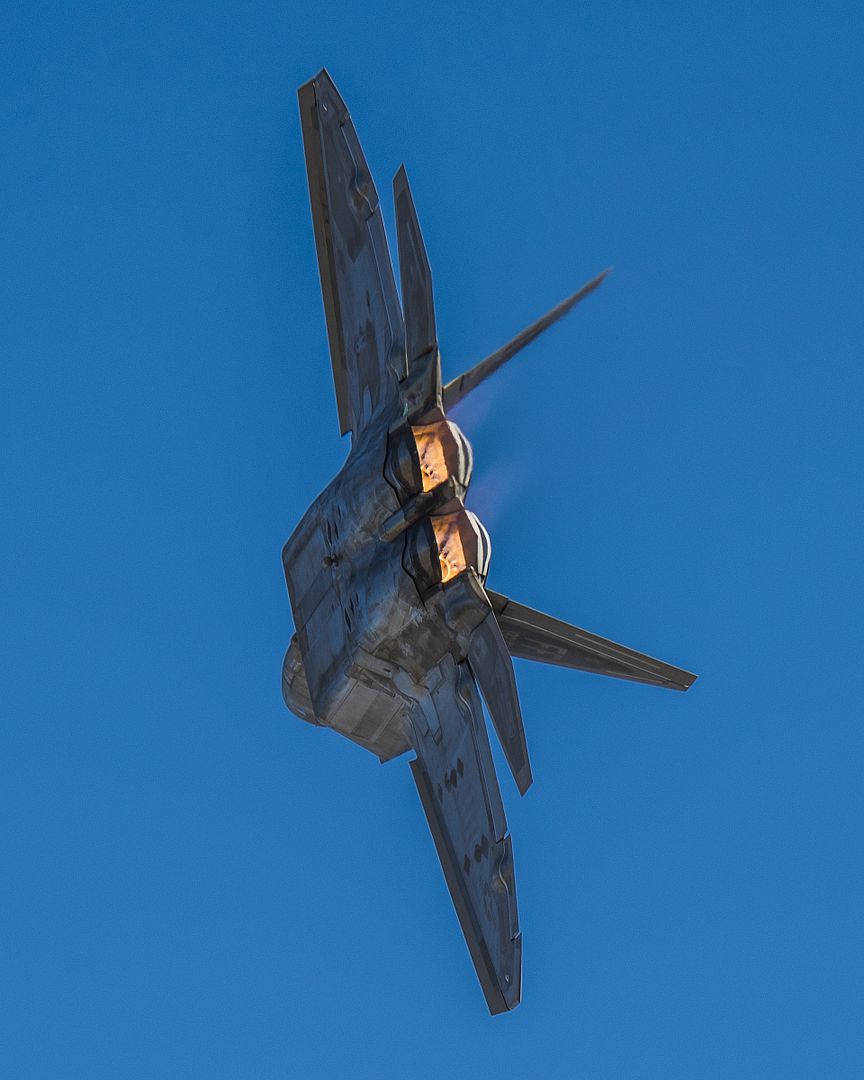
An Illinois Air National Guard C-130H Hercules from the 182nd Airlift Wing, Peoria, Ill. taxis at Powidz Air Base, Poland, March 5, 2018. Approximately 70 Airmen and three C-130s from the 182nd Airlift Wing are participating in bilateral training with the Polish Air Force during Aviation Rotation 18-2 in support of Operation Atlantic Resolve. These events occur across the U.S. European Command area of responsibility and are designed to enhance partner interoperability, maintain joint readiness, and assure our regional allies. (U.S. Air National Guard photo by Master Sgt. Todd A. Pendleton)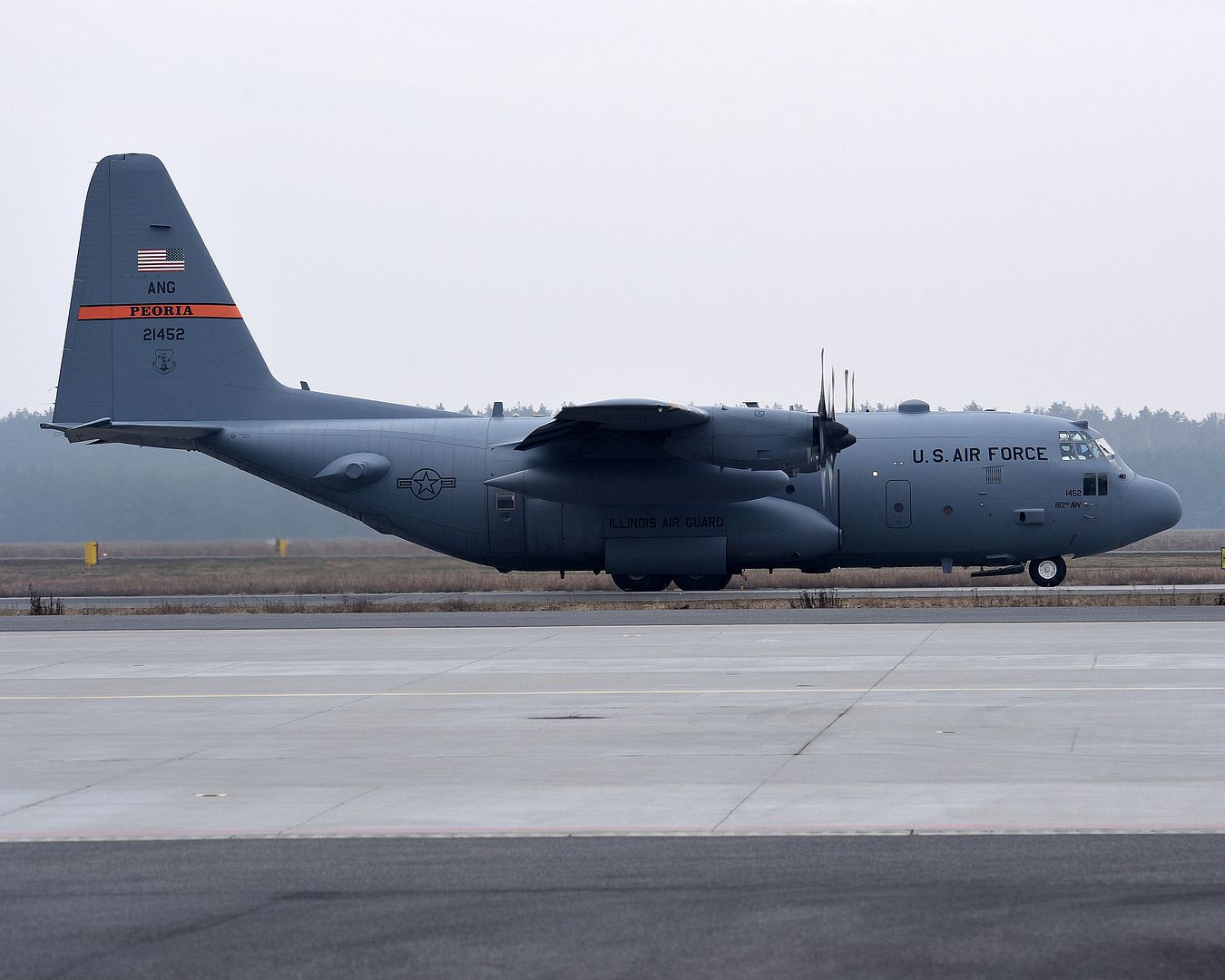
Andersen Air Force Base, Guam -- C-130J Super Hercules assigned to the 36th Airlift Squadron have exercised a new refueling capability during exercise COPE NORTH 2018 (CN18) at Tinian U.S. Commonwealth of the Northern Marianas Islands, Feb. 26.
The Helicopter Expedient Refuel System (HERS) allows the 36 AS C-130s the rapid deployment of refueling assets in an austere environment, enabling other aircraft to continue their humanitarian assistance and disaster relief efforts.
?The idea is to able to bring in fuel, drop it off, store it temporarily and put it on different aircraft as a sort of in-the-field staging of refueling capabilities,? said Capt. Andrew Kochman, 36th Mobility Response Squadron assistant director of operations.
With a maximum capacity of 3,000 gallons, the HERS enables the C-130J to quickly unload part of its own fuel to be used on other aircraft.
?We build our fuel bladder, our pumps and everything that we need to begin refueling out on the field,? said Kochman. ?After, we take on fuel from our source, in this case a C-130J, into the equipment that we brought up with us. Once we have completed that task, we are ready to start pushing gas to whoever needs it.?
During a HA/DR scenario, the HERS allows the Airmen to quickly refuel other aircraft, not just Air Force assets.
?For this exercise, we had a U.S. Navy helicopter come in and we were able to refuel it, so we are able to work not with just Air Force assets but really throughout our whole military,? said Kochman. ?Those helicopters, their mission is search and rescue and they might not be able to refuel if they needed a hard-fixed asset [traditional fixed fuel source]. Being able to refuel them out in the field and have them continue their operations just makes us that much more successful in conducting our HA/DR operations.?
Through the practice of this new capability, it ensures the U.S. Military and allied partners participating in CN18 are prepared for any possible real-world HA/DR scenarios in the future.
?By coming here and staying current on this new capability, learning new techniques, testing new equipment, and seeing how much flexibility we have with all of these operations, we become a significantly more proficient unit,? said Kochman. ?It?s also important for our international partners to be able to see how these operations work and understand how they can have a role in it as well, both with us and on their own in the future.?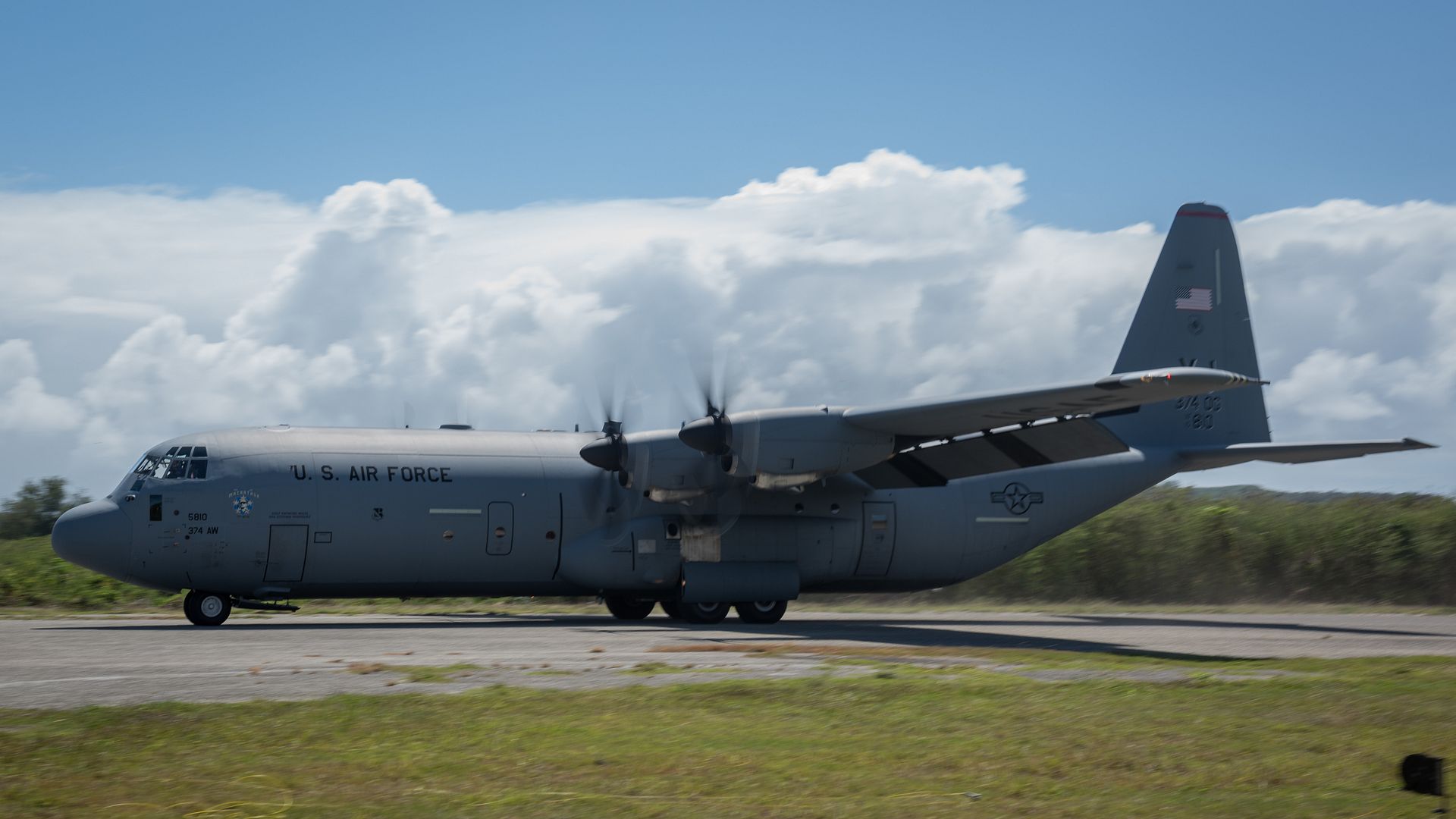
A U.S. Air Force F-22 Raptor, F-16 Fighting Falcon and an F-86 Sabre fly in formation during the 2018 Heritage Flight Training and Cerification Course at Davis-Monthan Air Force Base, Ariz., March 4, 2018. During the course, aircrews practice ground and flight training to enable civilian pilots of historic military aircraft and U.S. Air Force pilots of current fighter aircraft to fly safely in formations together. (U.S. Air Force photo by Senior Airman Mya M. Crosby)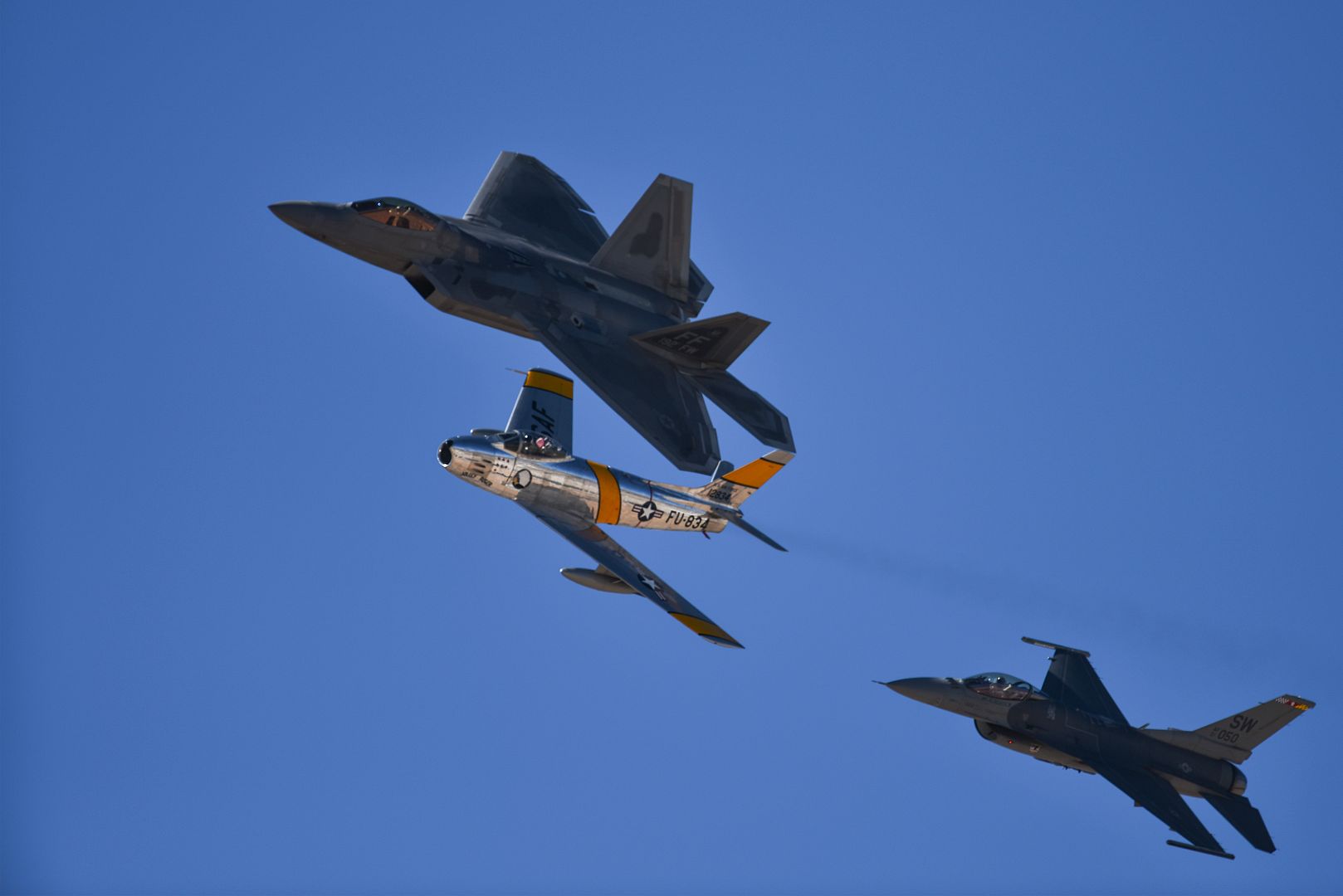
SEATTLE, March 6, 2018 /PRNewswire/ -- Boeing [NYSE:BA] and Hawaiian Airlines announced today that the carrier has selected the market-leading 787 Dreamliner as its flagship airplane for medium to long-haul flights. As part of the selection, Hawaiian intends to purchase 10 787-9 jets valued at $2.82 billion at list prices. Hawaiian also has purchase rights for 10 additional 787s.
Boeing [NYSE:BA] and Hawaiian Airlines announced today that the carrier has selected the market-leading 787 Dreamliner as its flagship airplane for medium to long-haul flights. This infographic highlights some of the airplane's features.
The Honolulu-based airline, which has steadily grown its award-winning service connecting the Hawaiian Islands with Asia and North America, had been conducting an extensive evaluation of its airplane requirements. In selecting the 787, Hawaiian will be able to take advantage of the Dreamliner family's superior fuel efficiency, range and passenger-pleasing features to enhance its operations and open new routes profitably. Boeing's competitive advantage was also enhanced by Boeing Global Services. Hawaiian will use a number of new aircraft transition support services from BGS, including Training and Initial Provisioning to ensure a successful and on-time entry into service.
The 787-9 can carry about 290 passengers on flights of about 7,635 nautical miles (14,140 km), while using 20 percent less fuel and emitting 20 percent fewer emissions than the airplanes it replaces.
"The Dreamliner's operational efficiency and superior guest experience make it the best aircraft for modernizing our fleet in 2021 and beyond," said Peter Ingram, president and chief executive officer of Hawaiian Airlines. "Its expanded seat capacity and extended range will allows us to expand within our current route network and offer new destinations in the Asia-Pacific region."
Boeing and Hawaiian Airlines will work toward finalizing this new airplane order and it will be reflected in the monthly update of Boeing's Orders & Deliveries website.
"Hawaiian Airlines has been on an impressive growth trajectory as they strategically expanded service to and from Asia and North America. We are thrilled they have chosen the 787 Dreamliner to power the next stage of their expansion," said Boeing Commercial Airplanes President and CEO, Kevin McAllister. "The Dreamliner's advanced technology, unmatched fuel efficiency, and passenger-pleasing cabin will optimize Hawaiian's fleet for the future and provide their customers with a best in-class experience."
The 787 is the fastest selling twin-aisle airplane in Boeing history. Since entering service in 2011, the 787 family is flying more than 1,500 routes and has made possible more than 170 new nonstop routes around the world.
Montreal, March 6, 2018 ? Bombardier announced today that its best-selling Challenger 350 aircraft is progressing towards steep approach certification, allowing operators to perform landings under strict conditions, including the steep 5.5-degree approach angle and short runway of London City Airport. The aircraft recently completed its steep approach certification flight test campaign, and also performed several takeoffs and landings at the London City Airport to demonstrate this operational capability. Final certification is expected later this year. With its perfectly balanced design, the Challenger 350 aircraft offers customers a smooth ride and the opportunity to reach their chosen destination quickly and efficiently.
?The Challenger 350 aircraft?s proven high performance and superior in-flight experience have made it the undeniable market leader in its segment,? said Peter Likoray, Senior Vice President, Sales and Marketing, Bombardier Business Aircraft. ?With its upcoming steep approach certification, the Challenger 350 jet is cementing its leadership position and will offer the most flexibility to our discerning clientele.?
As the only super mid-size aircraft that can fly full range at full fuel with full seat capacity, the Challenger 350 aircraft offers the luxury of having it all. Valued for its outstanding short-field performance, the aircraft climbs quickly and directly to 43,000 feet (13,106 metres) allowing passengers to reach their destination more efficiently. With the industry?s best weather radar system and the best-equipped cockpit in its class, the Challenger 350 aircraft boasts leading-edge technology and is ready to meet current and future navigational requirements.
The Challenger 350 aircraft also boasts a world-class design and offers premium comfort. Its state-of-the-art acoustical insulation allows passengers to enjoy a restful flight with interior sound levels that are among the lowest in the super mid-size segment. The aircraft?s wide and sleek cabin, along with industry-leading connectivity, ensure that passengers benefit from the ultimate business jet experience.
Existing Challenger 350 customers will be able to install the steep approach capability as a retrofit option in Bombardier?s extensive network of service centres.
Challenger 350 aircraft: Designed with a no-compromise approach, the Challenger 350 aircraft effortlessly blends powerful performance and sleek styling to deliver an unrivalled private jet experience. Industry-leading connectivity, immersive sound and ergonomically-positioned touch screens are seamlessly integrated to create an intuitive and incomparable cabin experience. Paired with impressive high-performance attributes, the Challenger 350 aircraft is designed to access challenging airfields, climb faster, and cruise efficiently while providing a smooth ride. Standing the test of time, the Challenger 300 aircraft series are the best-selling business jets of the last decade.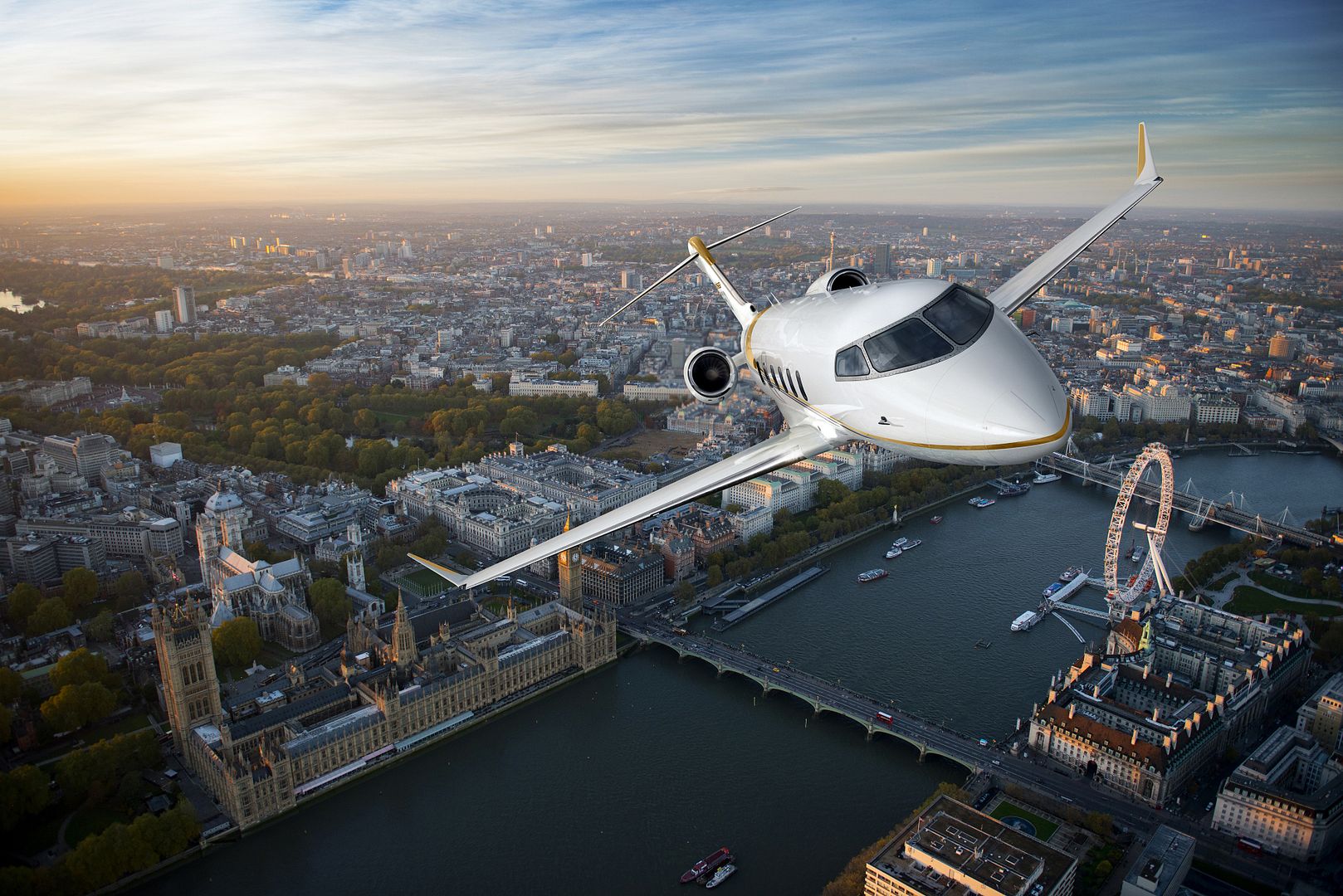
-
 Main AdminIce Camp Skate (March 5, 2018) - A Royal Canadian DHC-6 Twin Otter aircraft waits on a runway after delivering supplies and personnel to Ice Camp Skate during Ice Exercise (ICEX) 2018. ICEX 2018 is a five-week exercise that allows the Navy to assess its operational readiness in the Arctic, increase experience in the region, advance understanding of the Arctic environment, and continue to develop relationships with other services, allies and partner organizations. (U.S. Navy photo by Airman 1st Class Kelly Willett)
Main AdminIce Camp Skate (March 5, 2018) - A Royal Canadian DHC-6 Twin Otter aircraft waits on a runway after delivering supplies and personnel to Ice Camp Skate during Ice Exercise (ICEX) 2018. ICEX 2018 is a five-week exercise that allows the Navy to assess its operational readiness in the Arctic, increase experience in the region, advance understanding of the Arctic environment, and continue to develop relationships with other services, allies and partner organizations. (U.S. Navy photo by Airman 1st Class Kelly Willett)
?Mach?, 77th Expeditionary Fighter Squadron F-16 Fighting Falcon fighter pilot, takes off from Bagram Airfield, Afghanistan Feb. 28, 2018. ?Mach? logged his first combat sortie in 2011 in support of Operation Unified Protector, protecting our NATO allied partners in Libiya. Since then, he has double downed on two tours in Afghanistan and has compiled more than 1000 flying hours and 177 combat sorties during her career. (U.S. Air Force photo/Staff Sgt. Divine Cox)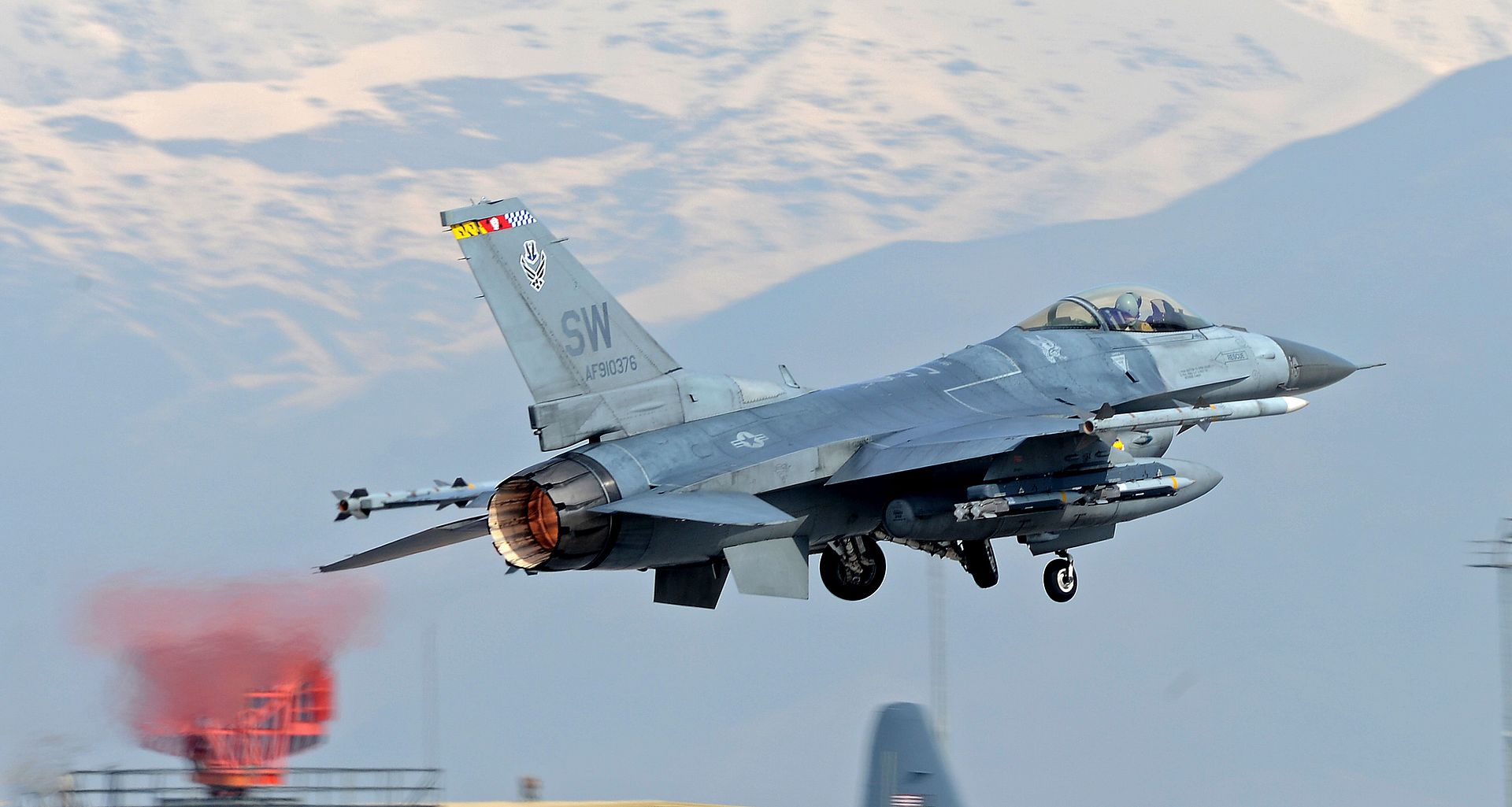
One of two Replacement Head-Up Displays installed on an Edwards C-17 Globemaster III for testing. The new system has an advanced optical design with a wide field of view. The RHUD computer also has enhanced processing and graphic capabilities. The RHUD is also designed to be installed and removed easier for maintenance. (U.S. Air Force photo by Kyle Larson)
WEST PALM BEACH, Fla., March 7, 2018 /PRNewswire/ -- The Sikorsky CH-53K King Stallion completed an external lift of a 36,000-pound payload at the Sikorsky Development Flight Center, achieving a maximum weight on the single center point cargo hook. This milestone marks completion of critical flight envelope expansion activities for the CH-53K as Sikorsky, a Lockheed Martin company (NYSE: LMT) prepares to deliver the first aircraft to the U.S. Marine Corps this year.
The CH-53K lifted the external load of 36,000 lbs. into a hover followed by flight demonstrating satisfactory handling qualities and structural margins. The gross weight of the aircraft topped out at just over 91,000 lbs., making this the heaviest helicopter ever flown by Sikorsky. View the video.
"The successful completion of these last critical envelope expansion tests further demonstrates the maturity of the CH-53K aircraft," said Dr. Michael Torok, Sikorsky Vice President, Marine Corps Systems. "We look forward to bringing this unique and exceptional heavy lift capability to the United States Marine Corps and our international customers."
Prior to the 36,000-lb. lift, the CH-53K lifted various external payloads up to 27,000 lbs. including a Joint Light Tactical Vehicle (JLTV). The CH-53K can carry a 27,000 lb. external load over 110 nautical miles in high/hot conditions, which is more than triple the external load carrying capacity of the legacy CH-53E aircraft. Other flight envelope accomplishments include tethered hover demonstrating flight speeds to 200 knots, angle of bank to 60 degrees, takeoffs and landings from sloped surfaces up to 12 degrees, external load auto-jettison, and gunfire testing.
"The payload capability of this helicopter is unmatched, triple that of its predecessor and better than any other heavy lift helicopter in production," said Col. Hank Vanderborght, U.S. Marine Corps Program Manager for the Naval Air Systems Command's Heavy Lift Helicopters Program. "The CH-53K program continues on pace to deploy this incredible heavy lift capability to our warfighters."
The CH-53K is also garnering international interest. Rheinmetall and Sikorsky recently signed a strategic teaming agreement to offer the CH-53K for Germany's new heavy lift helicopter competition. Additional teammates will be announced in the coming weeks leading up to the aircraft's debut at the ILA Berlin Air Show in April.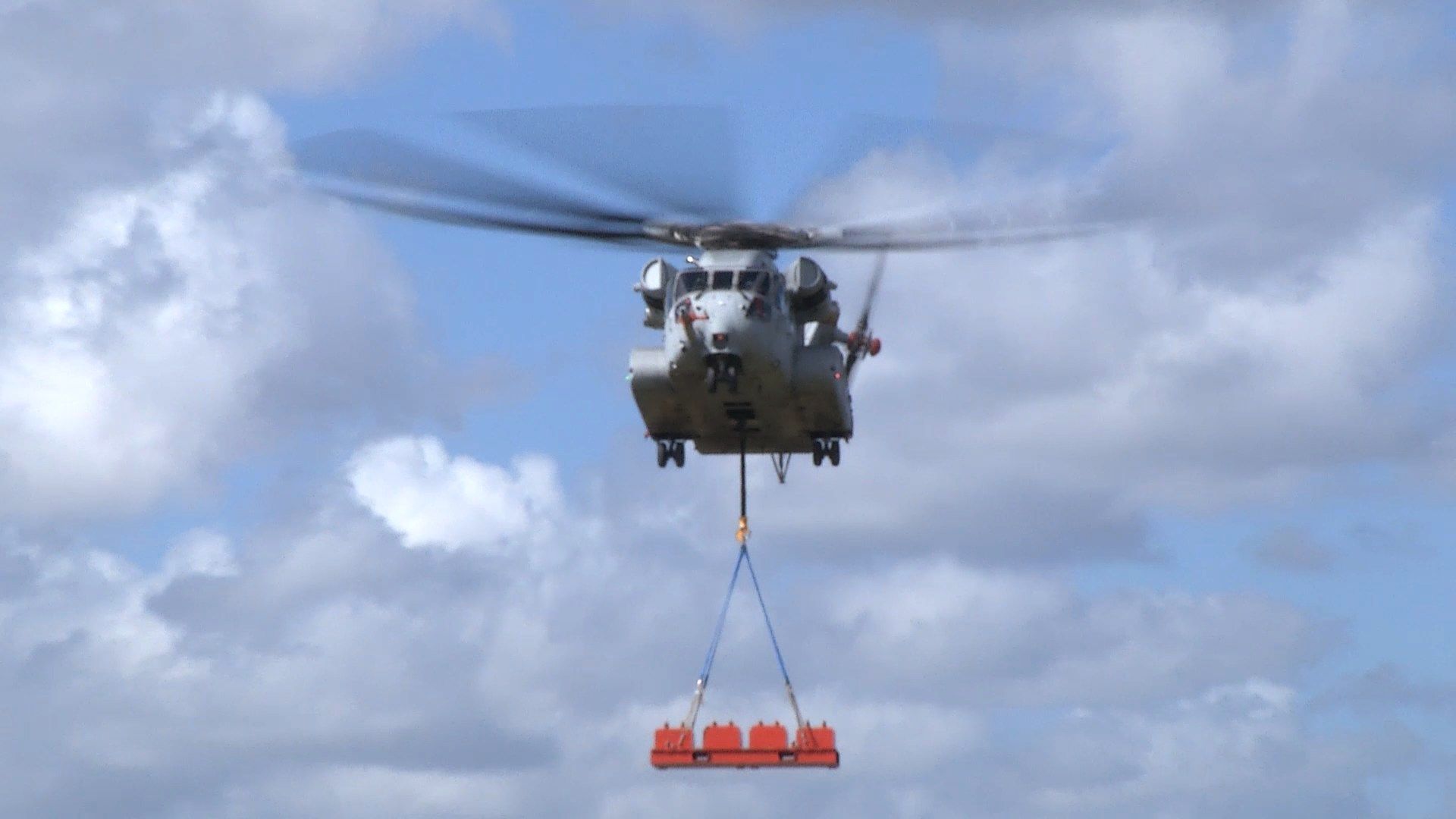
-
 Main AdminAn HH-60 Blackhawk helicopter crew with Company C, 2nd General Support Aviation Battalion, 227th Aviation Regiment, 1st Combat Aviation Brigade, 1st Cavalry Division, fuels up at an airfield just outside of Grafenwoehr, Germany during training Mar. 7, 2018. Troopers of the brigade are providing aviation support during Dynamic Front 18, an annual U.S. Army Europe exercise focused on enhancing interoperability of U.S. Army, joint service and allied nation artillery and fire support in a multinational environment. (U.S. Army photo's by Sgt. Gregory T. Summers / 22nd Mobile Public Affairs Detachment)
Main AdminAn HH-60 Blackhawk helicopter crew with Company C, 2nd General Support Aviation Battalion, 227th Aviation Regiment, 1st Combat Aviation Brigade, 1st Cavalry Division, fuels up at an airfield just outside of Grafenwoehr, Germany during training Mar. 7, 2018. Troopers of the brigade are providing aviation support during Dynamic Front 18, an annual U.S. Army Europe exercise focused on enhancing interoperability of U.S. Army, joint service and allied nation artillery and fire support in a multinational environment. (U.S. Army photo's by Sgt. Gregory T. Summers / 22nd Mobile Public Affairs Detachment)

An AH-64 Apache helicopter crew with 1st Attack Reconnaissance Battalion, 227th Aviation Regiment, 1st Air Cavalry Brigade, 1st Cavalry Division, awaits fuel and ammo at a forward area refueling point (FARP) at an airfield just outside of Grafenwoehr, Germany, Mar. 7, 2018. Troopers of the battalion are conducting gunnery training and providing aerial fire support during the duration of Dynamic Front 18, an annual U.S. Army Europe exercise focused on strengthening interoperability of U.S. Army, joint service and allied nation artillery and fire support in a multinational environment. (U.S. Army photo's by Sgt. Gregory T. Summers / 22nd Mobile Public Affairs Detachment)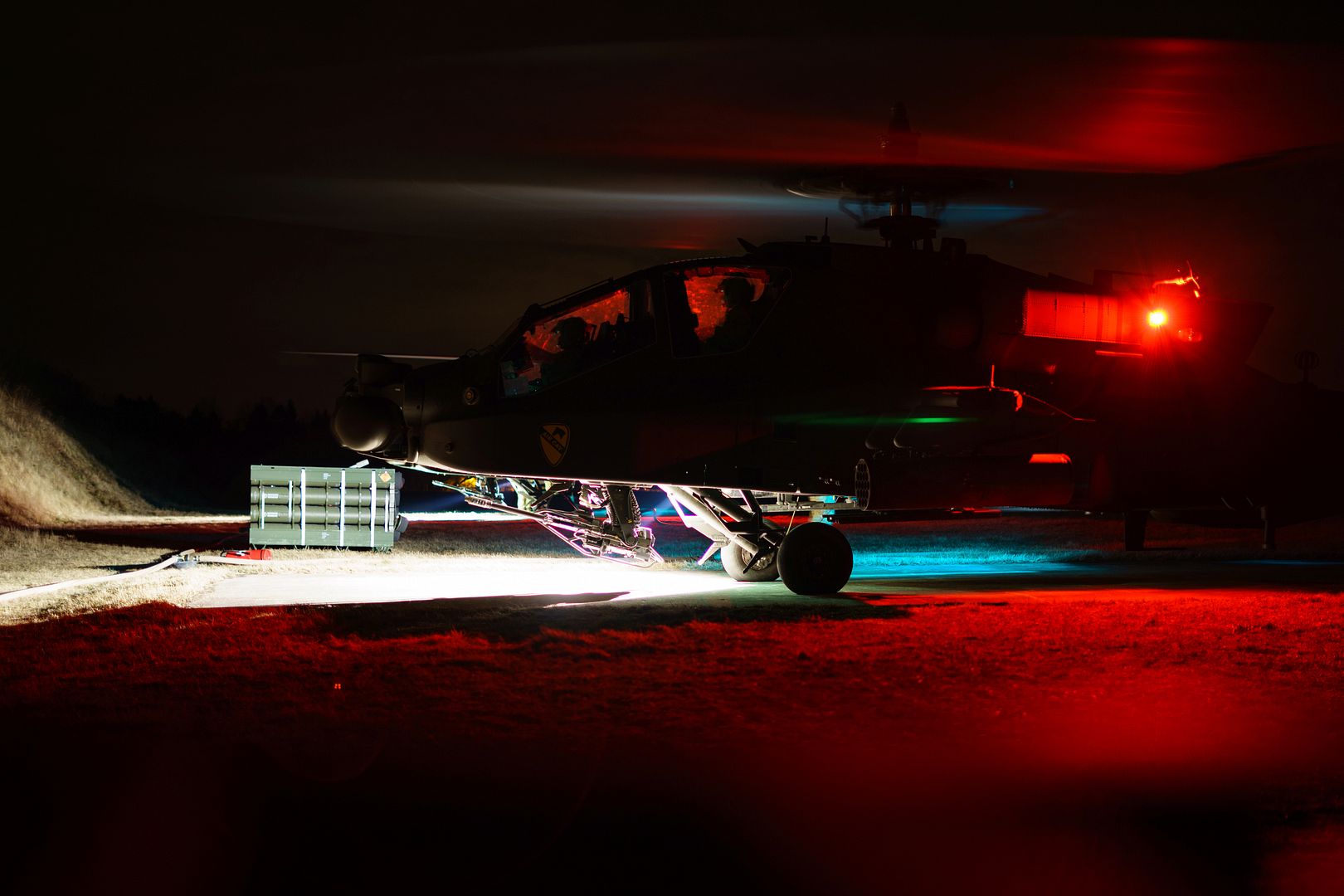
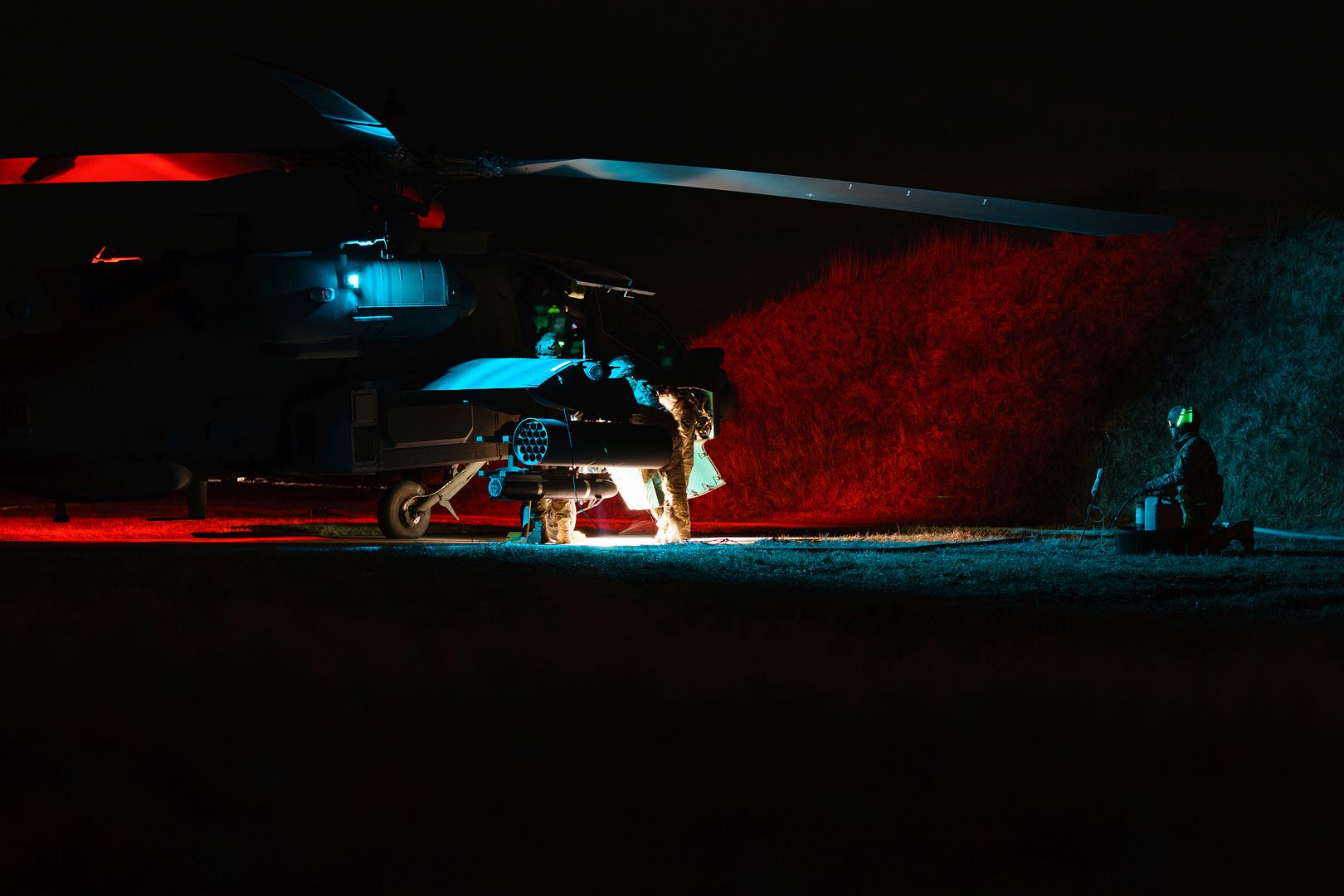
U.S. Air Force Maj. Paul ?Loco? Lopez, Air Combat Command F-22 Raptor Demonstation Team, flies the F-22 Raptor, demonstrating its combat capabilities during the U.S. Air Force Heritage Flight Training Course at Davis-Monthan Air Force Base, Arizona, March 4, 2018. The Raptor is a multirole fighter capable of supporting both air-to-air and air-to-ground missions worldwide. (U.S. Air Force photo by Tech. Sgt. Natasha Stannard)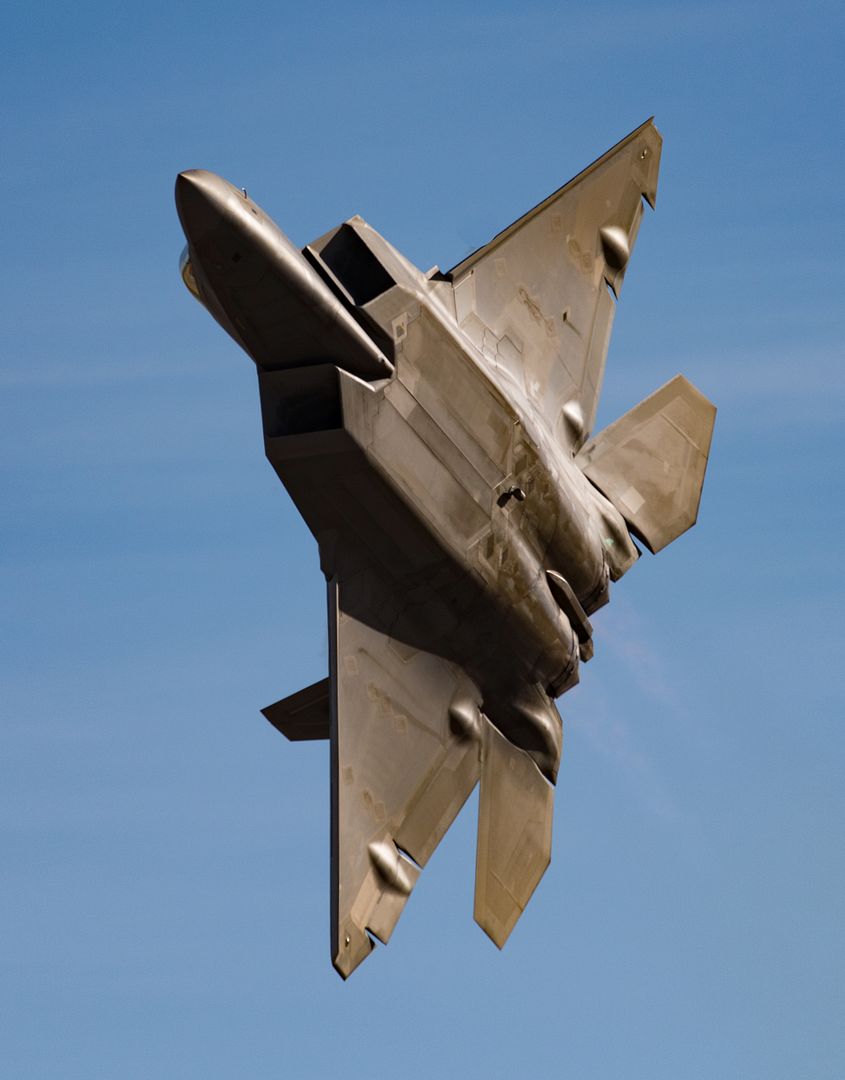
U.S. Air Force Maj. Paul ?Loco? Lopez, Air Combat Command F-22 Raptor Demonstation Team, flies the F-22 Raptor in formation with P-51 Mustangs during the U.S. Air Force Heritage Flight Training Course at Davis-Monthan Air Force Base, Arizona, March 2, 2018. The heritage flights featured combat-proven, legacy and fourth and fifth-generation aircraft demonstrations and formations. (U.S. Air Force photo by Tech. Sgt. Natasha Stannard)
An AC-130W Stinger II makes contact with the refueling boom of a KC-135 Strantotanker assigned to McConnell Air Force Base, Kansas, March 7, 2018, in the skies over New Mexico. The KC-135?s primary mission is to keep aircraft in the air through the use of in-flight refueling, and is the core aerial refueling capability of the U.S. Air Force. (U.S. Air Force photo by Staff Sgt. Tara Fadenrecht)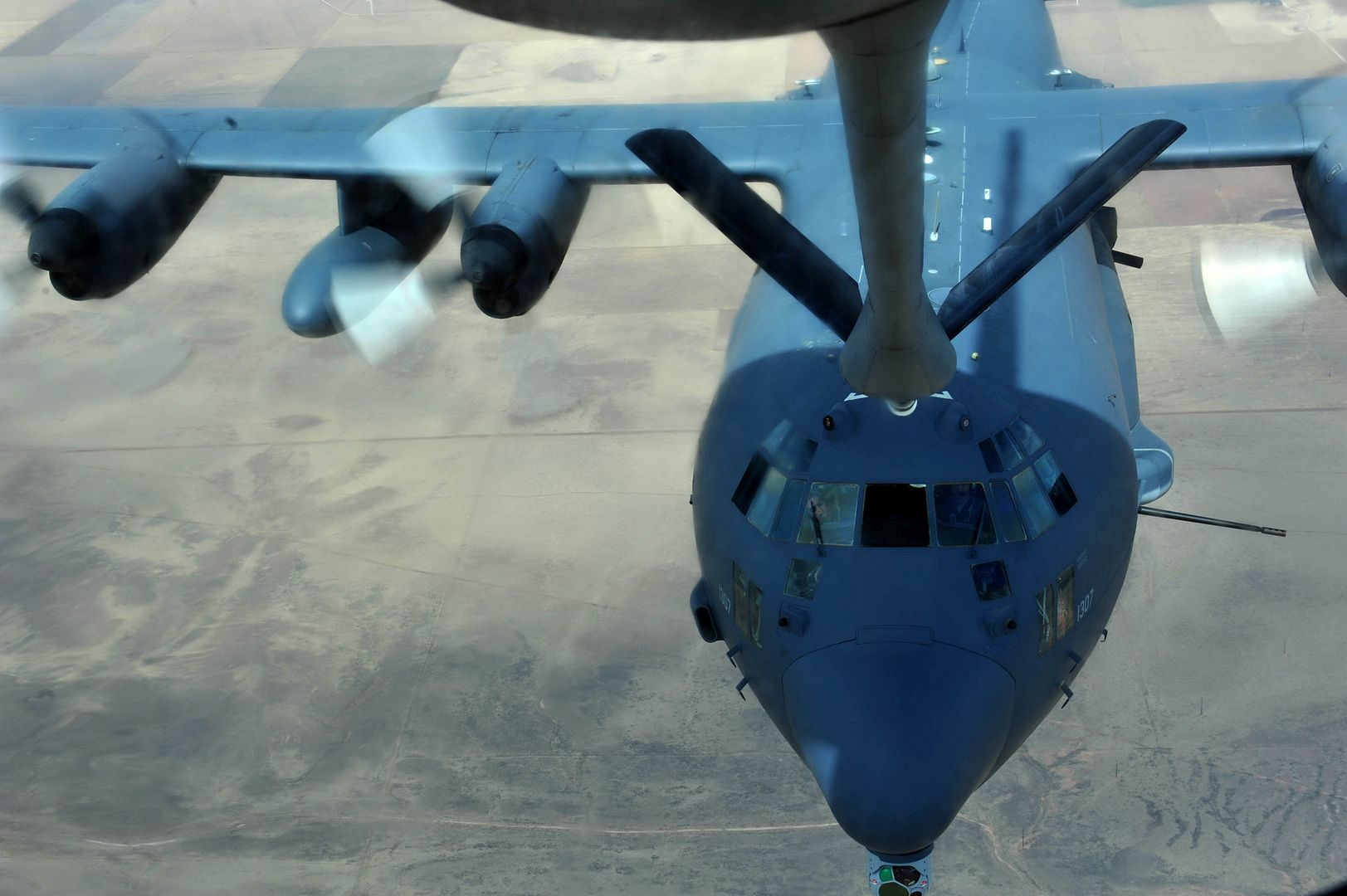
Two F-16 Fighting Falcons fly in formation over New Mexico after being refueled by a KC-135 Stratotanker assigned to McConnell Air Force Base, Kansas, March 7, 2018. F-16s and other aircraft depend on the KC-135?s aerial refueling capabilities to stay in the air longer and efficiently complete their mission. (U.S. Air Force photo by Staff Sgt. Tara Fadenrecht)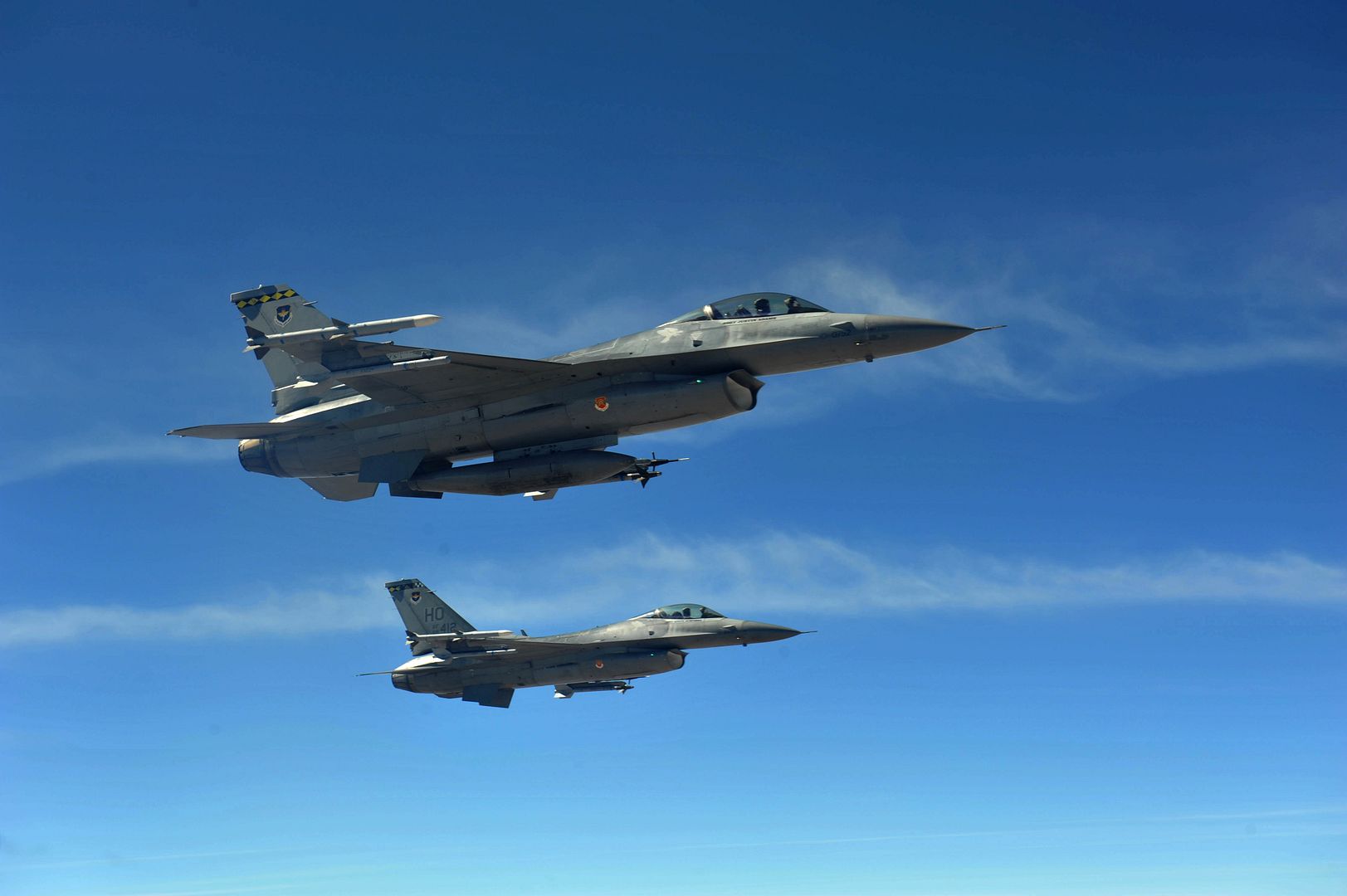
An F-16 Fighting Falcon flies next to a KC-135 Stratotanker assigned to McConnell Air Force Base, Kansas, after completing a refueling mission March 7, 2018, over New Mexico. Aircrew use training missions to keep their skills sharp and ready to defend the country at a moment?s notice. (U.S. Air Force photo by Staff Sgt. Tara Fadenrecht)
SHANGHAI, March 8, 2018 /PRNewswire/ -- Boeing (NYSE: BA) has expanded its commercial Pilot Development Program (PDP) with the addition of Okay Airways to its growing customer list. The airline joins recent customers Kunming Airlines and YTO Airlines. All three carriers are based in China.
Boeing has expanded its commercial Pilot Development Program (PDP) with the addition of Okay Airways to its growing customer list. (Boeing photo)
Through the Pilot Development Program, Boeing works with a network of flight schools around the globe to provide airlines with comprehensive commercial training including screening PDP cadets, managing student performance and correction, and developing commercial pilot training courses and materials. The comprehensive program includes ab-initio?pilot training from zero-flight-hour experience through advanced flight training?and is designed to develop cadets into 737 type-rated first officers.
"This strategic cooperation deepens our relationship with Boeing, and allows us to lay a solid foundation for training and a steady stream of talent," said Dr. Li Zonglin, CEO of Okay Airways. "The Pilot Development Program offers pragmatic and effective training, with continuous improvement of training quality."
"Boeing's Pilot Development Program is just one way that our Boeing Global Services team is delivering solutions to meet the needs of customers, both in China and around the globe," said Keith Cooper, vice president of Training & Professional Services, Boeing Global Services. "The commercial aviation market is experiencing an unprecedented demand for pilots, and we anticipate this to continue for the next several years. We're committed to supporting the full lifecycle of an aircraft, and through our training business, we're helping to ensure that our airline customers have pilots available to fly them."
-
 Main AdminEAST CHINA SEA (March 9, 2018) Aviation Boatswain's Mate 3rd Class Donovan Hampton launches an F-35B assigned to the "Green Knights" of Marine Fighter Attack Squadron 121 (VMFA-121) off the flight deck of the amphibious assault ship USS Wasp (LHD 1) as part of a routine patrol in the Indo-Pacific region. The Wasp Expeditionary Strike Group (ESG) is conducting a regional patrol meant to strengthen regional alliances, provide rapid-response capability, aACnd advance the Up-Gunned ESG concept. (U.S. Navy photo by Mass Communication Specialist 3rd Class Levingston Lewis/Released)
Main AdminEAST CHINA SEA (March 9, 2018) Aviation Boatswain's Mate 3rd Class Donovan Hampton launches an F-35B assigned to the "Green Knights" of Marine Fighter Attack Squadron 121 (VMFA-121) off the flight deck of the amphibious assault ship USS Wasp (LHD 1) as part of a routine patrol in the Indo-Pacific region. The Wasp Expeditionary Strike Group (ESG) is conducting a regional patrol meant to strengthen regional alliances, provide rapid-response capability, aACnd advance the Up-Gunned ESG concept. (U.S. Navy photo by Mass Communication Specialist 3rd Class Levingston Lewis/Released)
GRAND PRAIRIE, Texas, Airbus Helicopters, Inc. received a contract valued at approximately $273 million to deliver 35 additional UH-72A Lakotas for the United States Army.
The $273 million contract includes the UH-72A production aircraft, associated technical and flight operator manuals and program management. This procurement is broken into two configurations: 17 UH-72A Lakotas for the Initial Entry Rotary Wing mission at Ft. Rucker and 18 UH-72A Lakotas for the Observer/Controller mission at the Army?s Combat Training Centers.
?We are proud that the U.S. Army has continued to rely on us to provide this versatile capability for its aviation fleet. We have an unbroken record of on-cost and high-quality program excellence and support for this aircraft,? said Chris Emerson, President and CEO of Airbus Helicopters, Inc. and Head of North American Region.
Airbus builds the Lakota at its Columbus, Mississippi facility. Since the program inception in 2005, Airbus has delivered more than 412 Lakotas. The UH-72A is a twin-engine light utility helicopter used for a wide range of military operations including border patrol, MEDEVAC, troop and VIP transport, light cargo, Homeland Security.
Available in multiple configurations with the lowest cost to buy, own and operate of any U.S. military helicopter in production, the UH-72A is a key component of the Army?s Aviation Restructuring Initiative (ARI) and the primary rotary-wing trainer for the U.S. Army Aviation Center of Excellence at Fort Rucker, Ala.
Lakotas have been employed extensively over the last few months, responding to wildfires in California, and Hurricanes Irma and Harvey.
A number of states across the country are partnering with local authorities using the Lakota to assist in the execution of domestic missions, highlighting the unique versatility of this aircraft and its ability to perform in joint governmental and non-governmental agency operations.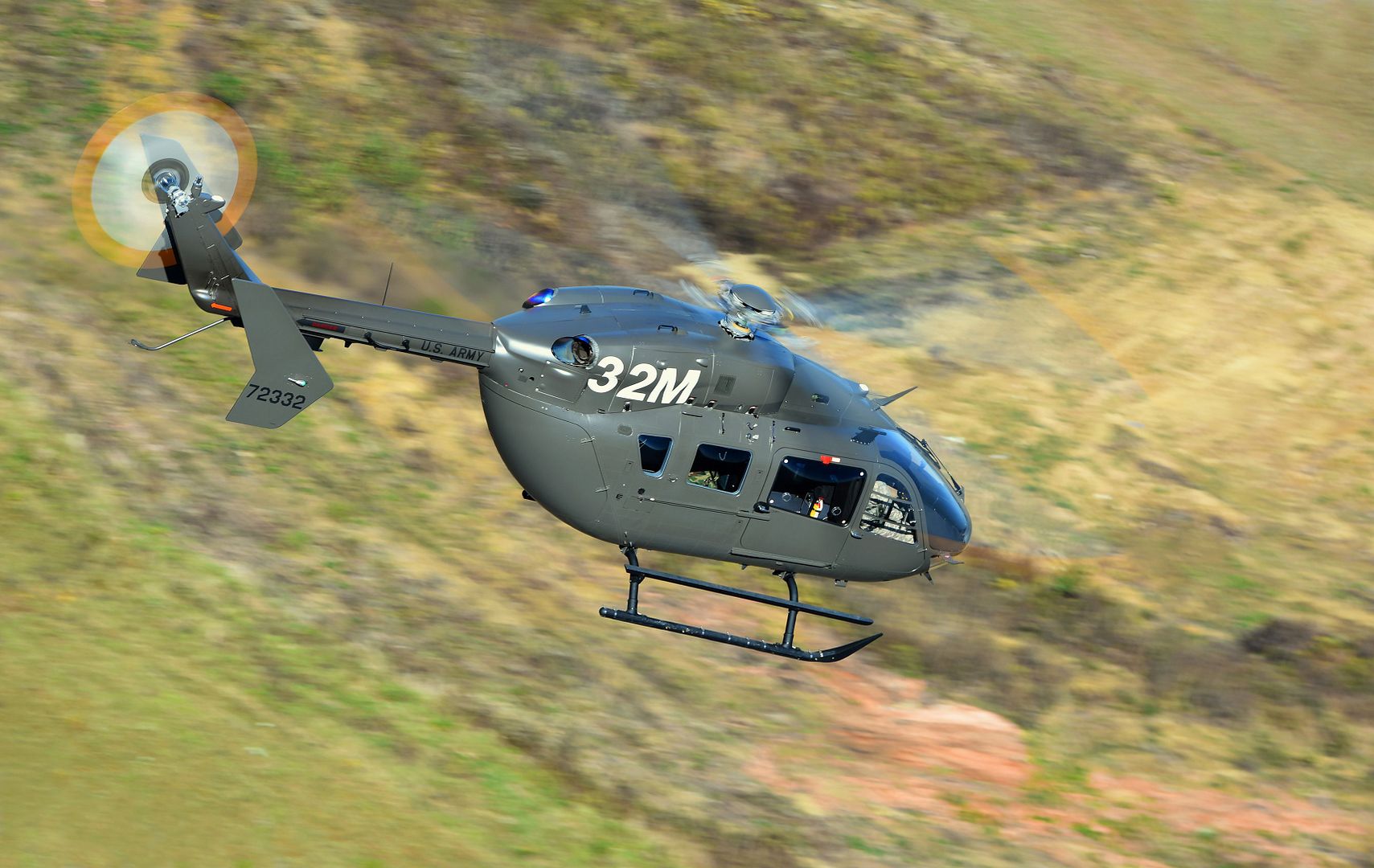
-
 Main AdminFarewell to MQ-1B Predator.
Main AdminFarewell to MQ-1B Predator.
The MQ-1B Predator flies for the final time at Incirlik Air Base, Turkey, March 9, 2018. (U.S. Air Force photo's by Staff Sgt. Rebeccah A. Woodrow)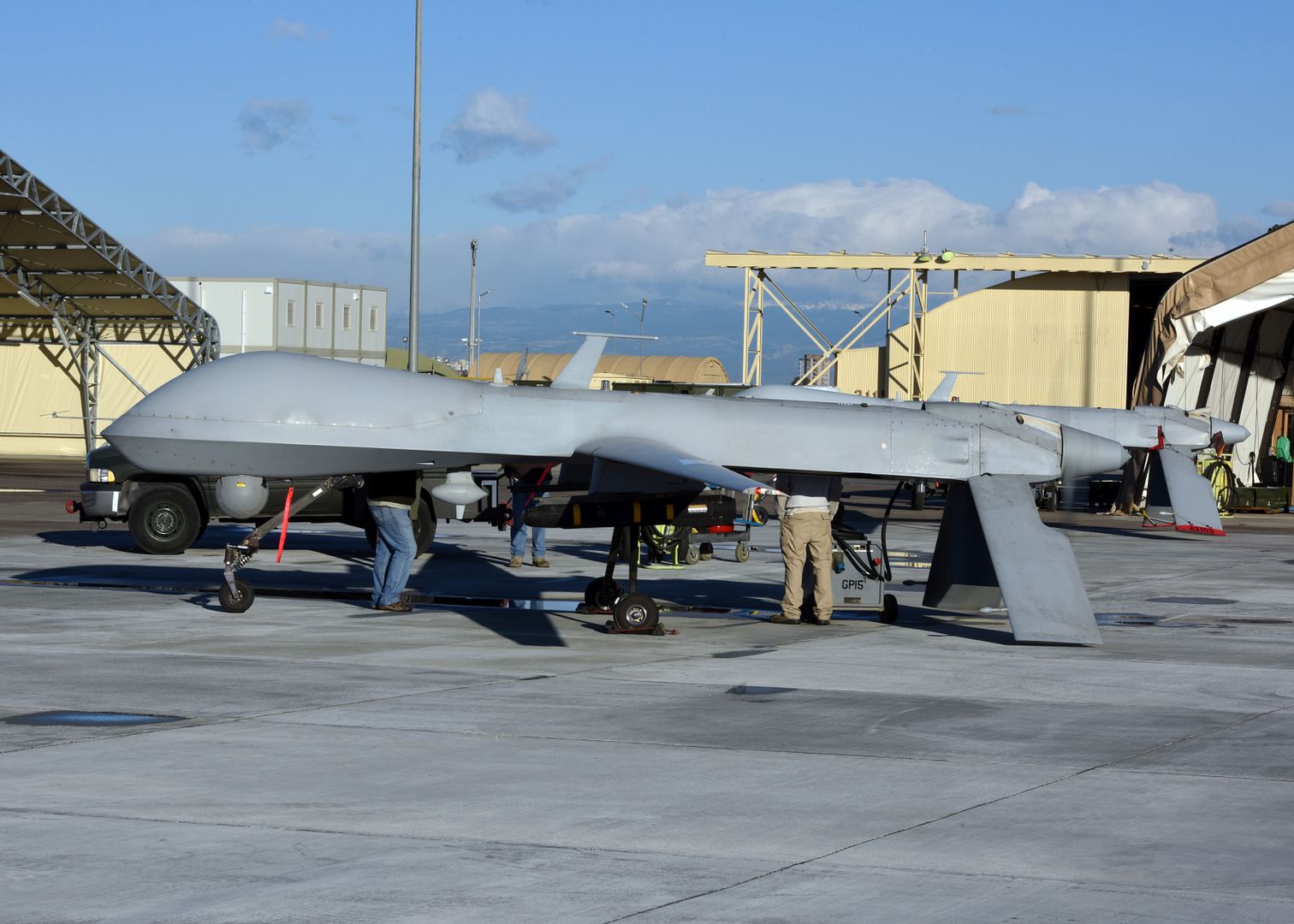

AU.S. Air Force F-16C Fighting Falcon's with the 177th Fighter Wing, New Jersey Air National Guard, are on initial approach to the Air Dominance Center in Savannah, Georgia, March 8, 2018. The 177th FW participated in an air-to-air training exercise to sharpen air combat capabilities and accomplish multiple training upgrades. (U.S. Air National Guard photo's by Senior Airman Cristina J. Allen)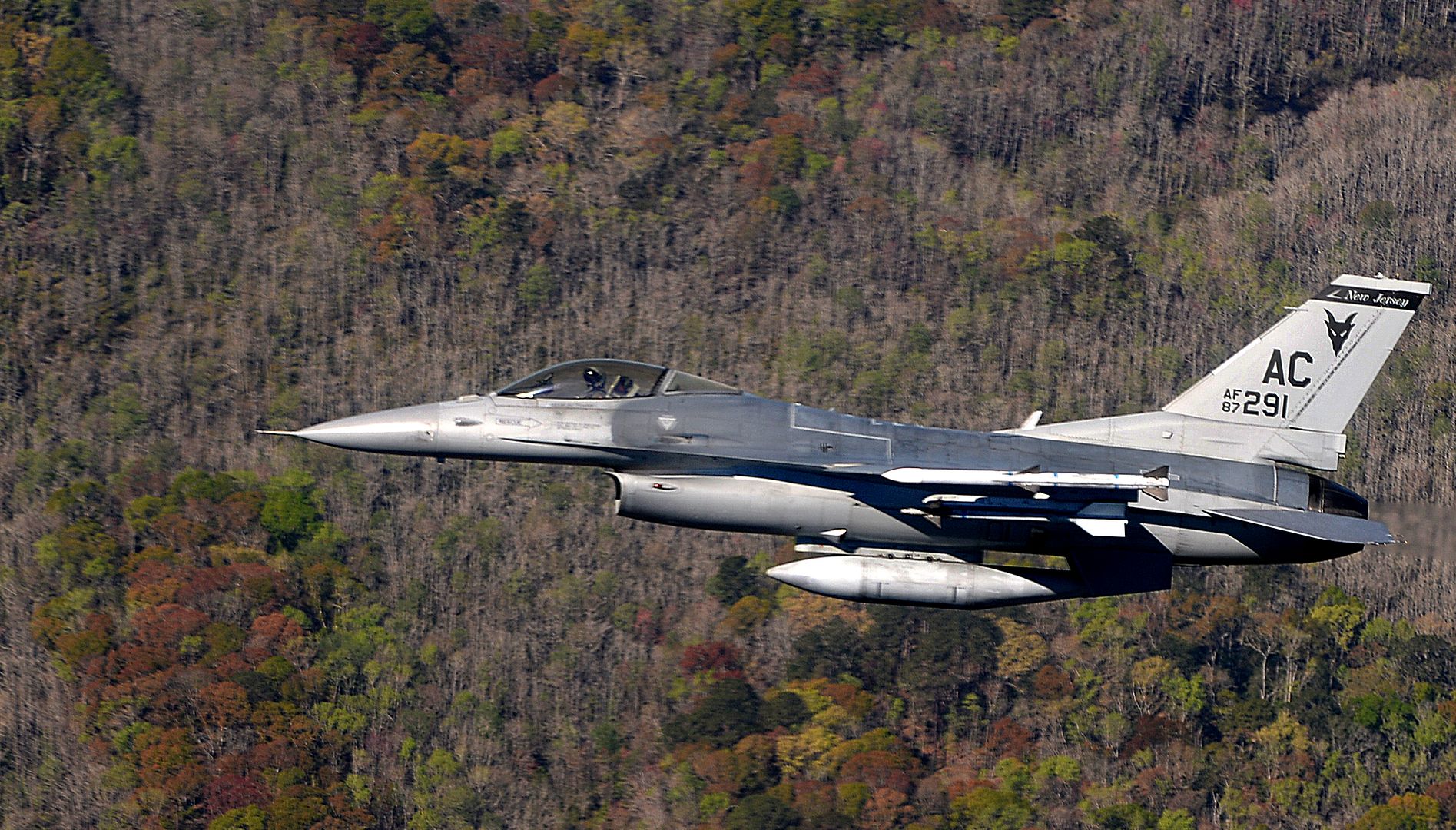
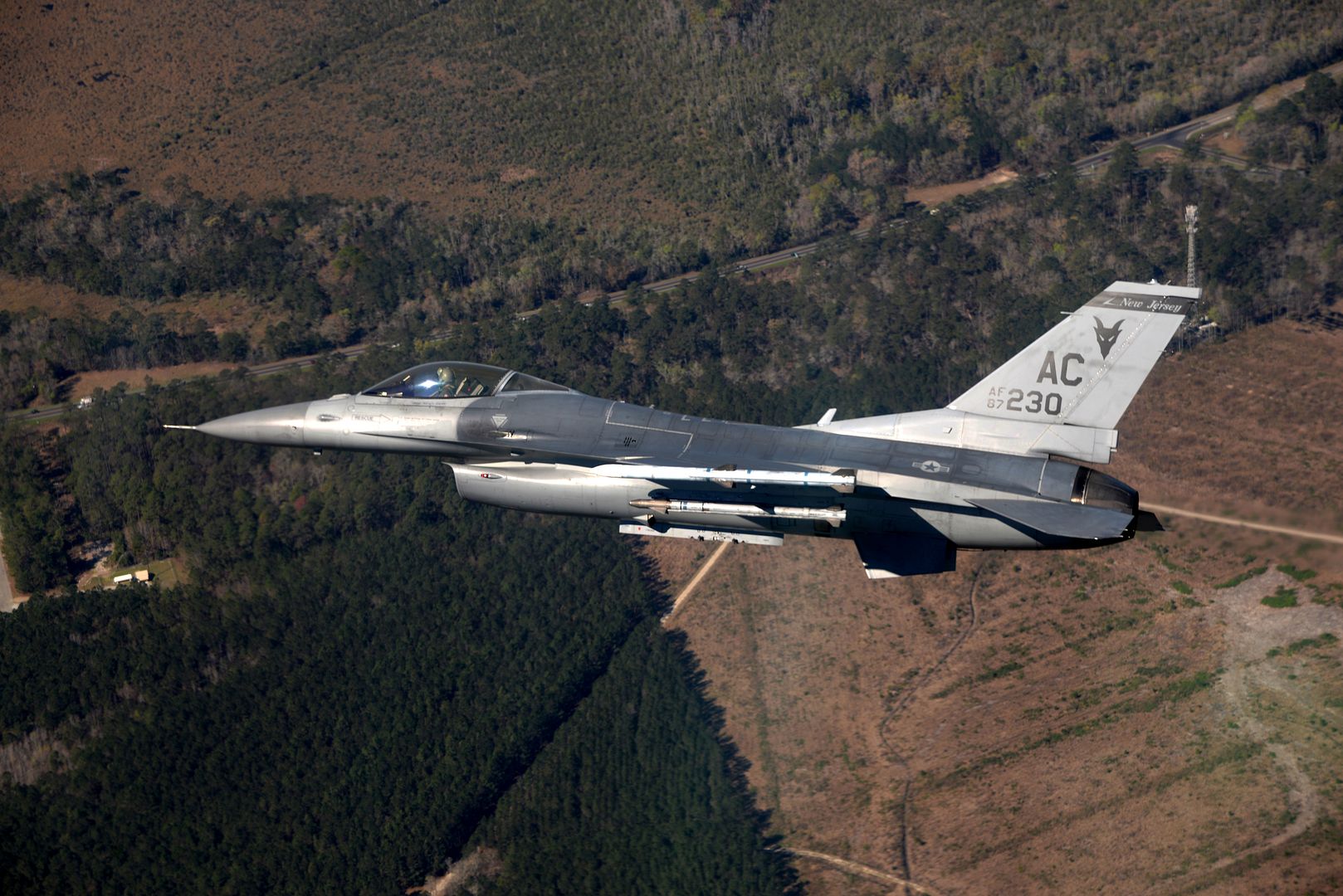
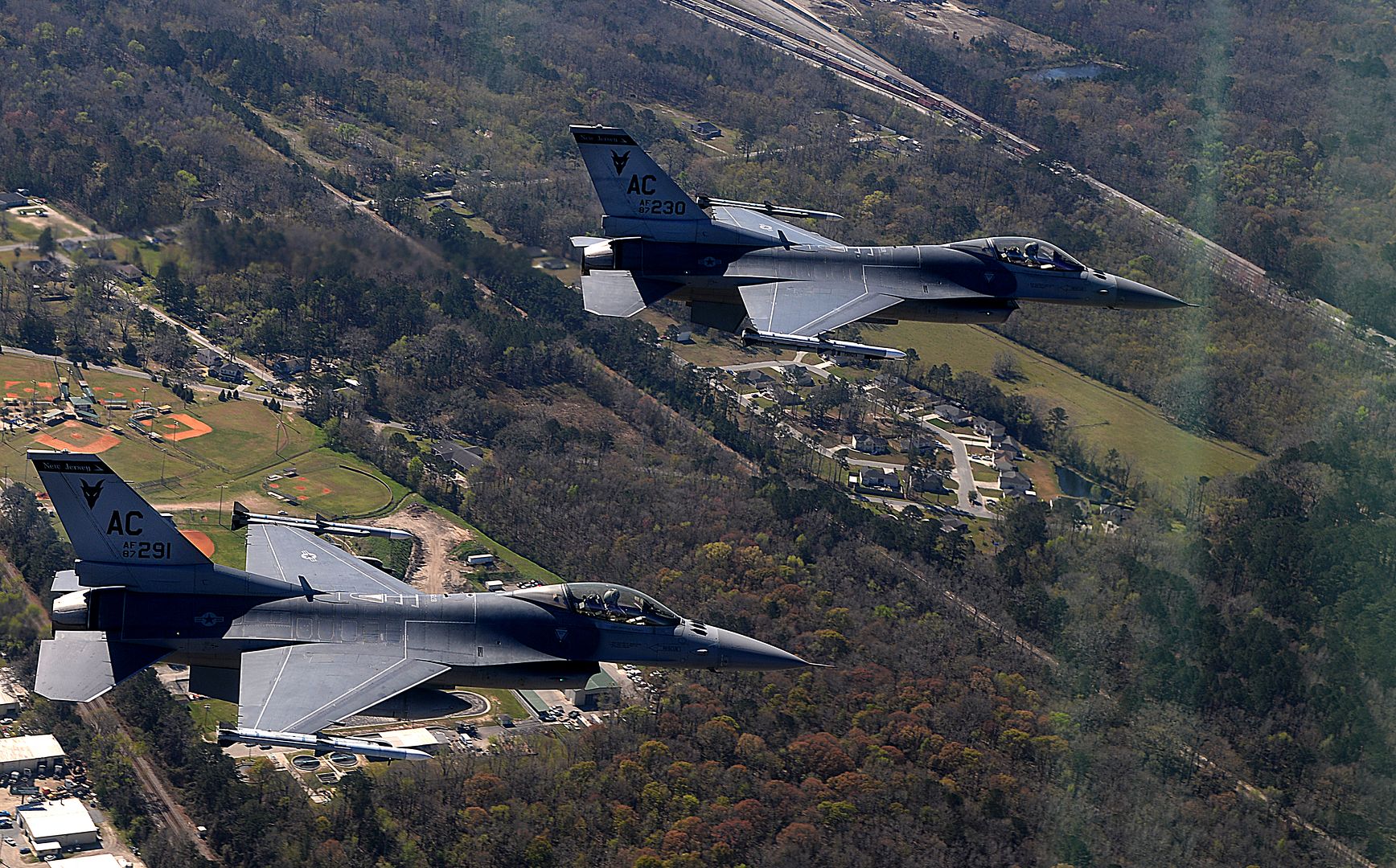
A U.S. Air Force F-16 Fighting Falcon assigned to the 455th Air Expeditionary Wing, Bagram Airfield, Afghanistan receives fuel over Afghanistan from a KC-10 Extender, March 9,2018.
The F-16's provide cover from above for Afghan and coalition forces on the ground, deterring insurgent activity.
(U.S. Air Force photo's by Tech. Sgt. Anthony Nelson Jr.)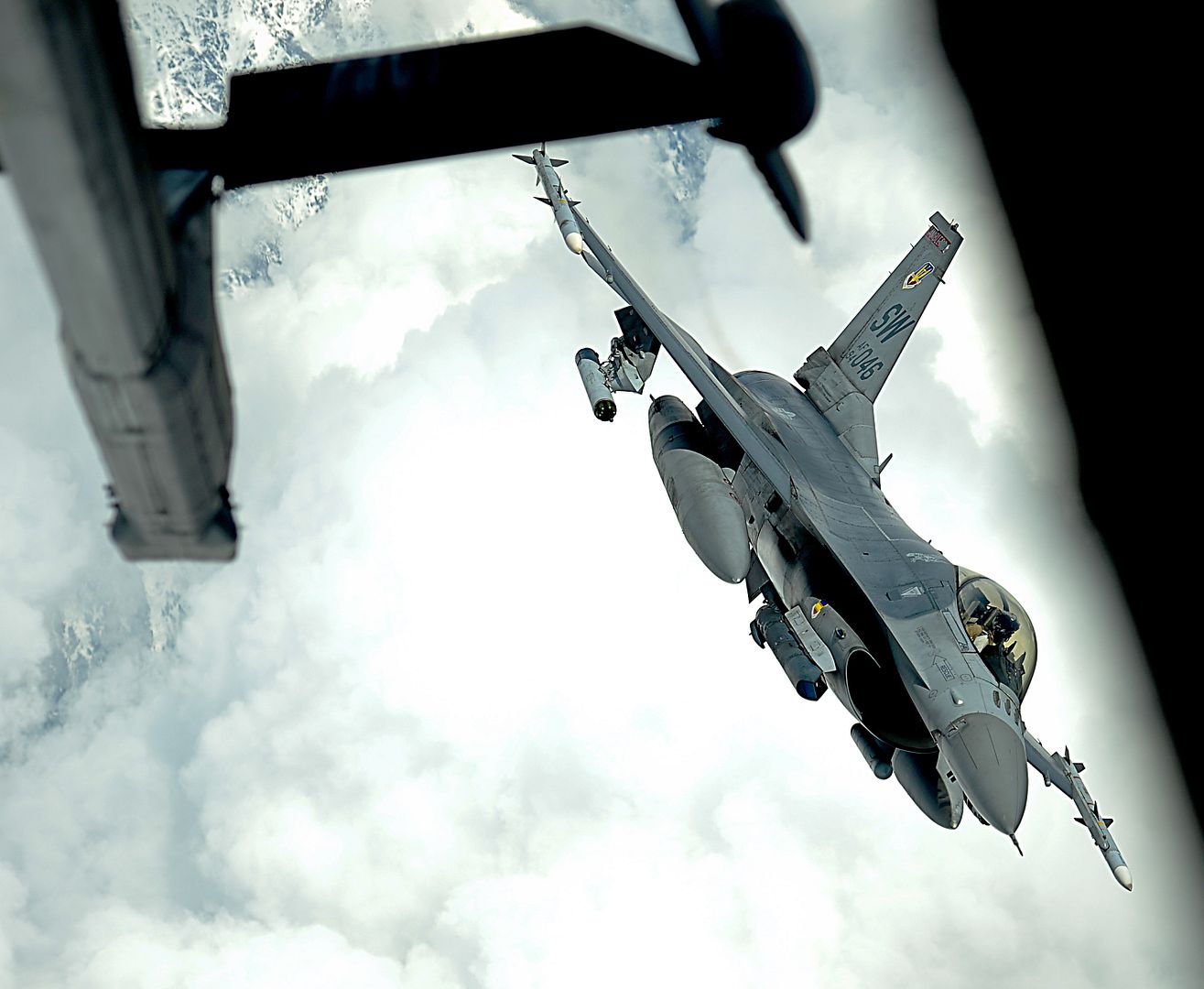
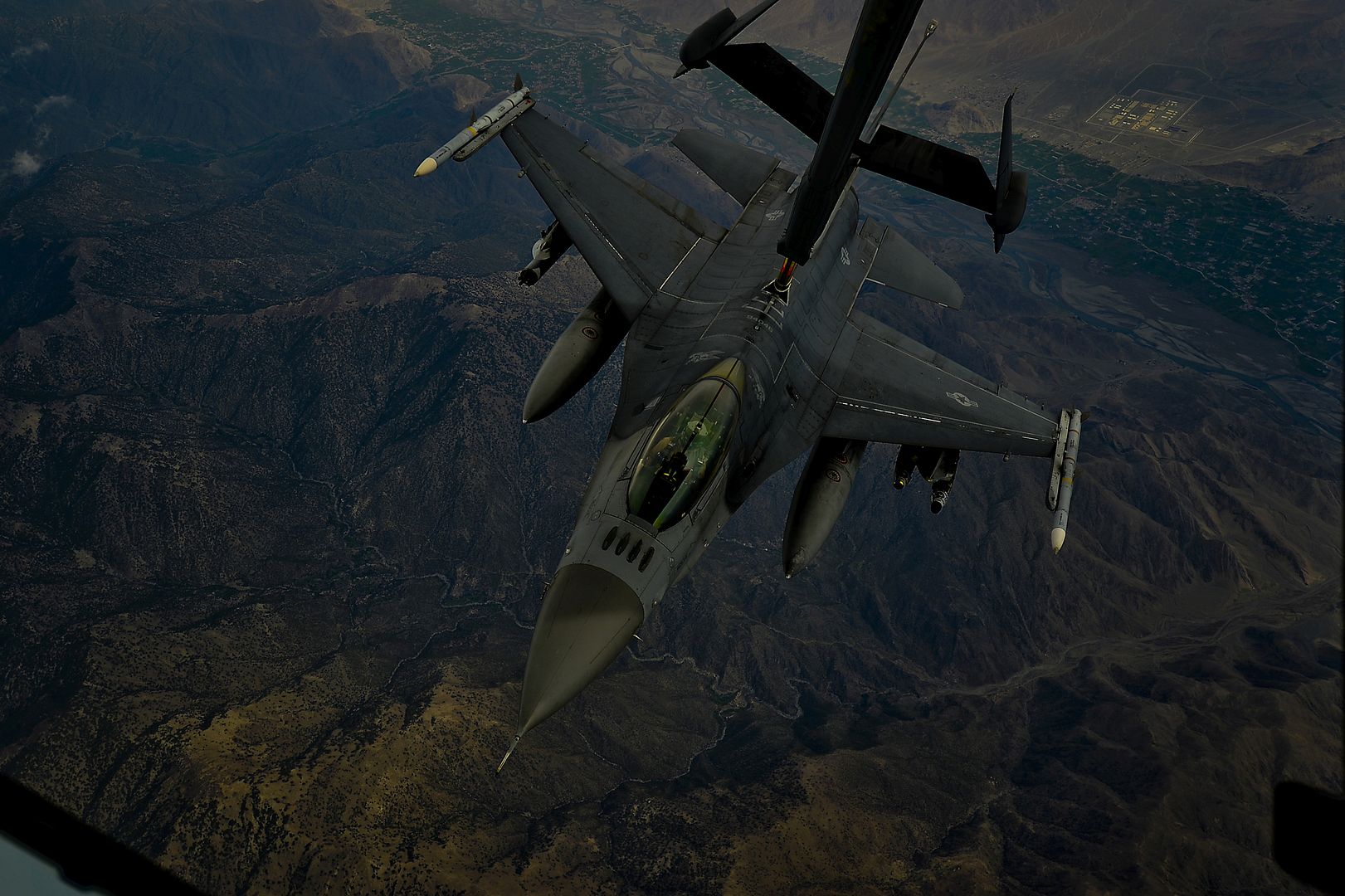
-
 Main AdminEAST CHINA SEA (March 11, 2018) Sailors move an F-35B into the hangar bay of the amphibious assault ship USS Wasp (LHD 1). The Wasp Expeditionary Strike Group is conducting a regional patrol meant to strengthen regional alliances, provide rapid-response capability, and advance the Up-Gunned ESG Concept. (U.S. Navy photo's by Mass Communication Specialist 2nd Class Desmond Parks/released)
Main AdminEAST CHINA SEA (March 11, 2018) Sailors move an F-35B into the hangar bay of the amphibious assault ship USS Wasp (LHD 1). The Wasp Expeditionary Strike Group is conducting a regional patrol meant to strengthen regional alliances, provide rapid-response capability, and advance the Up-Gunned ESG Concept. (U.S. Navy photo's by Mass Communication Specialist 2nd Class Desmond Parks/released)

ARABIAN GULF (March. 11, 2018) An E/A-18G Growler, assigned to the Cougars of Electronic Attack Squadron (VAQ) 139, lands on the flight deck of the aircraft carrier USS Theodore Roosevelt (CVN 71). Theodore Roosevelt and its carrier strike group are deployed to the U.S. 5th Fleet area of operations in support of maritime security operations to reassure allies and partners and preserve the freedom of navigation and the free flow of commerce in the region. (U.S. Navy photo by Mass Communication Specialist 3rd Class Alex Perlman/Released)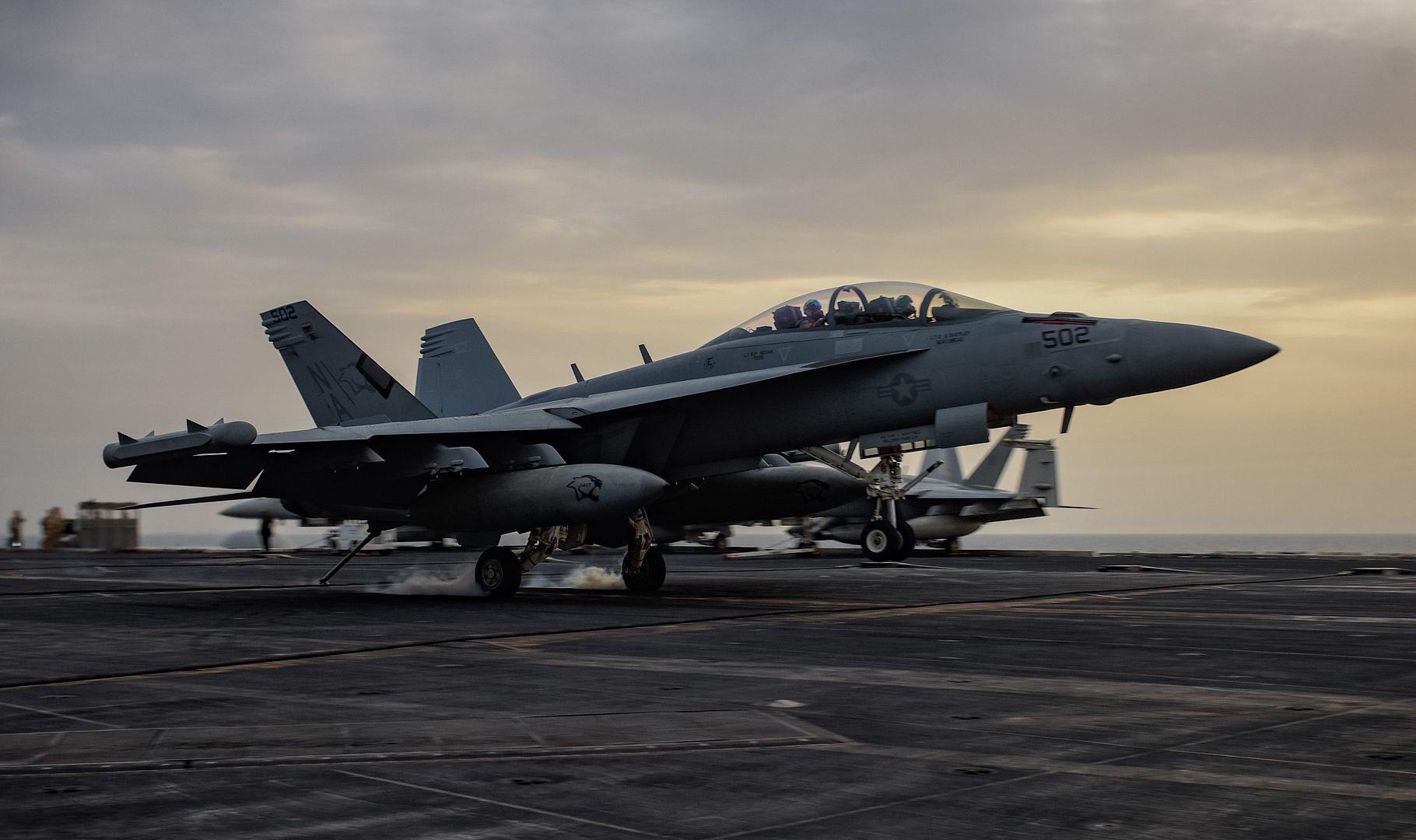
ARABIAN GULF (March 11, 2018) An F/A-18F Super Hornet, assigned to the Fighting Redcocks of Strike Fighter Attack Squadron (VFA) 22, prepares to land on the flight deck of the aircraft carrier USS Theodore Roosevelt (CVN 71). Theodore Roosevelt and its carrier strike group are deployed to the U.S. 5th Fleet area of operations in support of maritime security operations to reassure allies and partners and preserve the freedom of navigation and the free flow of commerce in the region. (U.S. Navy photo by Mass Communication Specialist 3rd Class Alex Corona/Released)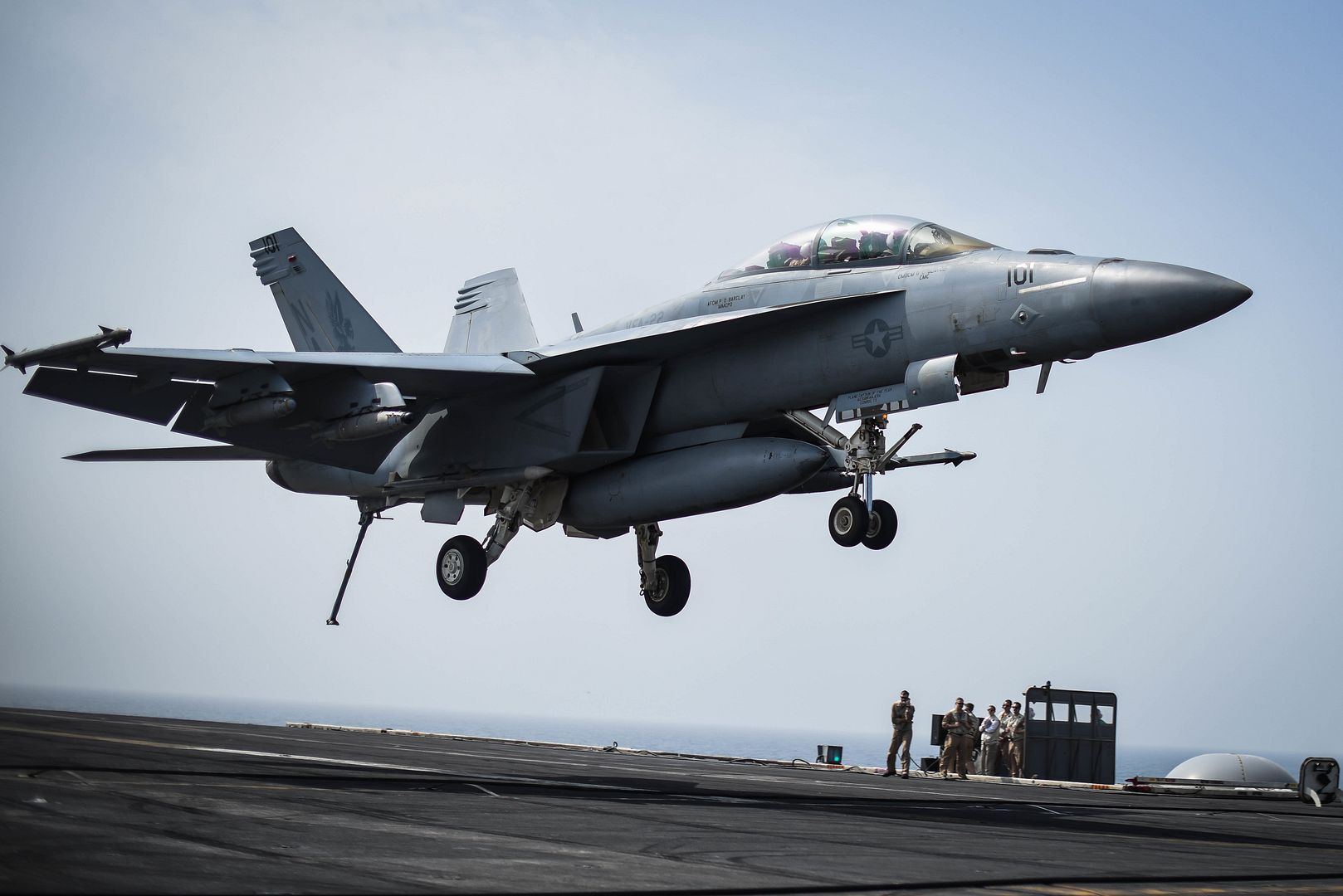
ARABIAN GULF (March. 11, 2018) An F/A-18C Hornet, assigned to the Checkerboards of Marine Strike Fighter Attack Squadron (VMFA) 312, launches from the flight deck of the aircraft carrier USS Theodore Roosevelt (CVN 71). Theodore Roosevelt and its carrier strike group are deployed to the U.S. 5th Fleet area of operations in support of maritime security operations to reassure allies and partners and preserve the freedom of navigation and the free flow of commerce in the region. (U.S. Navy photo by Mass Communication Specialist 3rd Class Alex Perlman/Released)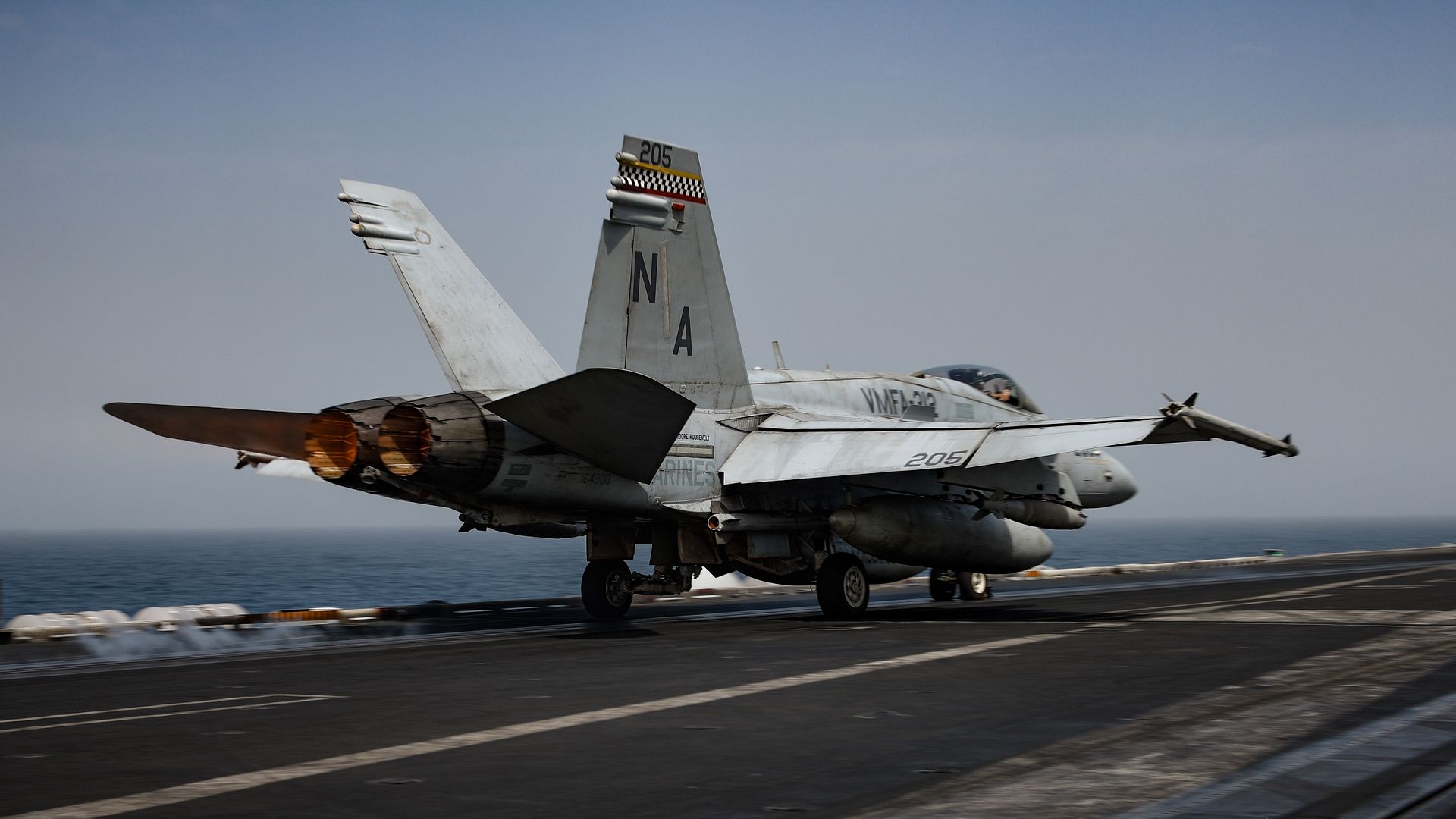
ARABIAN GULF (March. 11, 2018) An E/A-18G Growler, assigned to the Cougars of Electronic Attack Squadron (VAQ) 139, launches from the flight deck of the aircraft carrier USS Theodore Roosevelt (CVN 71). Theodore Roosevelt and its carrier strike group are deployed to the U.S. 5th Fleet area of operations in support of maritime security operations to reassure allies and partners and preserve the freedom of navigation and the free flow of commerce in the region. (U.S. Navy photo by Mass Communication Specialist 3rd Class Alex Perlman/Released)
ARABIAN GULF (March. 11, 2018) An F/A-18F Super Hornet, assigned to the Mighty Shrikes of Strike Fighter Attack Squadron (VFA) 94, readies to launch from the flight deck of the aircraft carrier USS Theodore Roosevelt (CVN 71). Theodore Roosevelt and its carrier strike group are deployed to the U.S. 5th Fleet area of operations in support of maritime security operations to reassure allies and partners and preserve the freedom of navigation and the free flow of commerce in the region. (U.S. Navy photo by Mass Communication Specialist 3rd Class Alex Perlman/Released)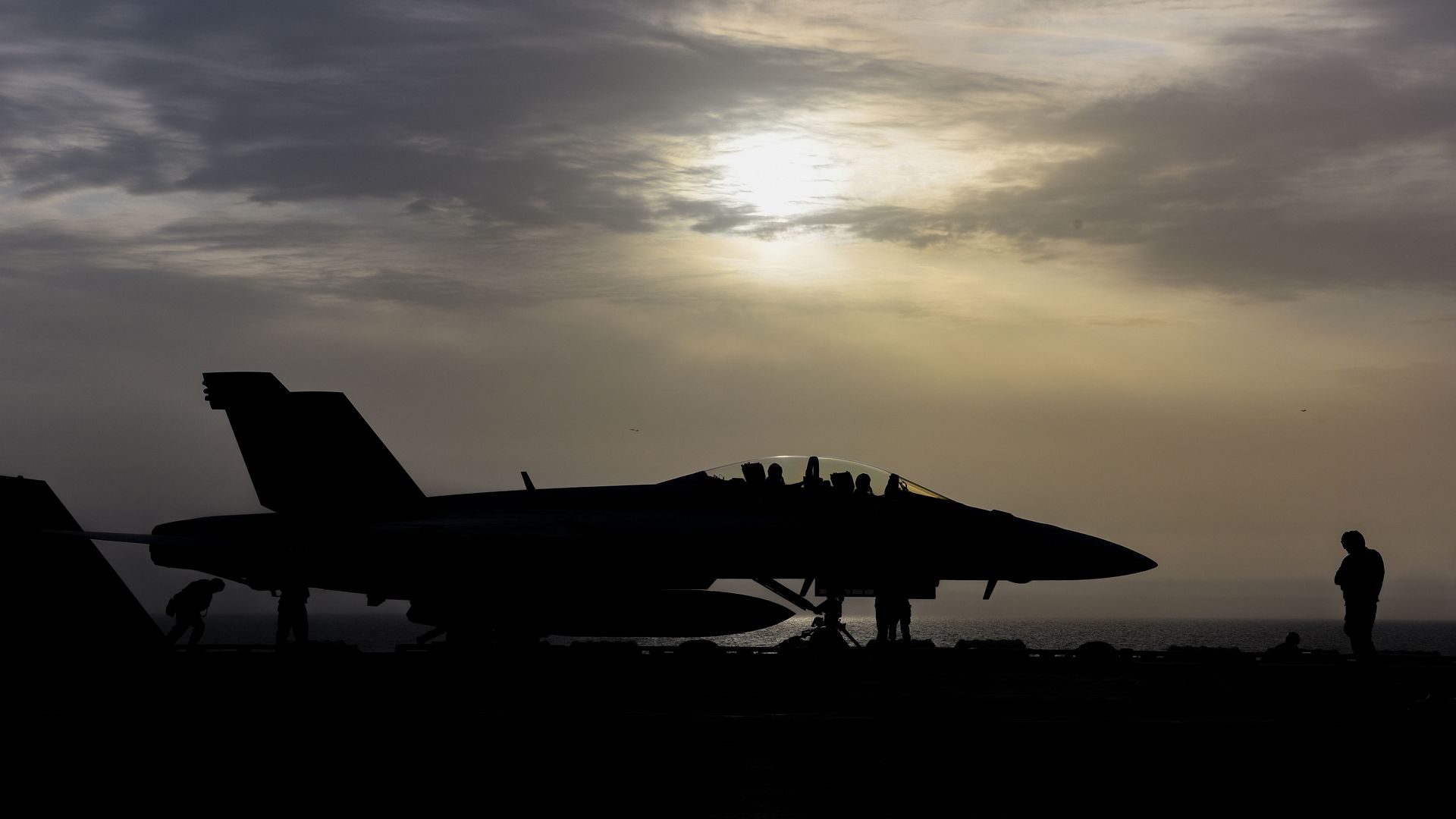
SEATTLE, March 12, 2018 /PRNewswire/ -- Boeing [NYSE:BA] and Turkish Airlines announced they have finalized a firm order for 25 787-9 Dreamliners with options for five more airplanes. The firm order will allow Turkey's flag carrier to further meet the growing demand at its home airport, Istanbul's third airport, and improve the flying experience for passengers.
Boeing [NYSE:BA] and Turkish Airlines announced they have finalized a firm order for 25 787-9 Dreamliners with options for five more airplanes. This rendering shows the airplane in Turkish Airlines livery. (Boeing illustration)
With this firm order ? first announced as a commitment last September ? Turkish Airlines becomes the 71st customer to buy the 787. Together, these customers have now ordered more than 1,300 Dreamliners, the fastest-selling twin-aisle airplane in Boeing history.
"We are pleased to finalize a landmark agreement that will bring significant benefit to Turkish Airlines and Turkey's aviation industry," said M. ?lker Ayc?, Turkish Airlines Chairman of the Board and the Executive Committee. "This firm order adds the 787 Dreamliner, one of the world's most state-of-the-art airplanes, to our ever-expanding fleet in 2023, our Republic's 100th year. The 787 will significantly raise our passengers' satisfaction and play an important role in our plans for our new hub, the new Istanbul airport. This will accelerate the steady rise of our country's flag carrier and support the growth of Turkish Civil Aviation."
Turkish Airlines has continued to expand its fleet of Boeing airplanes. Recently, the airline grew its stable of 777 jets with a purchase of three more 777 Freighters. The airline also uses electronic charts and some other services from Boeing Global Services to further optimize its operations and operational systems.
"We are proud to extend our decades-long partnership with Turkish Airlines and we welcome them to the growing group of elite airlines who have made the 787 Dreamliner the most preferred mid-sized twin-aisle airplane today," said Kevin McAllister, Boeing Commercial Airplanes President and Chief Executive Officer. "We are confident that Turkish Airlines will enjoy the Dreamliner's unmatched fuel efficiency, range, and superior cabin features."
About the 787 Dreamliner family
The 787 Dreamliner is an all-new, super-efficient family of commercial airplanes. Since 2011, more than 640 Dreamliners have entered service, flying over 226 million people on more than 680 unique routes around the world, saving an estimated 22 billion pounds of fuel.
At 20 feet (6 meters) longer than the 787-8, the 787-9 extends the family in capacity and range, flying more passengers and more cargo farther. The airplane can fly 290 passengers, in a typical two-class configuration, up to 7,635 nautical miles (14,140 km).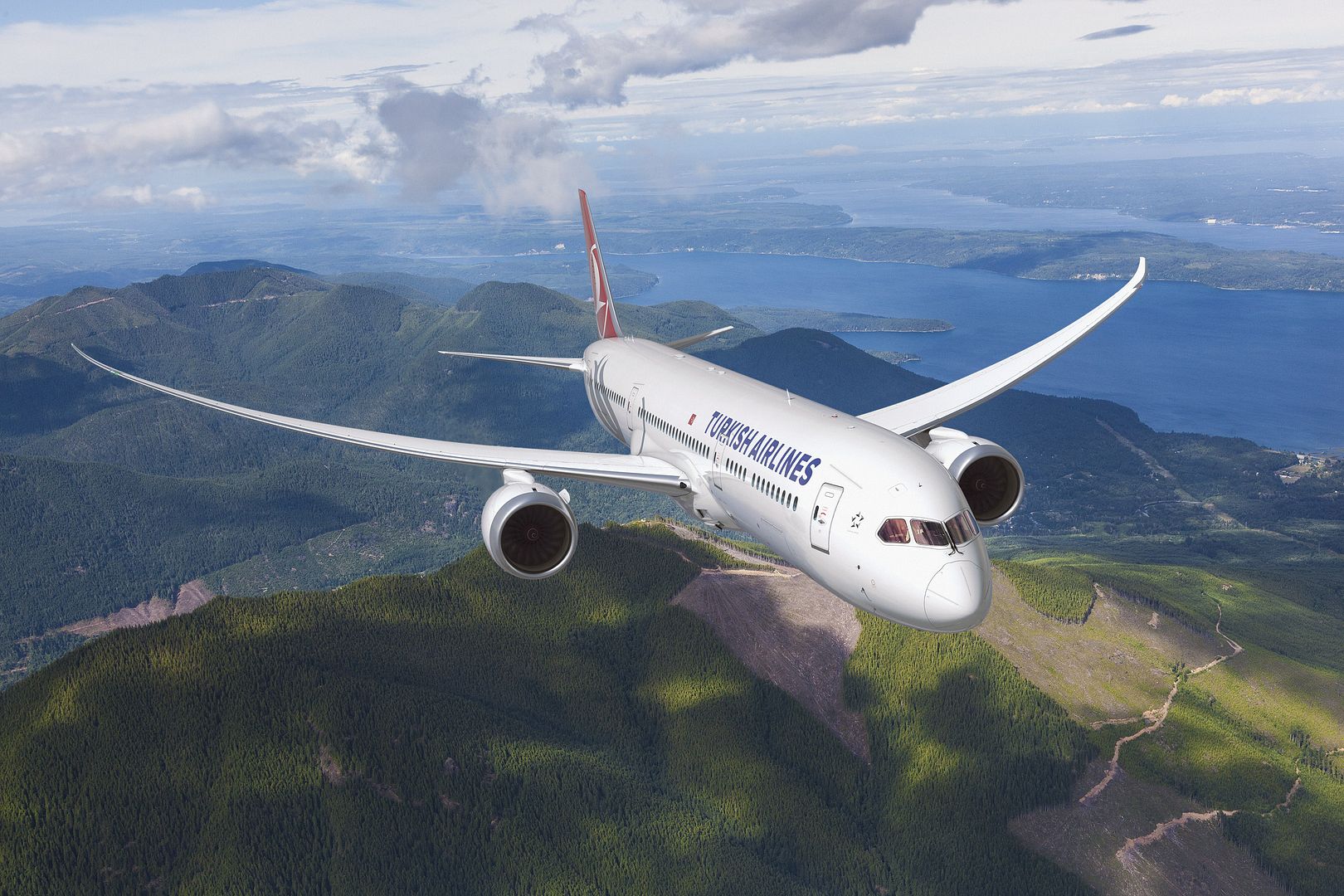
About Turkish Airlines
Based in Istanbul, Turkish Airlines carries over 60 million passengers a year, with direct flights to 301 destinations in 121 countries. The airline made its first domestic flight in 1933 and the first international flight in 1947. Turkish Airlines was founded in 1933 with a fleet of five airplanes that carried a total of 28 passengers, expanding to 328 aircraft today.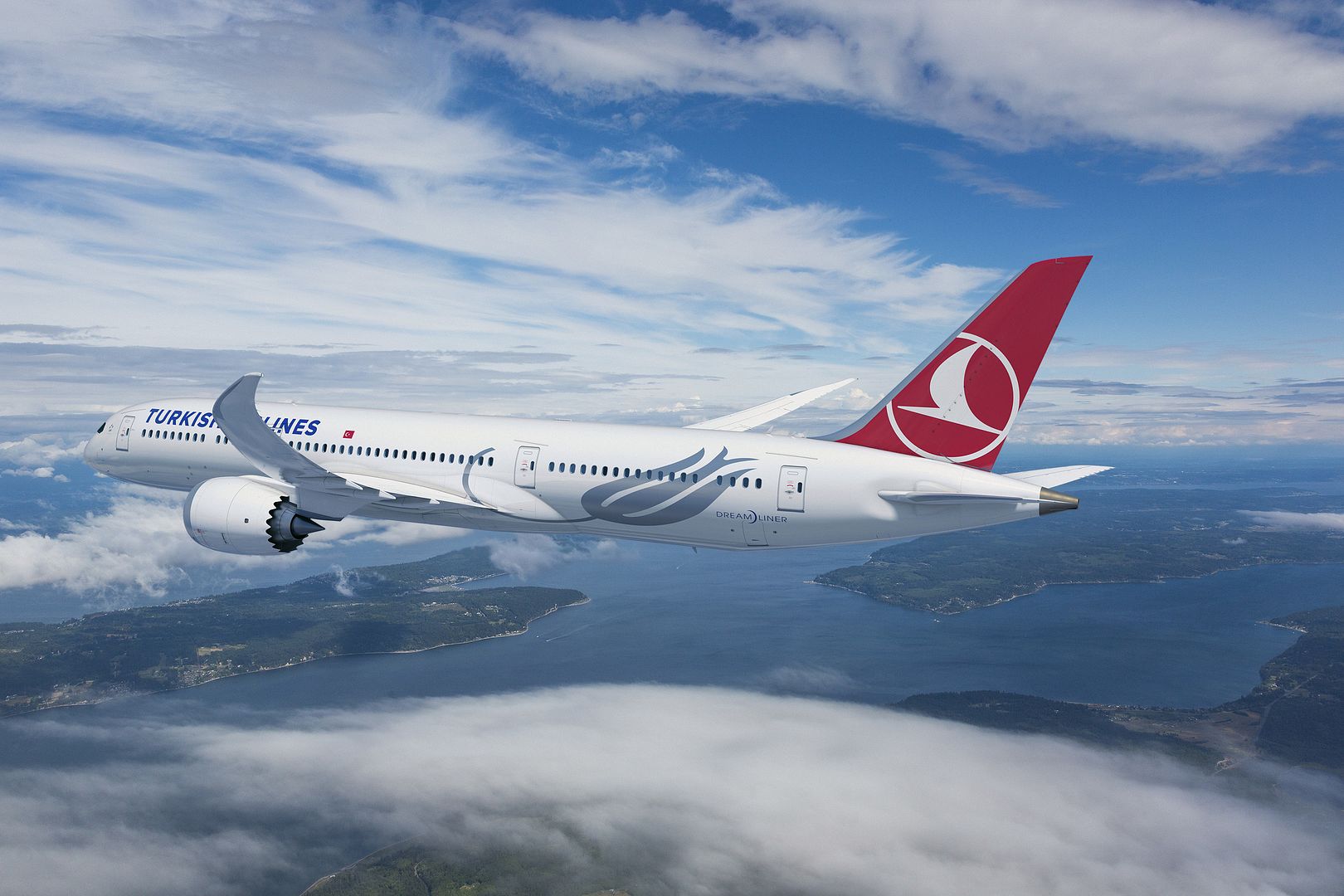
-
 Main AdminAn Indonesian air force F-16 Fighting Falcon prepares to takeoff during exercise Cope West 18 (CW18) from Sam Ratulangi International Airport, Indonesia, March 12, 2018. CW18 is a Pacific Air Forces-sponsored, bilateral, tactical fighter aircraft exercise involving the U.S. and Indonesian air forces and is designed to advance interoperability and build upon already established partnerships between the air forces. (U.S. Air Force photo's by Tech. Sgt. Richard Ebensberger)
Main AdminAn Indonesian air force F-16 Fighting Falcon prepares to takeoff during exercise Cope West 18 (CW18) from Sam Ratulangi International Airport, Indonesia, March 12, 2018. CW18 is a Pacific Air Forces-sponsored, bilateral, tactical fighter aircraft exercise involving the U.S. and Indonesian air forces and is designed to advance interoperability and build upon already established partnerships between the air forces. (U.S. Air Force photo's by Tech. Sgt. Richard Ebensberger)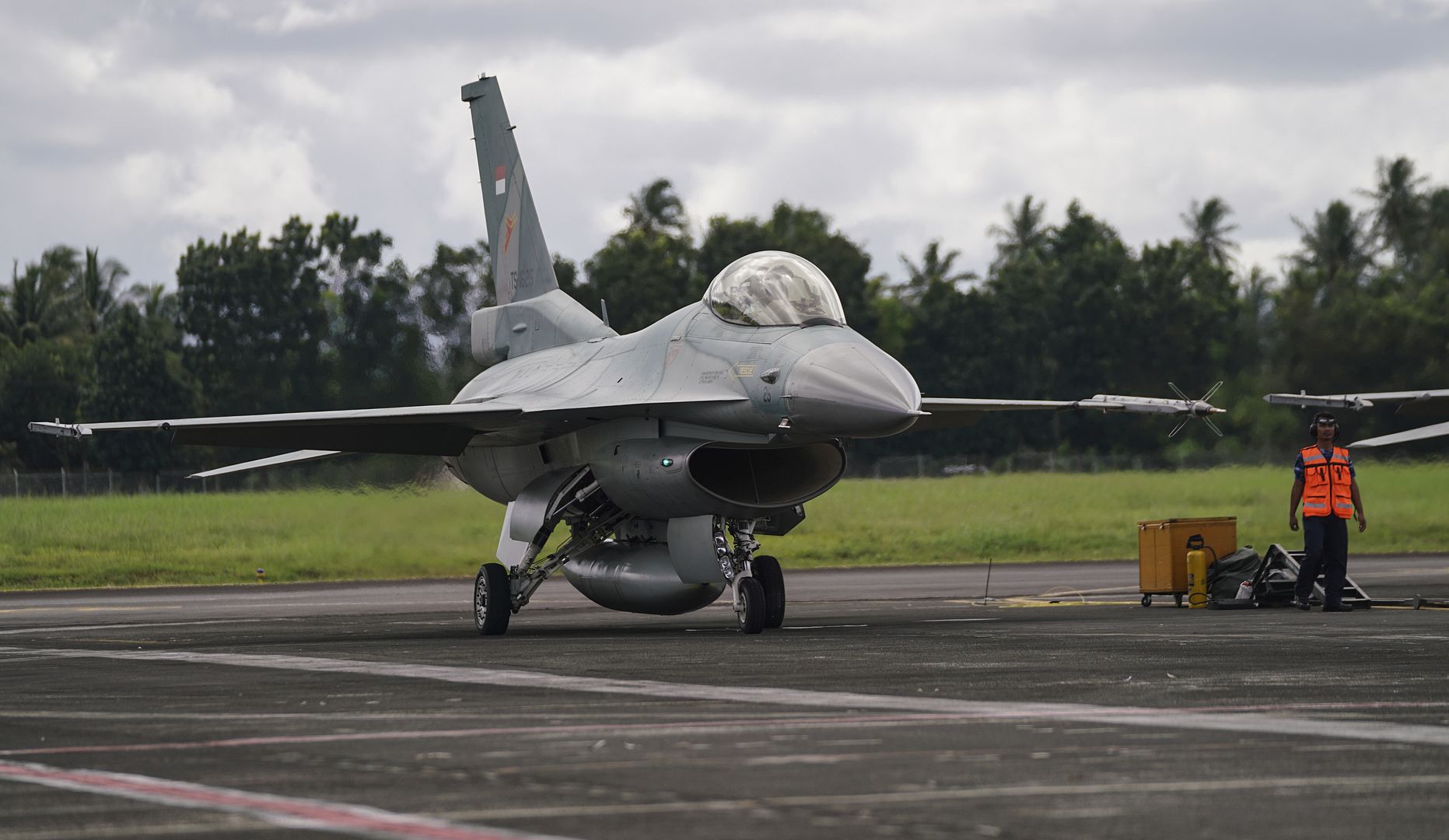
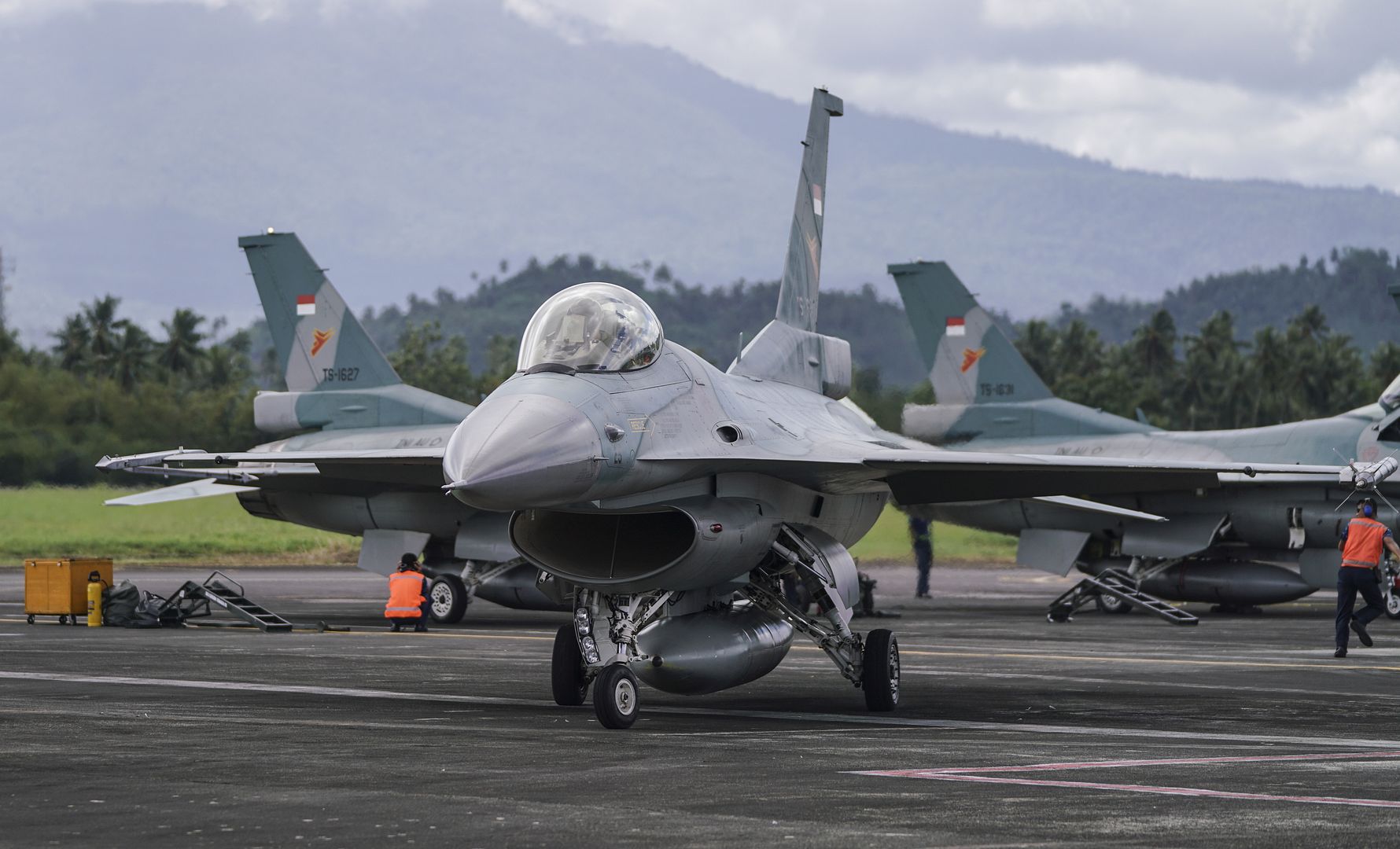
U.S. Air Force F-16C Fighting Falcons assigned to the 13th Expeditionary Fighter Squadron, 35th Fighter Wing based out of Misawa Air Base, Japan prepare to takeoff during exercise Cope West 18 (CW18) from Sam Ratulangi International Airport, Indonesia, March 12, 2018. CW18 is a Pacific Air Forces-sponsored, bilateral, tactical fighter aircraft exercise involving the U.S. and Indonesian air forces and is designed to advance interoperability and build upon already established partnerships between the air forces. (U.S. Air Force photo by Tech. Sgt. Richard Ebensberger)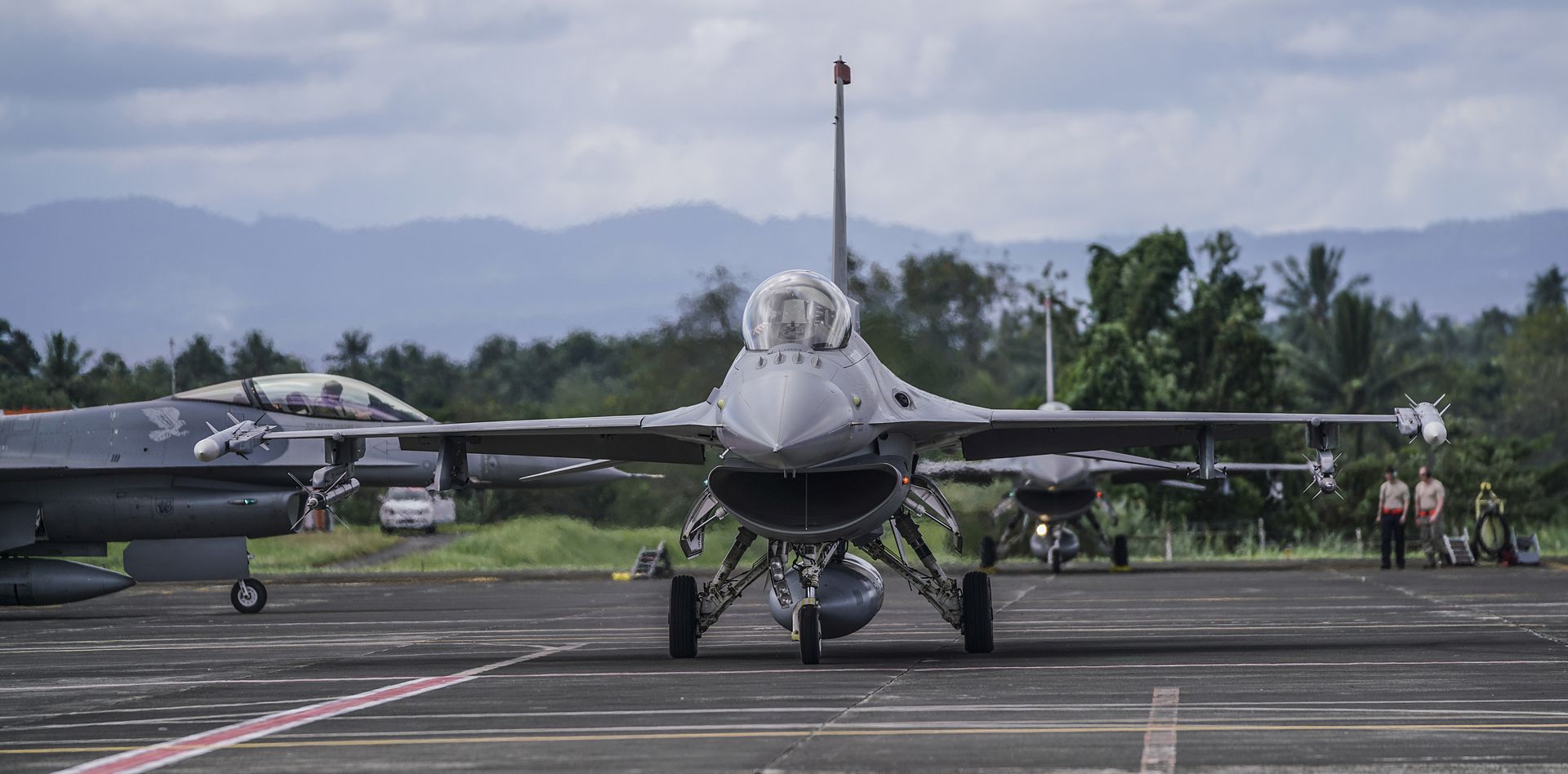
ARABIAN GULF (March. 12, 2018) E/A-18G Growler's, assigned to the Cougars of Electronic Attack Squadron (VAQ) 139, land on the flight deck of the aircraft carrier USS Theodore Roosevelt (CVN 71). Theodore Roosevelt and its carrier strike group are deployed to the U.S. 5th Fleet area of operations in support of maritime security operations to reassure allies and partners and preserve the freedom of navigation and the free flow of commerce in the region. (U.S. Navy photo's by Mass Communication Specialist 3rd Class Alex Perlman/Released)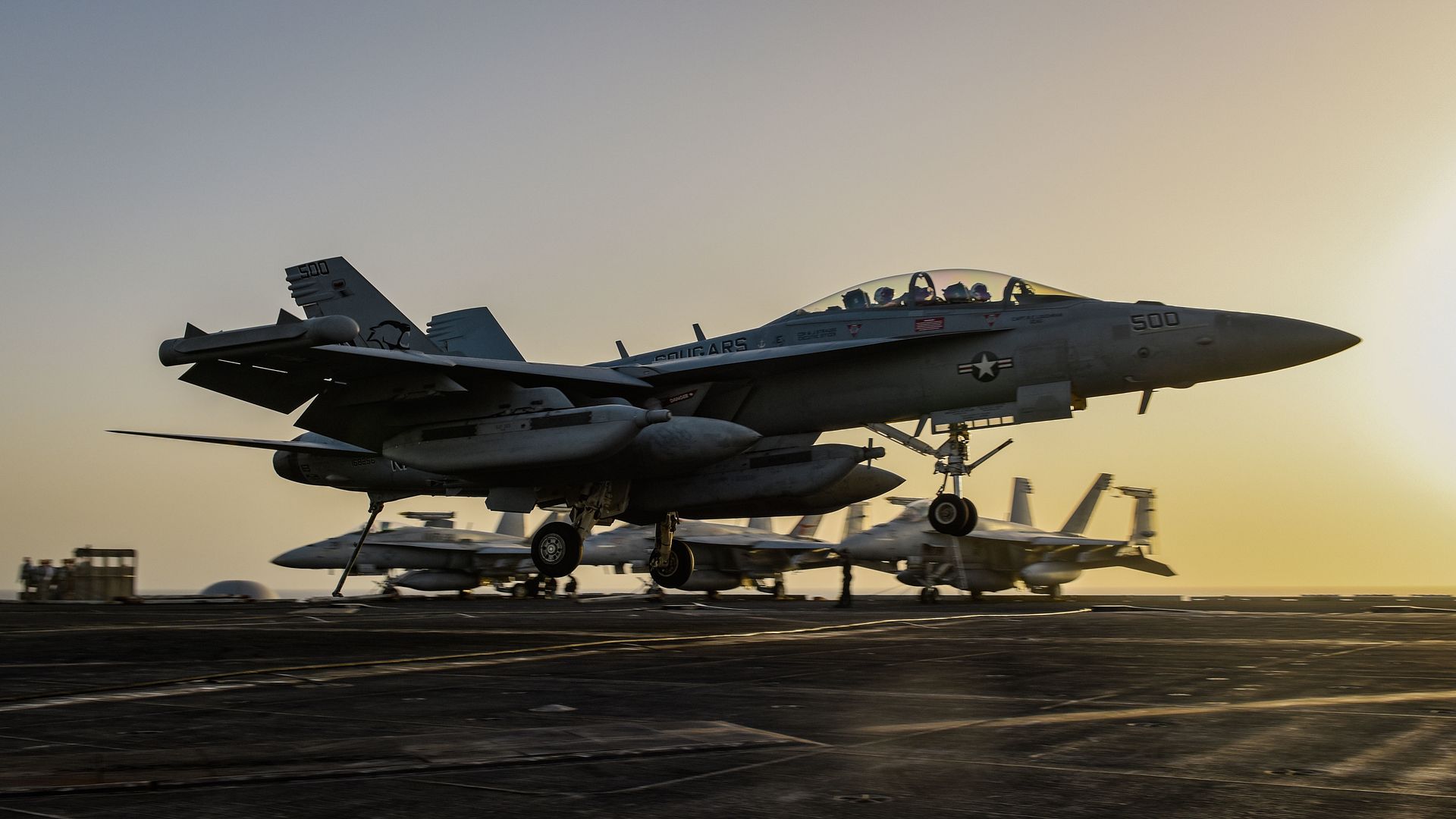
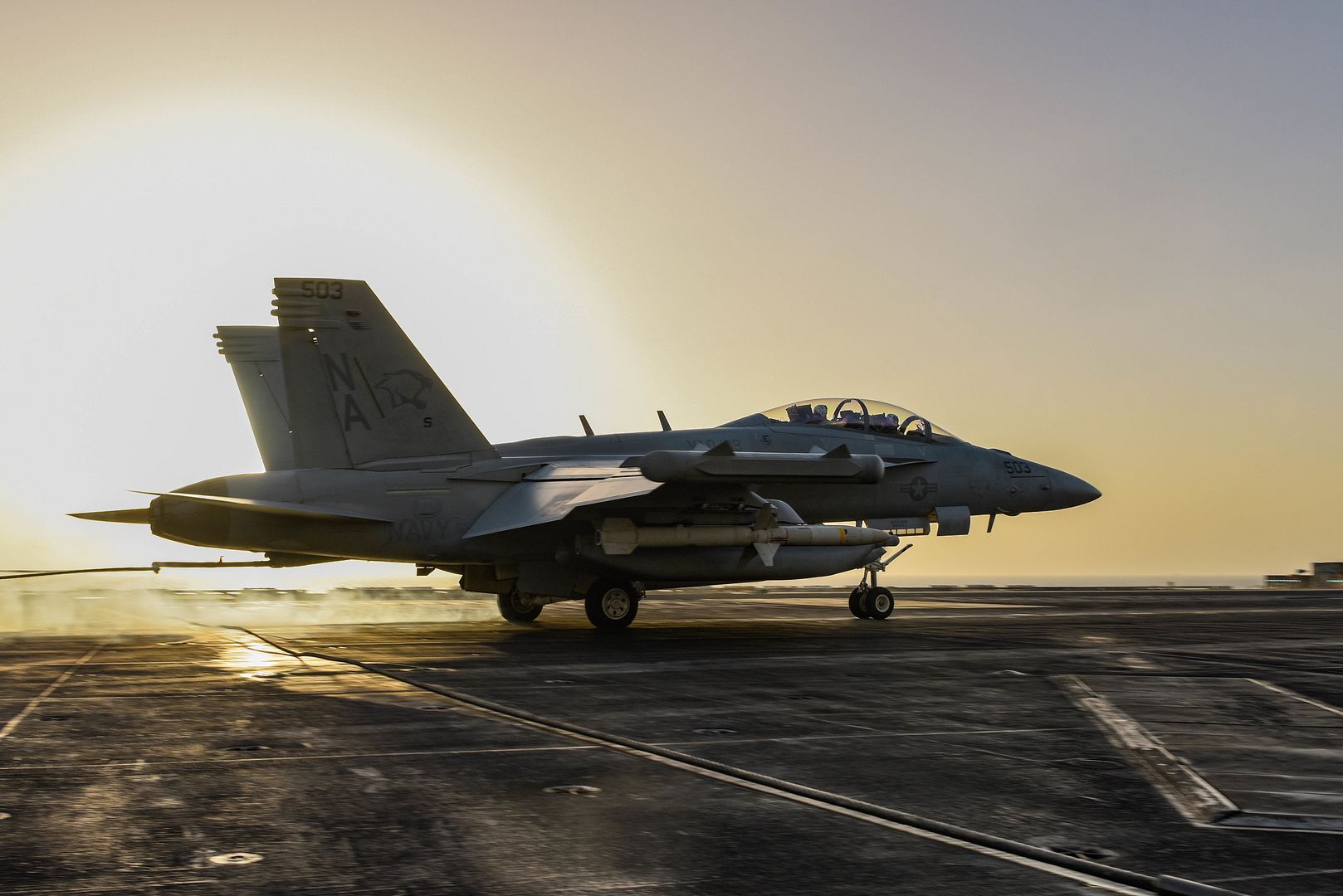
PACIFIC OCEAN (March 7, 2018) An MH-60S Seahawk helicopter assigned to the ?Blackjacks? of Helicopter Sea Combat Squadron (HSC) 21 takes off from the flight deck of the Wasp-class amphibious assault ship USS Essex (LHD 2). Essex Amphibious Ready Group (ARG) is completing the Navy?s first full-length ARG Surface Warfare Advanced Tactical Training (SWATT) exercise. SWATT is led by the Naval Surface and Mine Warfighting Development Center (SMWDC) and is designed to increase warfighting proficiency, lethality, and interoperability of participating units. (U.S. Navy photo by Mass Communication Specialist Seaman Sabyn L. Marrs/Released)
A U.S. Army Chinook CH-47 lands in Fort Greely, AK, to transport U.S. Marines with Kilo Company, 3rd Battalion, 8th Marine Regiment, 2nd Marine Division, as part of their combined mission on the Indian Mountain Air Force Station, AK, March 12, 2018. Arctic Edge 2018 is a biennial, large-scale, joint training exercise that prepares and tests the U.S. military's capabilities in Arctic environments. (U.S. Marine Corps photo by Cpl. Bethanie Ryan)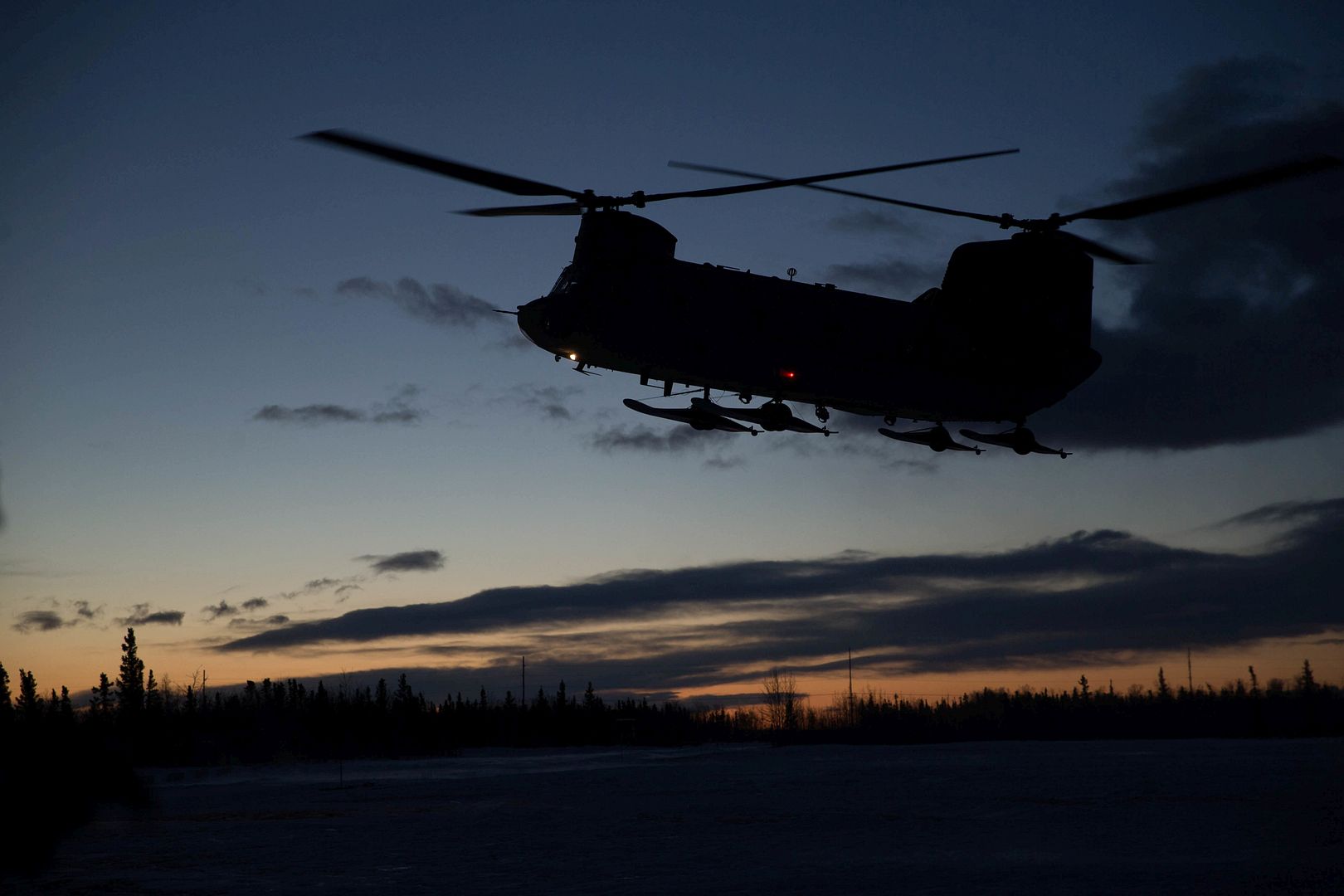
RENTON, Wash., March 13, 2018 /PRNewswire/ -- Thousands of Boeing (NYSE: BA) employees gathered at the company's Renton, Wash. factory today to celebrate the 10,000th 737 to come off the production line. With this airplane, a 737 MAX 8 for Southwest Airlines, the 737 has broken the GUINNESS WORLD RECORDS title for the most produced commercial jet aircraft model.
Thousands of Boeing employees at the Renton, Wash. factory celebrated the 10,000th 737 to come off the production line. The milestone was recognized by GUINNESS WORLD RECORDS(tm).
"This incredible milestone is a testament to the work we do every day to build the most reliable and efficient single-aisle airplane in the world," said Boeing Commercial Airplanes president and CEO Kevin McAllister. "It represents more than 50 years of success and achievement on the part of thousands of Boeing employees past and present, our supplier partners, and our airline customers around the globe who put their confidence in the 737."
The 737 previously held this GUINNESS WORLD RECORDS title in 2006 for the 5,000th airplane to come out of the Renton factory, a mark that took almost four decades to reach. Due to growing market demand and higher production rates, the 737 program reached the 10,000th airplane milestone only 12 years later.
"The speed at which Boeing achieved this new milestone is very impressive," said Michael Empric, official adjudicator for GUINNESS WORLD RECORDS. "We are excited to once again recognize the 737 and the important role it plays in commercial aviation."
Boeing will increase 737 production from the current rate of 47 airplanes per month to 52 airplanes per month later this year. The 737 program has more than 4,600 airplanes still on order fueled by sales of the newest version of the 737, the 737 MAX.
737 Facts
A 737 takes off or lands every 1.5 seconds
On average, more than 2,800 737s are in the air at any given time
More than 22 billion people have flown on a 737
The 737 has flown more than 122 billion miles, the equivalent of 5 million times around Earth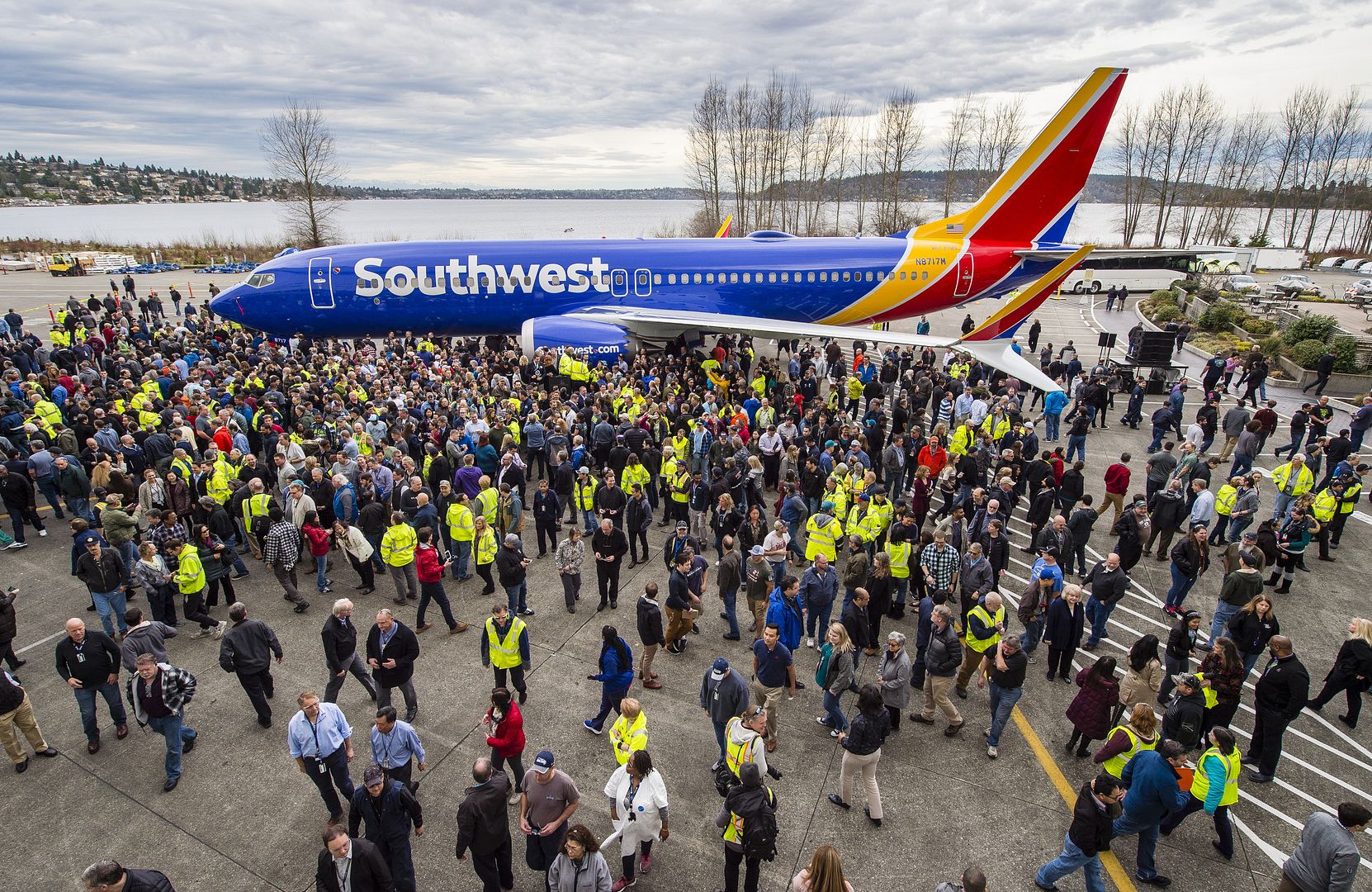
A small team of RAF personnel are preparing the way for the introduction into service of the UK?s new remotely piloted air system, the MQ-9B Protector.
The Protector Combined Test Team comprises experienced pilots, sensor operators and engineers from the RAF, industry partners and the United States Air Force who are coordinating the testing and evaluation of the Protector system.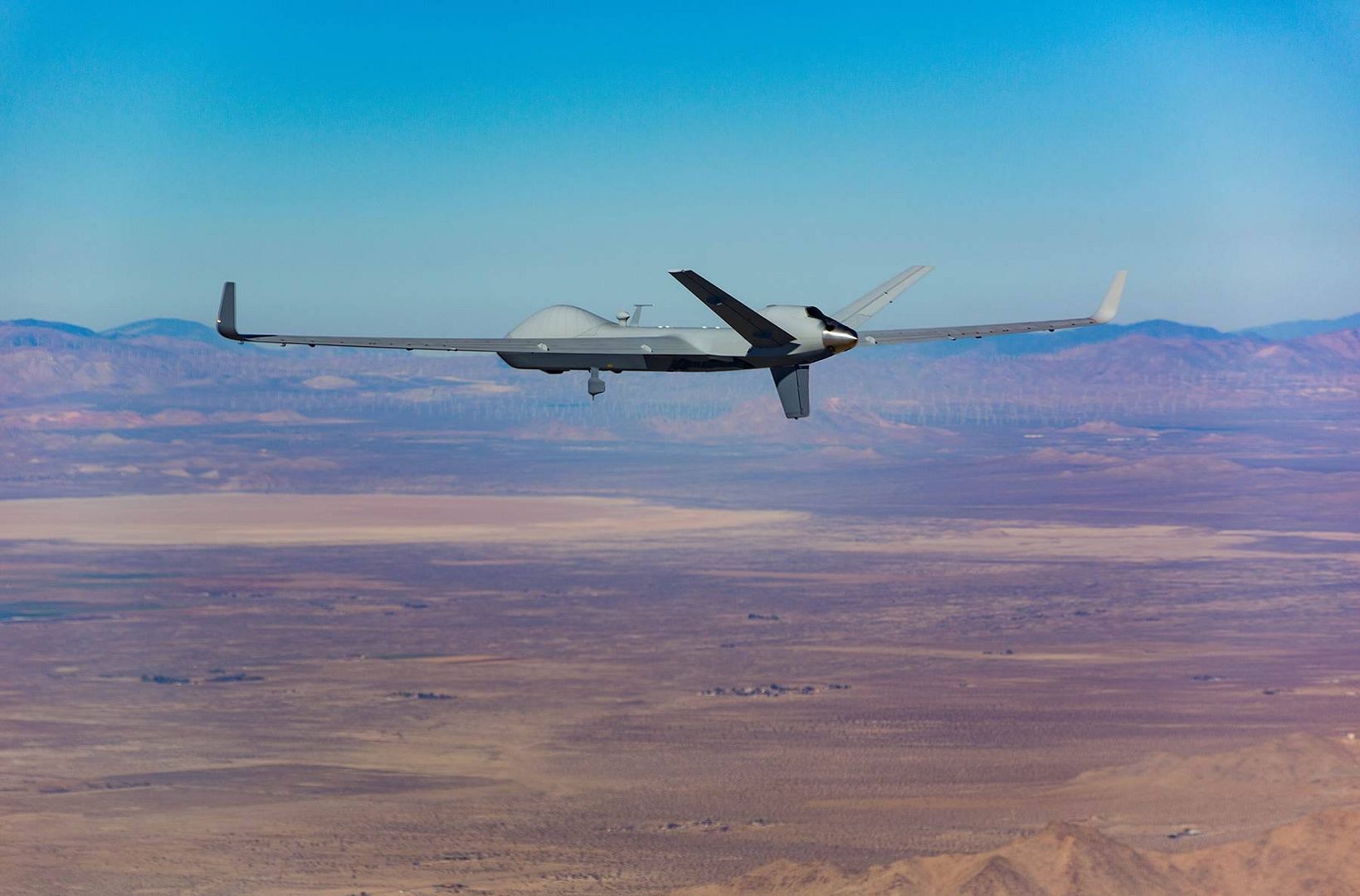
The UK is investing in an initial 16 Protector aircraft which will replace the MQ-9 Reaper in RAF service.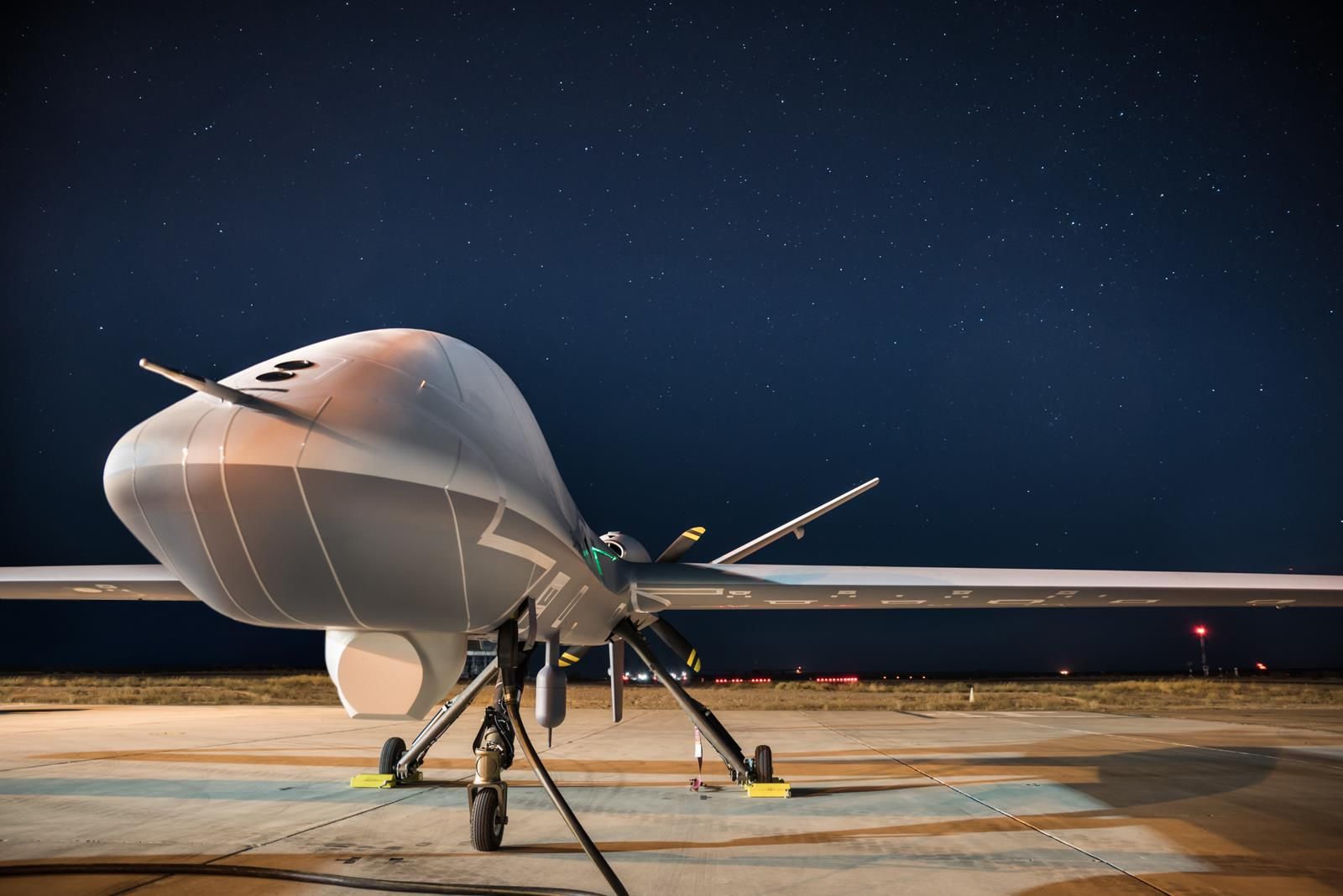
-
 Main AdminA U.S. Air Force F-16C Fighting Falcon with the 177th Fighter Wing, New Jersey Air National Guard, lands at the Air Dominance Center in Savannah, Georgia, March 12, 2018. The 177th FW participated in an air-to-air training exercise to sharpen air combat capabilities and accomplish multiple training upgrades. (U.S. Air National Guard photo's by Senior Airman Cristina J. Allen)
Main AdminA U.S. Air Force F-16C Fighting Falcon with the 177th Fighter Wing, New Jersey Air National Guard, lands at the Air Dominance Center in Savannah, Georgia, March 12, 2018. The 177th FW participated in an air-to-air training exercise to sharpen air combat capabilities and accomplish multiple training upgrades. (U.S. Air National Guard photo's by Senior Airman Cristina J. Allen)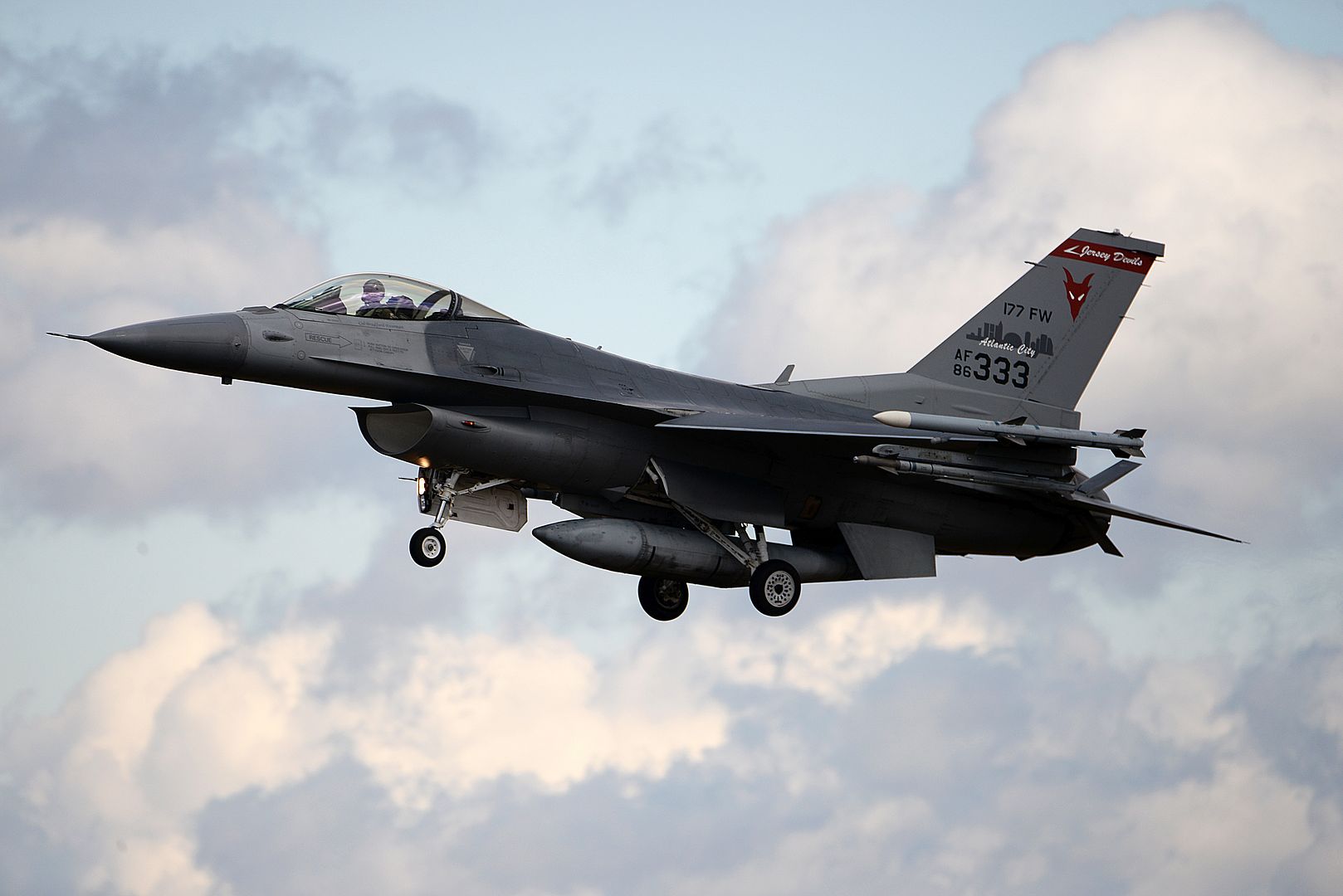

An Afghan Air Force A-29 taxis to a parking spot March 6, 2018, Kabul Air Wing, Afghanistan. The A-29 was selected by the AAF because of the adaptability, payload and ease of training. (U.S. Air Force photo's by Staff Sgt. Jared J. Duhon)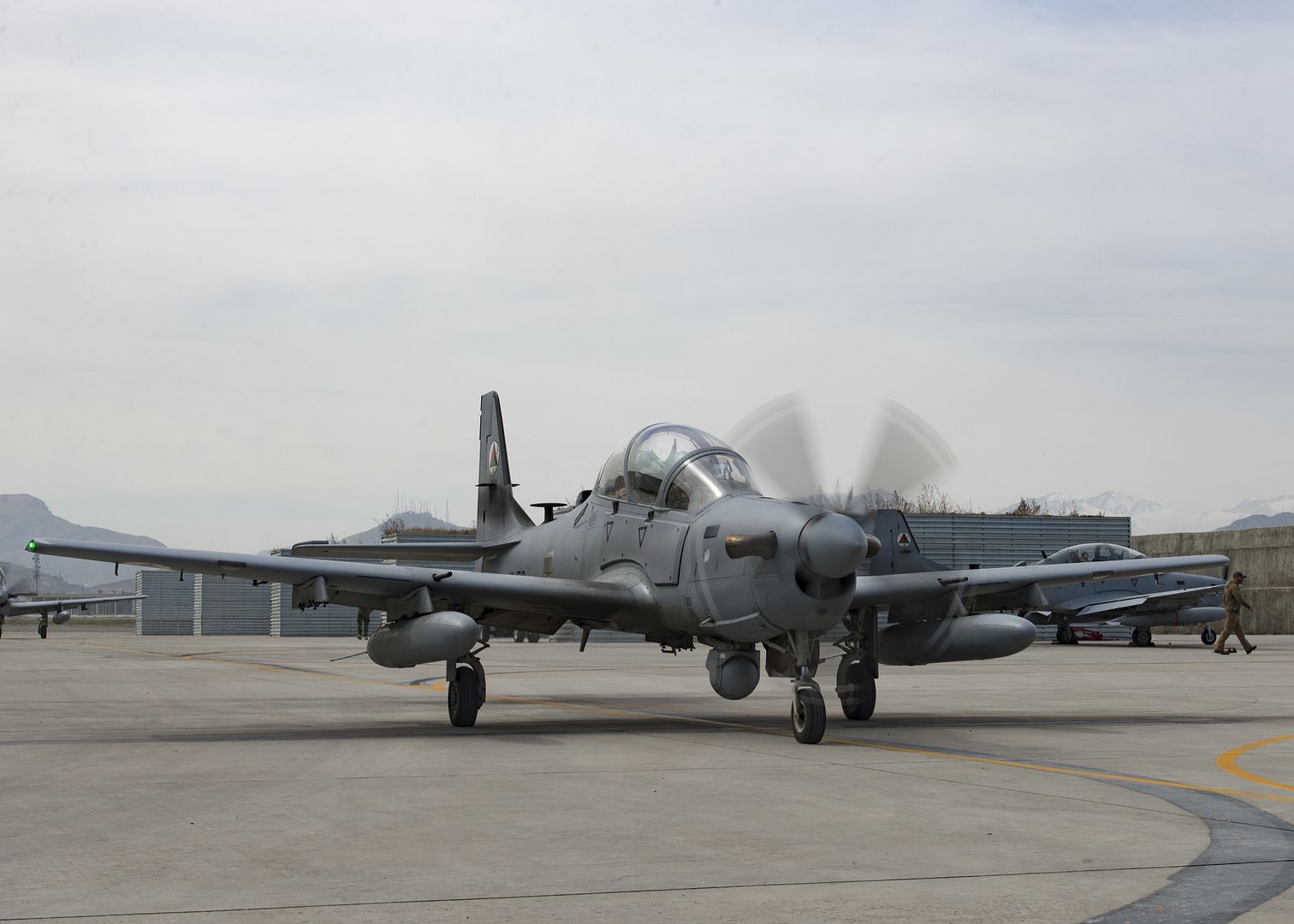
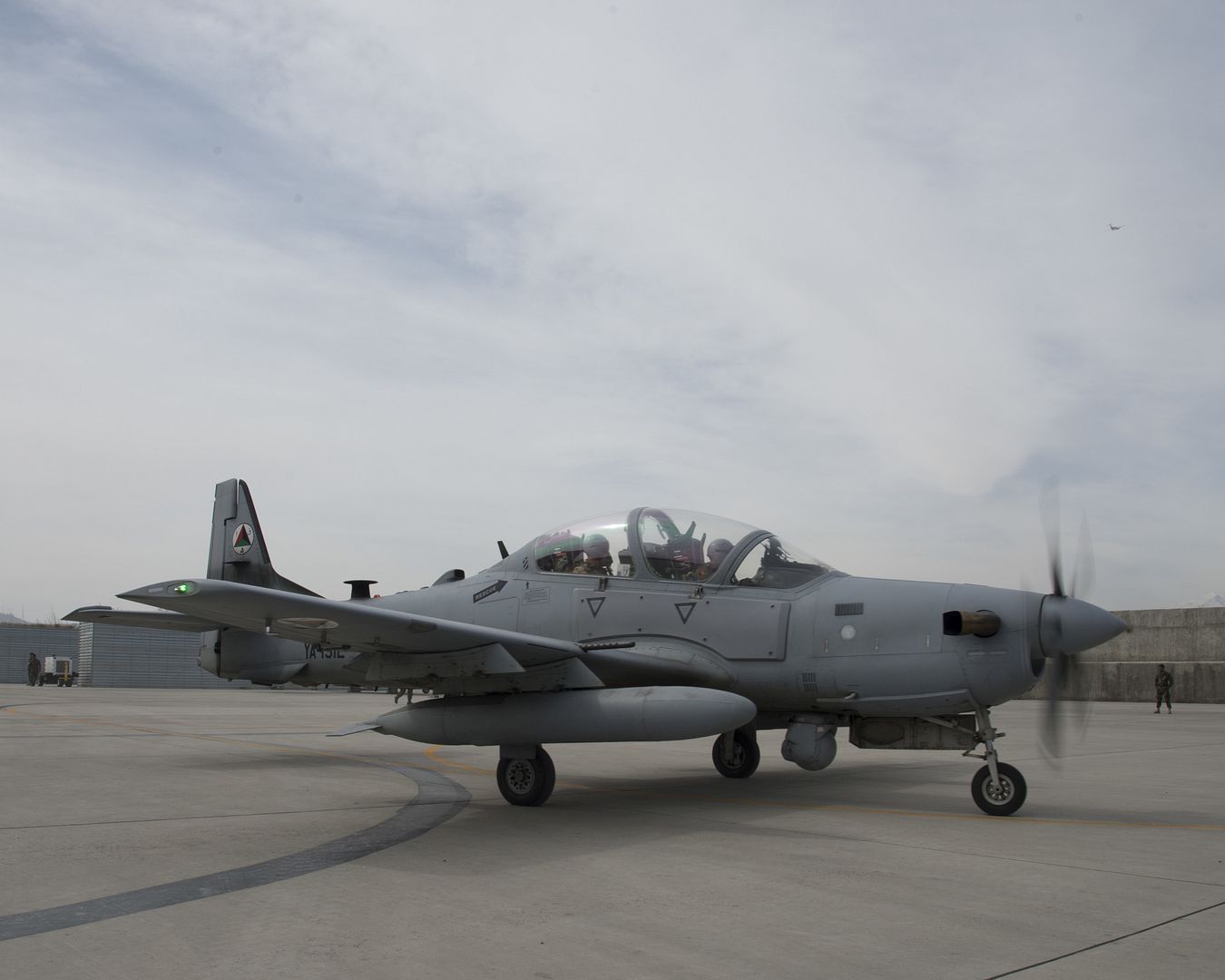
ARABIAN GULF (March 13, 2018) Sailors move an F/A-18E Super Hornet, assigned to the Stingers of Strike Fighter Attack Squadron (VFA) 113, on the flight deck of the aircraft carrier USS Theodore Roosevelt (CVN 71). Theodore Roosevelt and its carrier strike group are deployed to the U.S. 5th Fleet area of operations in support of maritime security operations to reassure allies and partners and preserve the freedom of navigation and the free flow of commerce in the region. (U.S. Navy photo by Mass Communication Specialist 3rd Class Andrew Langholf/Released)
ARABIAN GULF (March 13, 2018) An F/A-18E Super Hornet, assigned to the Stingers of Strike Fighter Attack Squadron (VFA) 113, launches from the flight deck of the aircraft carrier USS Theodore Roosevelt (CVN 71). Theodore Roosevelt and its carrier strike group are deployed to the U.S. 5th Fleet area of operations in support of maritime security operations to reassure allies and partners and preserve the freedom of navigation and the free flow of commerce in the region. (U.S. Navy photo by Mass Communication Specialist 3rd Class Andrew Langholf/Released)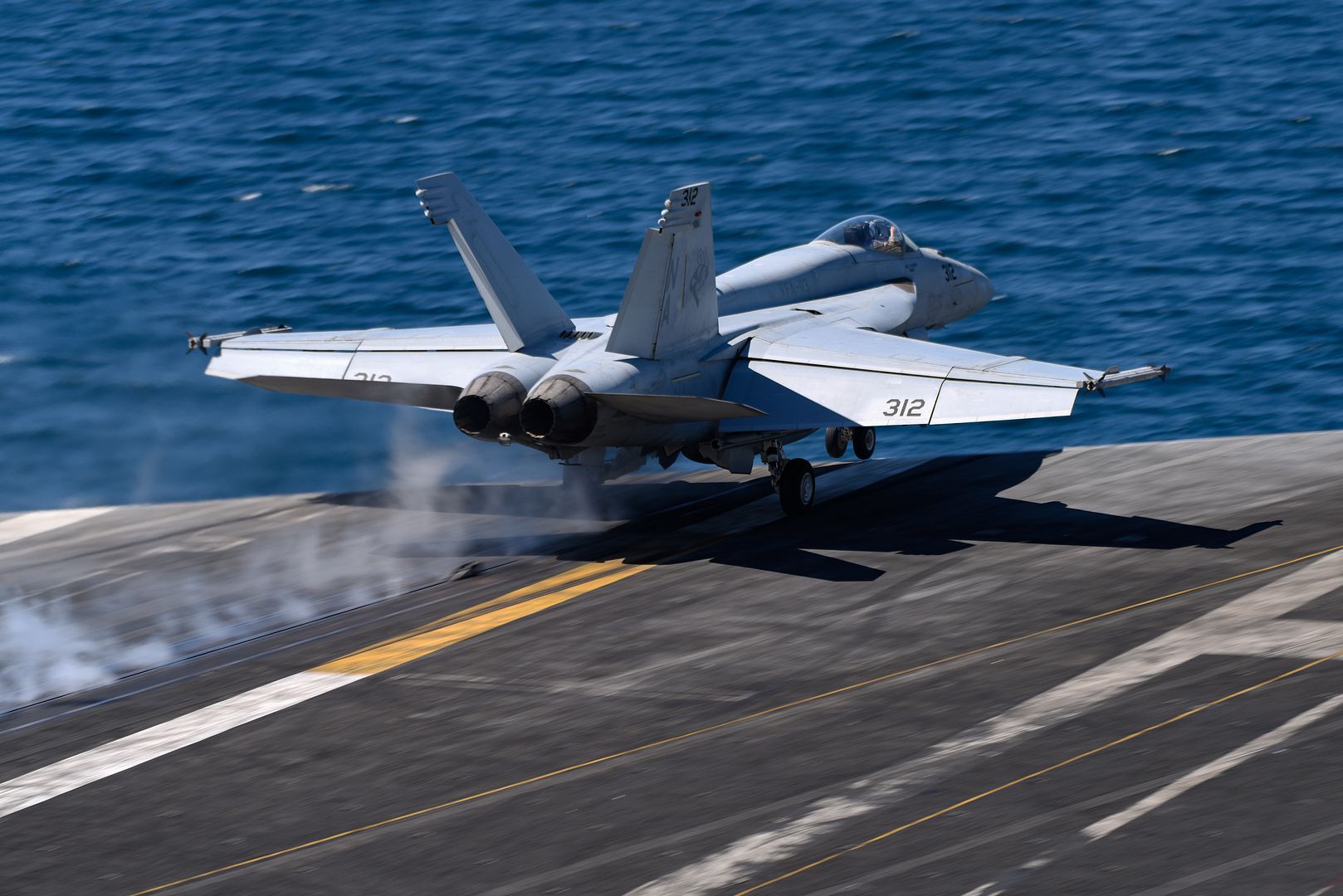
ARABIAN GULF (March 13, 2018) An F/A-18F Super Hornet, assigned to the Fighting Redcocks of Strike Fighter Attack Squadron (VFA) 22, launches from the flight deck of the aircraft carrier USS Theodore Roosevelt (CVN 71). Theodore Roosevelt and its carrier strike group are deployed to the U.S. 5th Fleet area of operations in support of maritime security operations to reassure allies and partners and preserve the freedom of navigation and the free flow of commerce in the region. (U.S. Navy photo by Mass Communication Specialist Seaman Michael A. Colemanberry/Released)
SOUTH CHINA SEA (March 13, 2018) An F/A-18F Super Hornet assigned to the "Bounty Hunters" of Strike Fighter Squadron (VFA) 2 prepares to take off from the Nimitz-class aircraft carrier USS Carl Vinson (CVN 70). The Carl Vinson Carrier Strike Group is operating in the western Pacific as part of a regularly scheduled deployment. (U.S. Navy photo by Mass Communication Specialist 3rd Class Matthew Granito/Released)
-
 Main AdminAn AH-1W Super Cobra completes its final flight on Marine Corps Base Hawaii, March 13, 2018. Marine Light Attack Helicopter squadron is retiring their AH-1Ws, which are being replaced by the AH-1Z Viper helicopters. The first three AH-1Zs arrived to HMLA-367 in December 2017. (U.S. Marine Corps photo's by Sgt. Kathy Nunez)
Main AdminAn AH-1W Super Cobra completes its final flight on Marine Corps Base Hawaii, March 13, 2018. Marine Light Attack Helicopter squadron is retiring their AH-1Ws, which are being replaced by the AH-1Z Viper helicopters. The first three AH-1Zs arrived to HMLA-367 in December 2017. (U.S. Marine Corps photo's by Sgt. Kathy Nunez)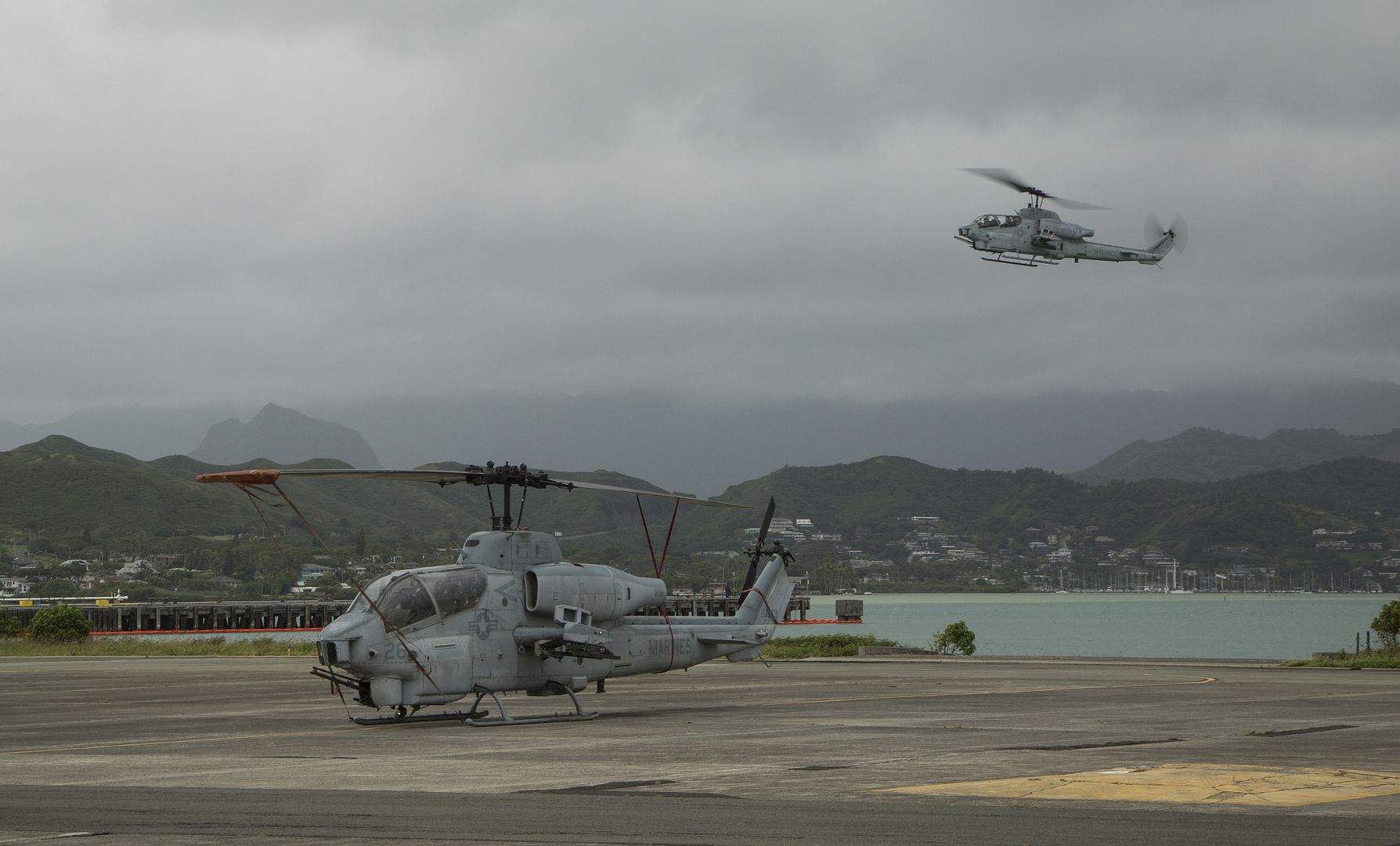
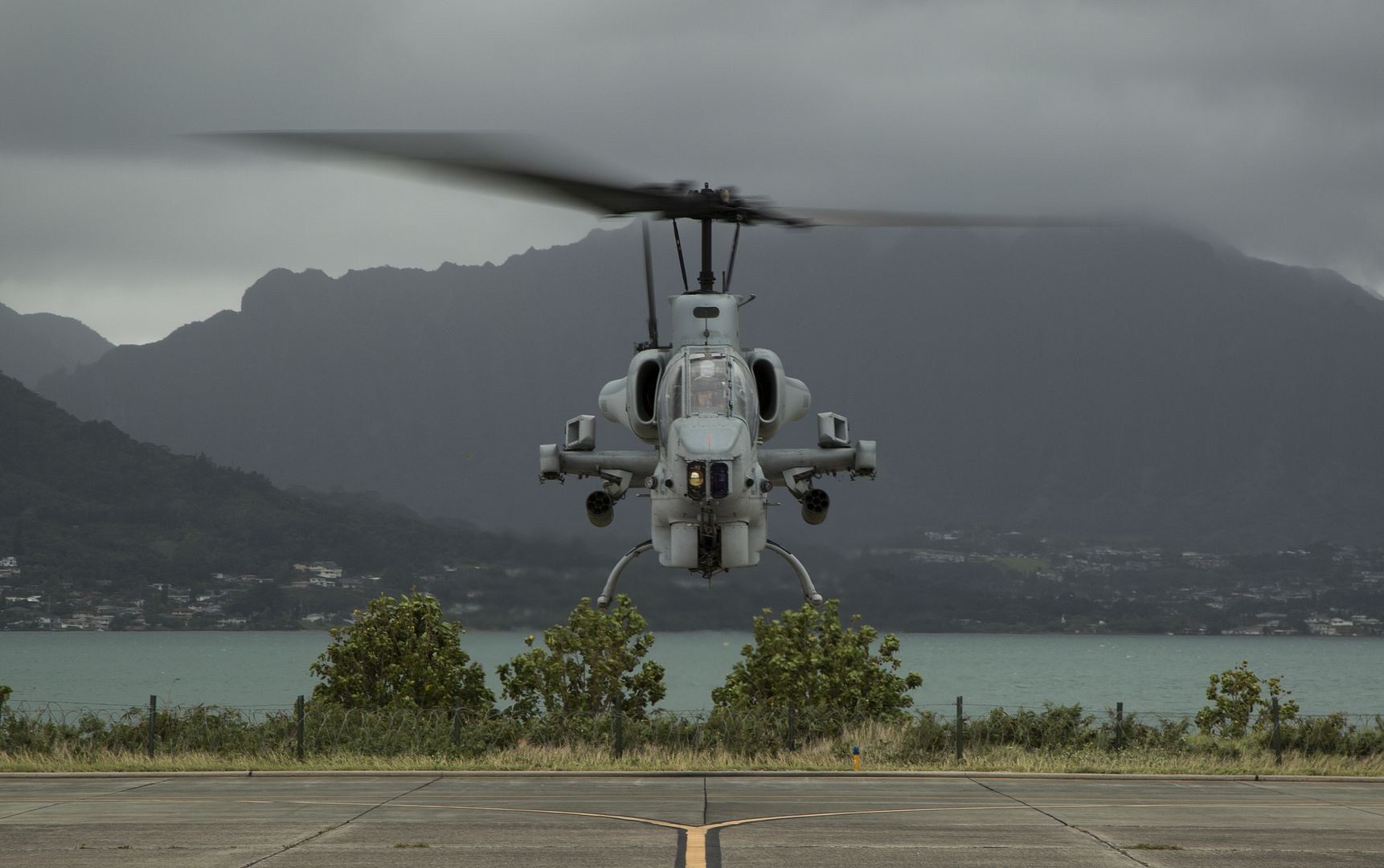
An Indonesian air force F-16 Fighting Falcon prepares to takeoff during exercise Cope West 18 (CW18) from Sam Ratulangi International Airport, Indonesia, March 15, 2018. CW18 is a Pacific Air Forces-sponsored, bilateral, tactical fighter aircraft exercise involving the U.S. and Indonesian air forces and is designed to advance interoperability and build upon already established partnerships between the air forces. (U.S. Air Force photo by Tech. Sgt. Richard Ebensberger)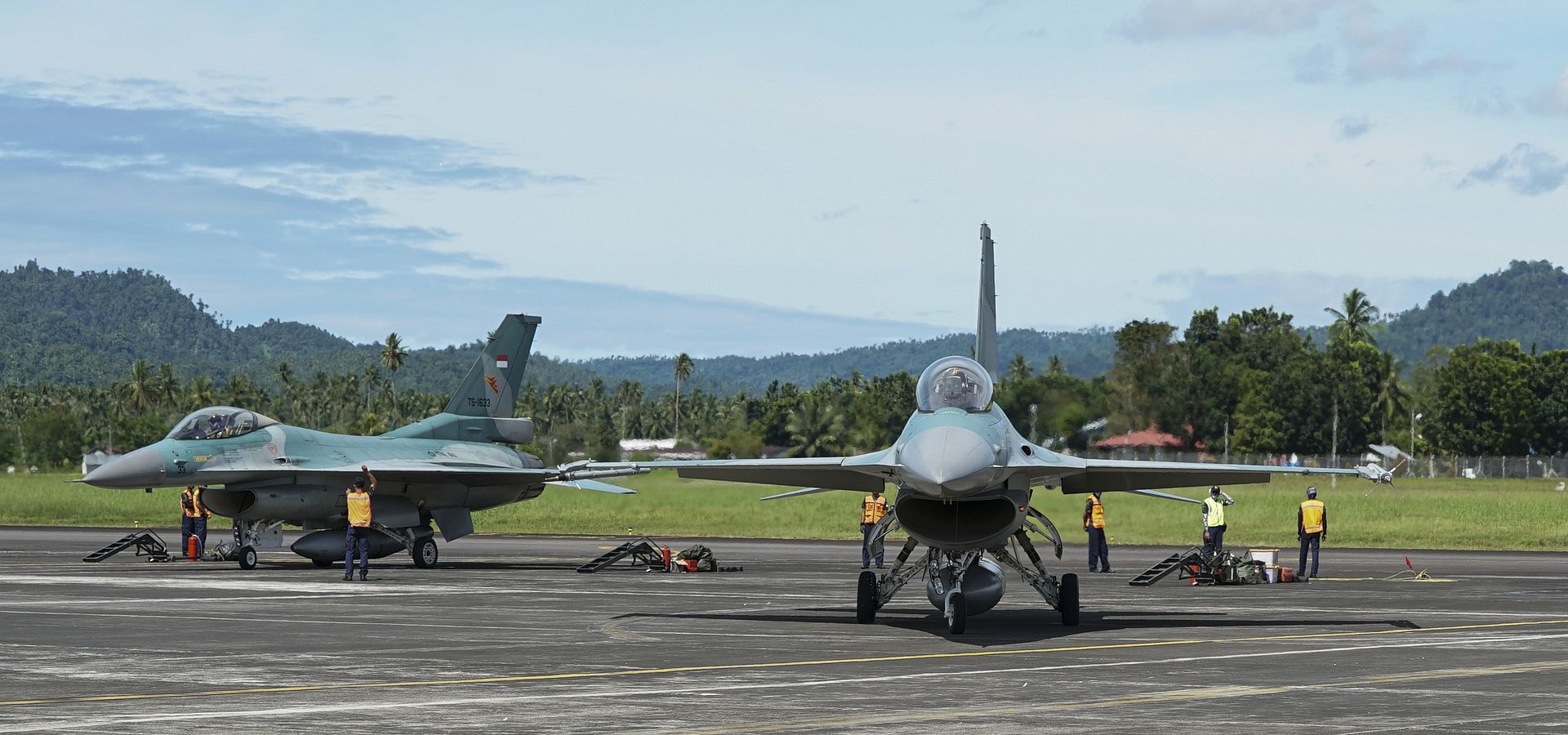
PACIFIC OCEAN (March 15, 2018) An MV-22 Osprey assigned to Marine Medium Tiltrotor Squadron (VMM) 262 prepares to land on the flight deck of the Nimitz-class aircraft carrier USS Carl Vinson (CVN 70). The Carl Vinson Carrier Strike Group is operating in the western Pacific as part of a regularly scheduled deployment. (U.S. Navy photo by Mass Communication Specialist 3rd Class Matthew Granito/Released)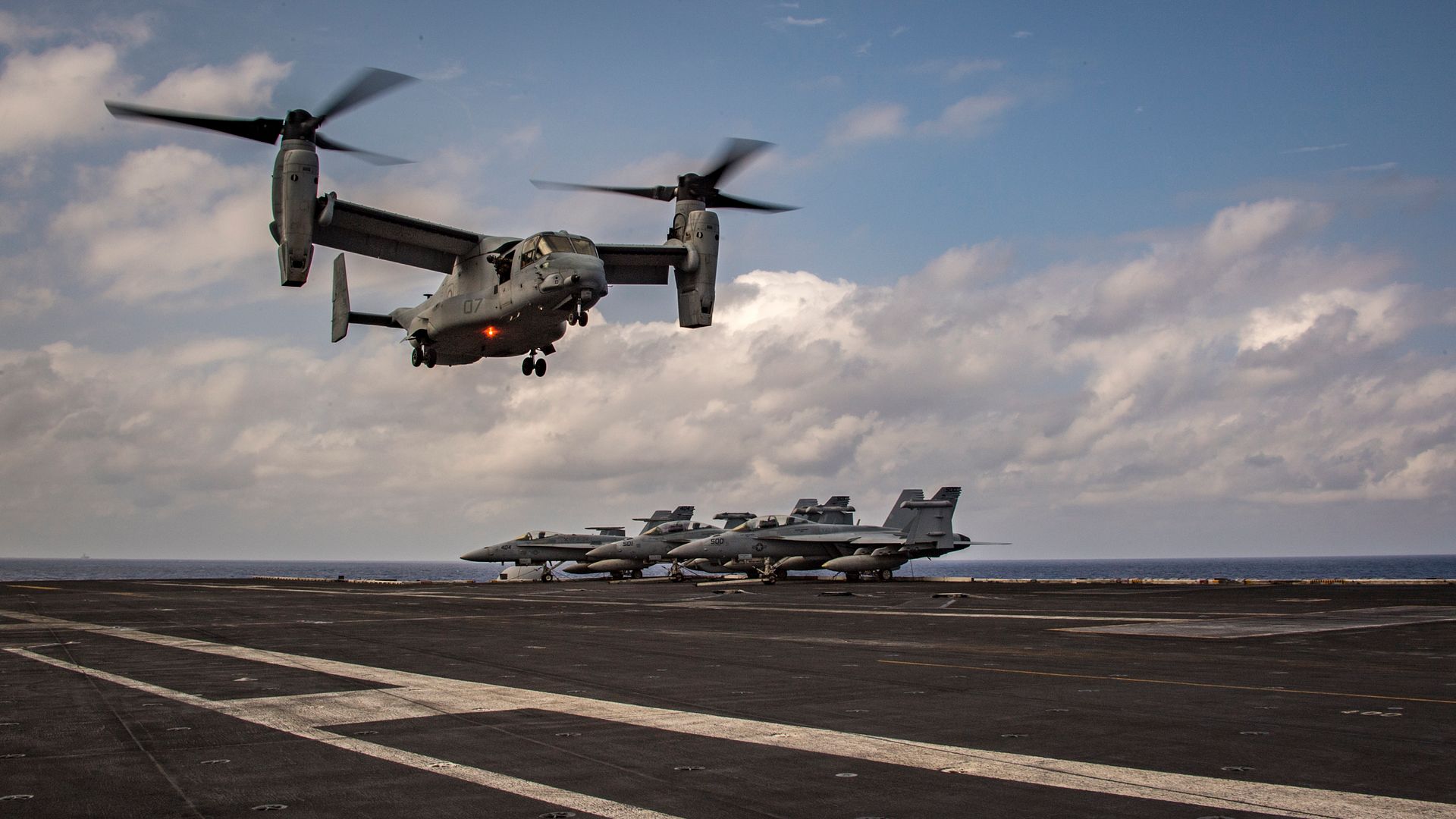
ORLANDO, Fla., March 15, 2018 /PRNewswire/ -- The U.S. Air Force awarded Lockheed Martin (NYSE: LMT) a contract to provide comprehensive training support services for Air Force Special Operations Command (AFSOC), supporting schoolhouse operations for various crew positions across multiple mission design series aircraft, aircrew training and support for AFSOC Special Operation Forces (SOF) aircrews and assets. The Air Commando Training and Support (ACTS) contract has the potential of lasting up to eight years, with an overall value of $200 million or more.
The AFSOC ACTS program provides Air Force special operations with aircrew instruction and distributed, fully-networked mission rehearsal and training capabilities, as well as logistics support for numerous AFSOC weapon systems, including the special mission C-130J, CV-22 and a wide variety of other training systems.
"Through the ACTS program, we offer a realistic, concurrent, resilient and cost-effective training solution to meet the rapidly changing requirements and needs of the modern warfighter," said Tom Gordon, vice president of Training and Simulation Solutions at Lockheed Martin. "Lockheed Martin has been supporting AFSOC for over 27 years, and we are proud to continue this partnership by delivering innovative solutions to prepare them for their most critical missions."
Under this contract, Lockheed Martin will provide engineering and cybersecurity support that will ensure AFSOC's training devices remain concurrent with their aircraft. Through advancements with virtual reality development, this program will offer aircrew members with next-generation training capability.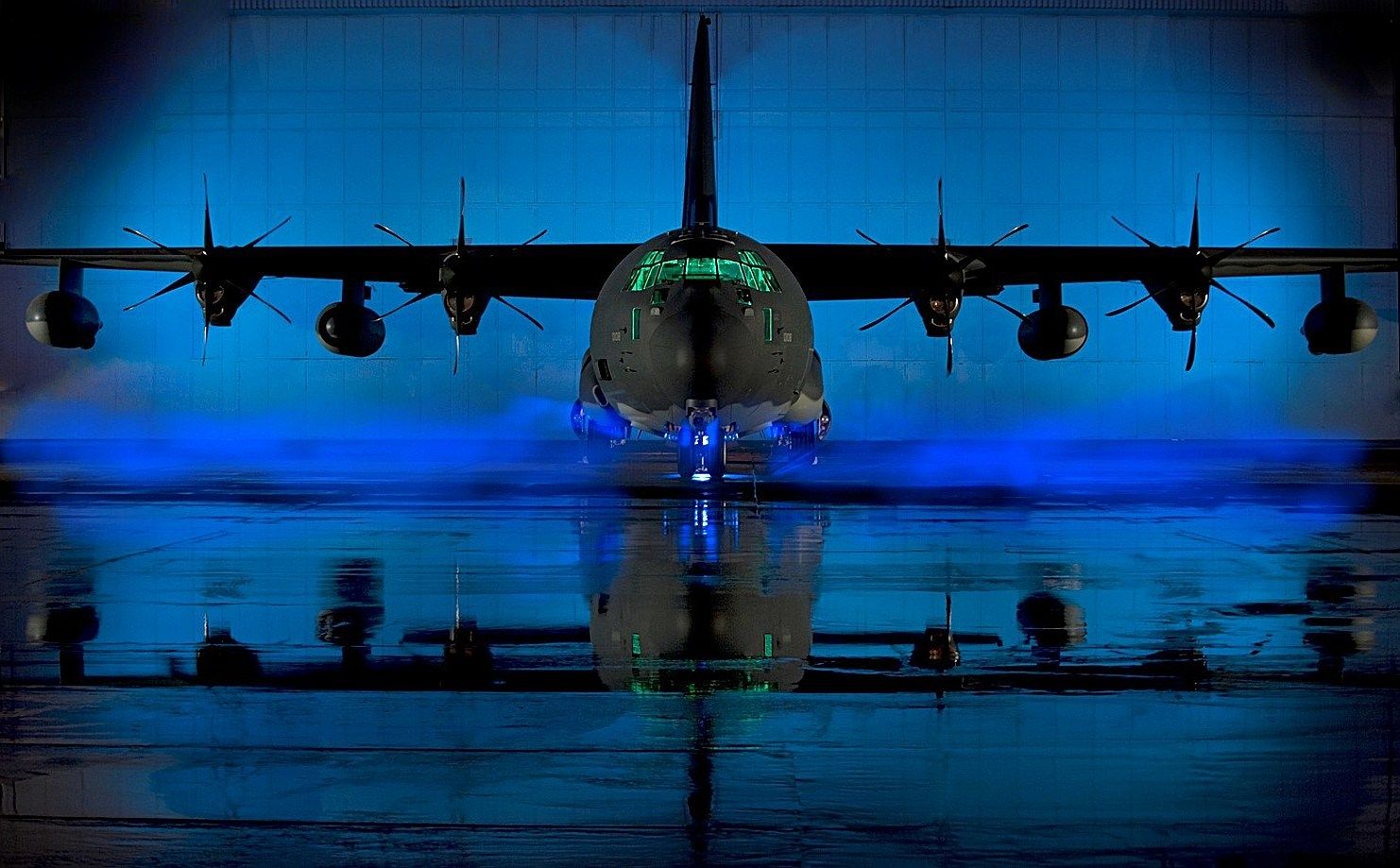
14 March 2018
GlobalEye took off on its maiden flight at 12.52 local time on 14 March 2018, from Saab?s airfield in Link?ping, Sweden. The aircraft, a modified Bombardier Global 6000 jet platform, undertook a 1 hour 46 minutes test flight collecting extensive flight-test data using the on-board instrumentation suite. This data is then used to verify the aircraft performance and associated modelling. The first flight was preceded by a series of ground trials including high and low speed taxiing tests.
?The first flight is the second major milestone for the GlobalEye programme within a very short space of time. Yet again we have demonstrated that we are delivering on our commitments and that we are on track with our production of the world?s most advanced swing-role surveillance system,? said Anders Carp, Senior Vice President and head of Saab?s business area Surveillance.
?Today?s flight went as planned, with the performance level matching our high expectations. The aircraft?s smooth handling was just as predicted and a real pleasure for me to fly,? said Magnus Fredriksson, Saab Experimental Test Pilot.
The maiden flight took place three weeks after Saab revealed the GlobalEye aircraft to the media for the first time on 23 February 2018. GlobalEye combines air, maritime and ground surveillance in one swing-role solution. GlobalEye carries a full suite of sophisticated sensors including the powerful new extended range radar (Erieye ER), integrated with the ultra-long range Global 6000 aircraft, known for its versatility and smooth flight characteristics.
The GlobalEye launch customer is the United Arab Emirates Armed Forces, where it is known as the Swing Role Surveillance System (SRSS). The initial order was placed in November 2015. GlobalEye brings extended detection range, endurance and the ability to perform multiple roles, including tasks such as search and rescue, border surveillance and military operations.
Bombardier and Global 6000 are trademarks of Bombardier Inc. or its subsidiaries.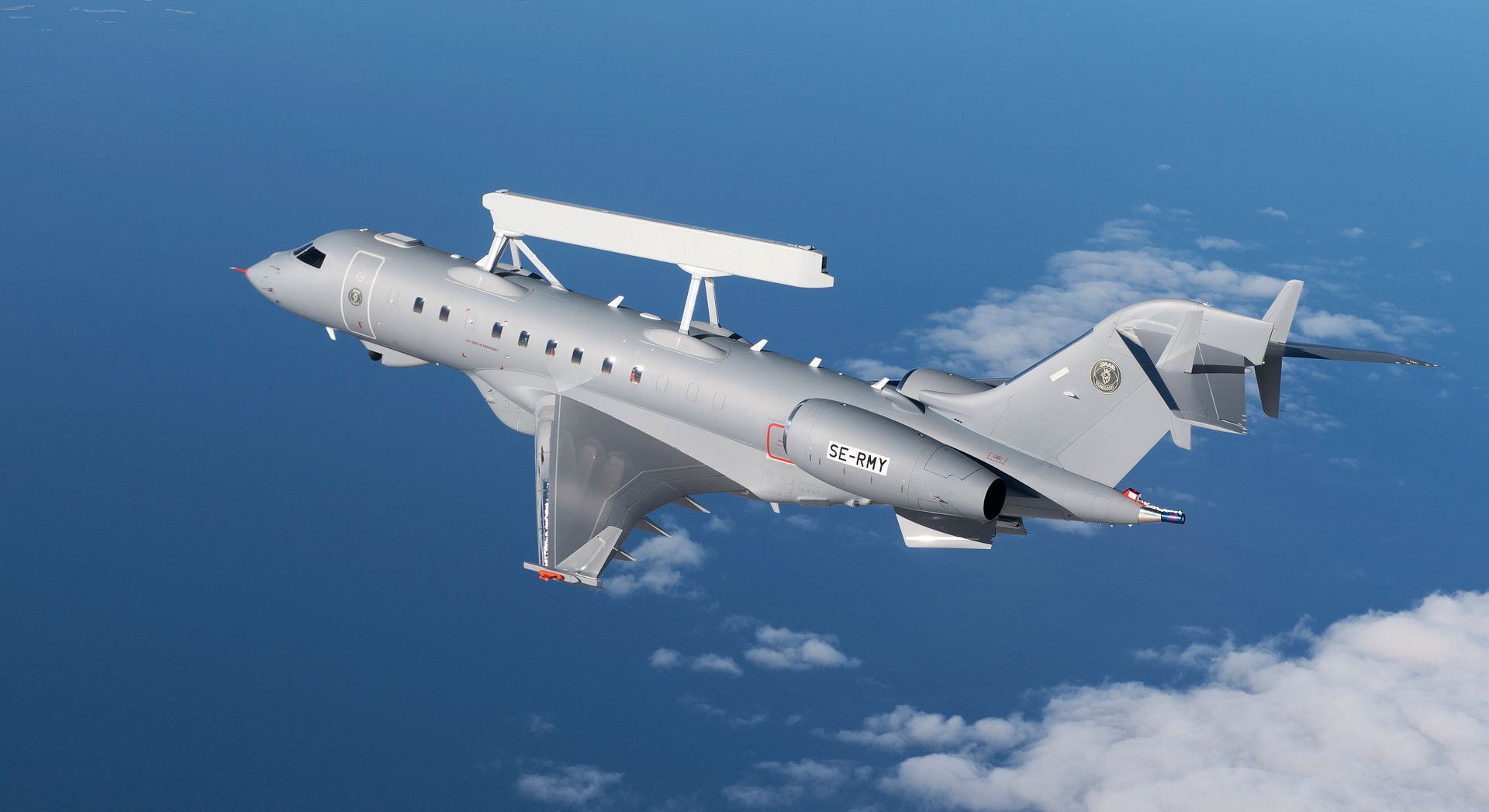
RAF Typhoons are taking part in one of Europe?s biggest military exercises to bolster NATO?s ability to respond to aggression.
Six jets from Royal Air Force Coningsby-based 3 (Fighter) Squadron are in Greece to test their skills alongside the Hellenic Air Force and Top Guns from America, Italy, and the United Arab Emirates.
It?s the RAF?s first appearance at Exercise Iniochos and the Typhoons have been practising air tactics in a multinational environment in preparation for future Coalition operations in the #MiddleEast and elsewhere.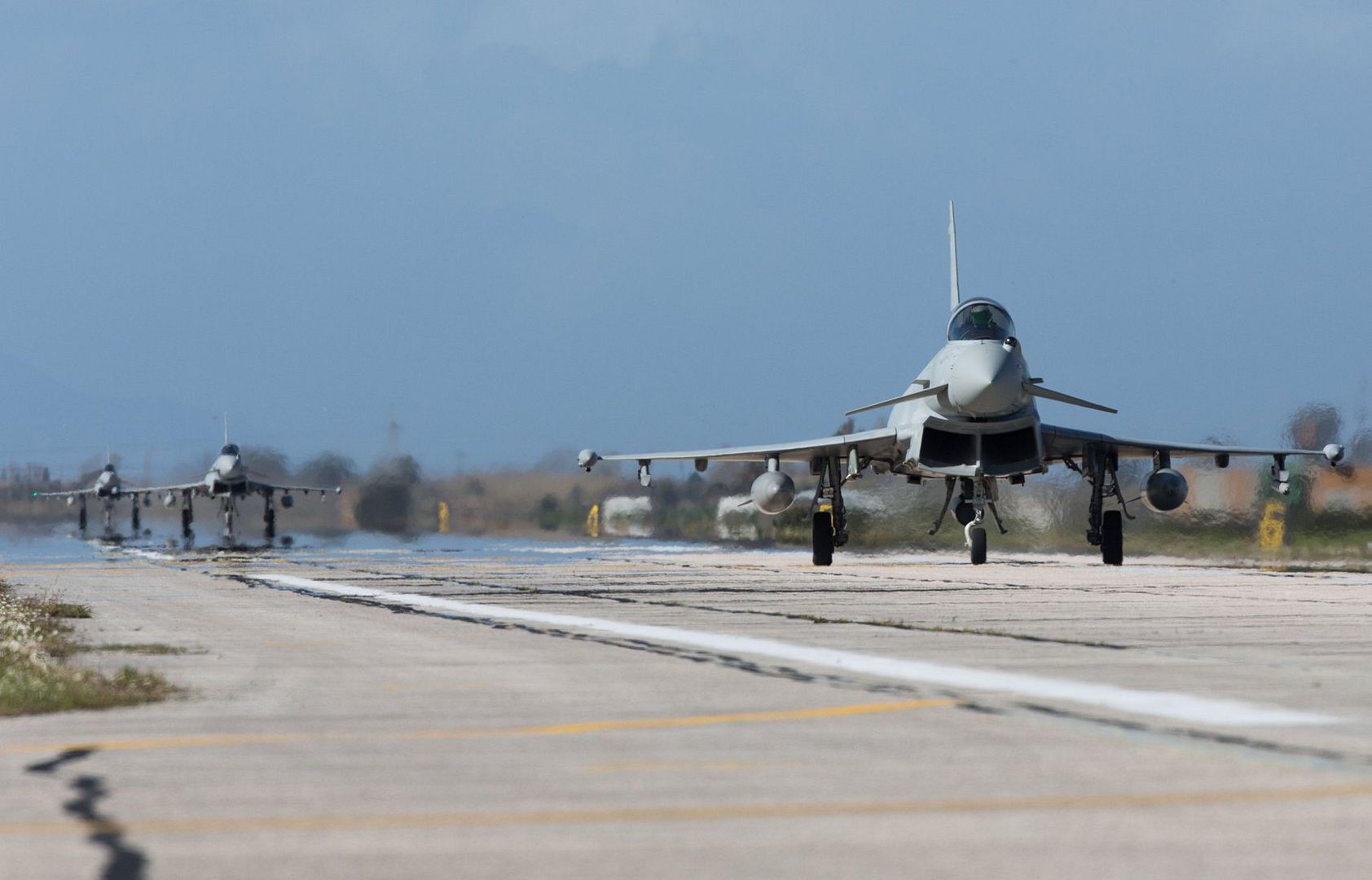
UK Detachment Commander Wing Commander Lewis Cunningham said: ?This is the first time that Typhoon has deployed to Greece. This Exercise offers us a great opportunity to prepare for future operations and strengthens our existing relationship with the Greek Armed Forces.?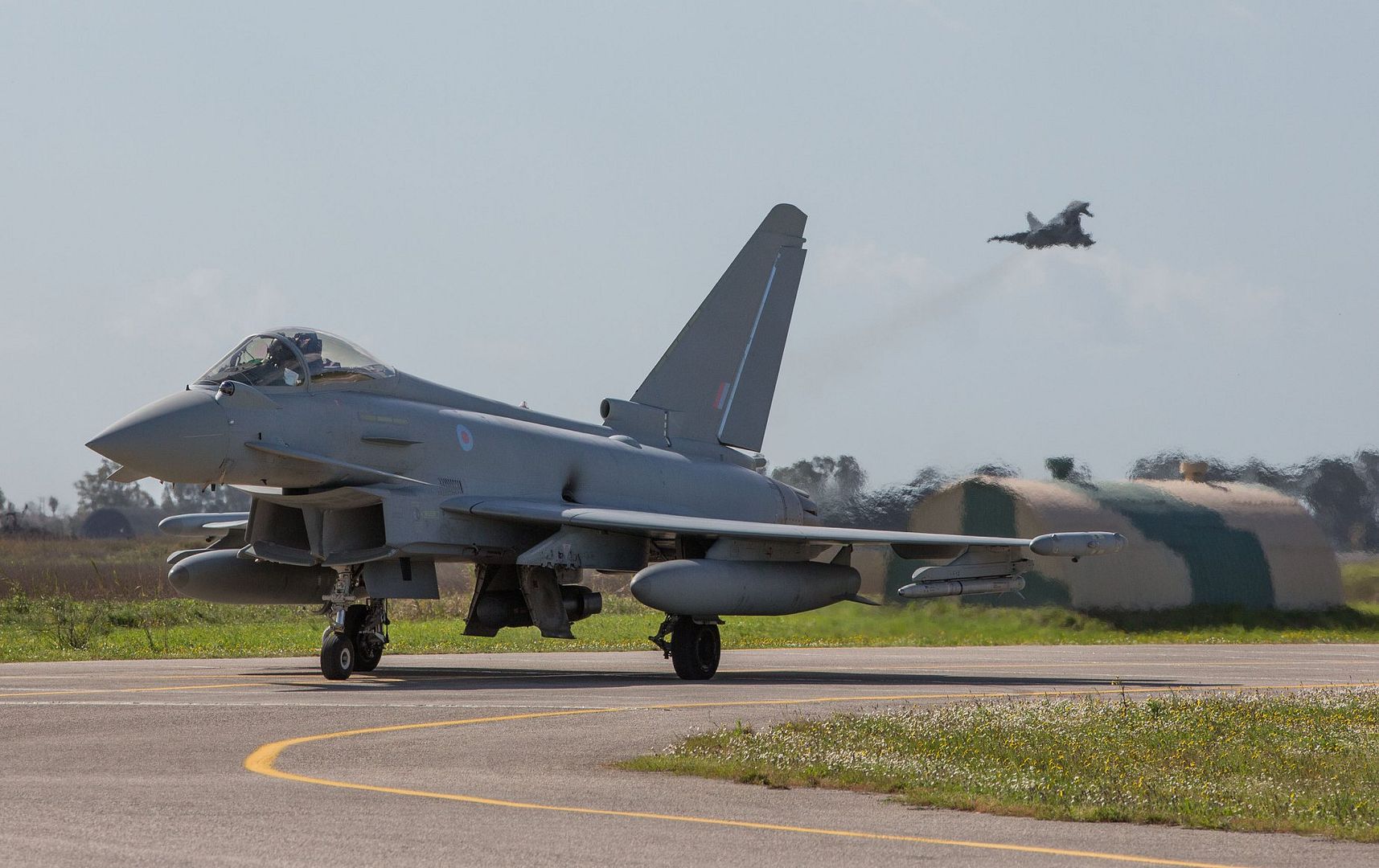
News Article / March 15, 2018
From NORAD/USNORTHCOM Public Affairs
A Royal Canadian Air Force Second World War veteran and former prisoner of war now living in Colorado Springs, Colorado, received a surprise visit on February 23, 2018.
Squadron Leader (retired) George Sweanor, 98, was met by members of 419 Tactical Fighter (Training) Squadron at the Colorado Springs Airport following the unit?s training mission in El Centro, California. Squadron Leader Sweanor was one of the founding members of the squadron, known then as No. 419 Squadron, which stood up in 1941 in the United Kingdom as the third RCAF bomber squadron overseas.
Squadron members and Squadron Leader Sweanor talked for more than an hour as he reminisced about his 419 days and his wartime experiences. ?It was an honor for us to meet such a distinguished veteran and founding member of 419 Squadron,? said Major Ryan Kastrukoff, deputy commanding officer of the unit.
During the war, Squadron Leader Sweanor served with the squadron in the United Kingdom. After making multiple flights over enemy territory, he was shot down and captured in 1942, and spent 800 days as a prisoner of war. He was also involved in the daring ?Great Escape? from Stalag Luft III prisoner of war camp in Zagan, Poland, in 1944, and acted as a security lookout during the excavation of the escape tunnel dubbed ?Harry?.
Following the war, Squadron Leader Sweanor remained with the RCAF. He was a member of the group that opened Cheyenne Mountain, the former home of North American Aerospace Defense Command (NORAD), which is celebrating its 60th anniversary this year.
His last assignment was in Colorado Springs, where he retired and began teaching at Mitchell High School. He is also a founding member of 971 Royal Canadian Air Force Association Wing in Colorado Springs, and regularly attends events as a special guest, along with members of the Canadian Armed Forces serving at NORAD.
Squadron Leader Sweanor was a special guest at Canada Day celebrations at NORAD Headquarters in 2014. At that time Canadian Lieutenant-General Alain Parent, then-deputy commander of NORAD, presented Squadron Leader Sweanor with the ?Bomber Command Bar? to be affixed to the Canadian Volunteer Service Medal, in recognition of his service with Bomber Command.
During the recent visit, squadron members presented him with a book commemorating the 75th anniversary of the squadron, a current squadron patch, and a squadron patch with his name stitched into it.
Squadron Leader Sweanor has written one book, ?It's All Pensionable Time: 25 Years in the Royal Canadian Air Force?, and blogs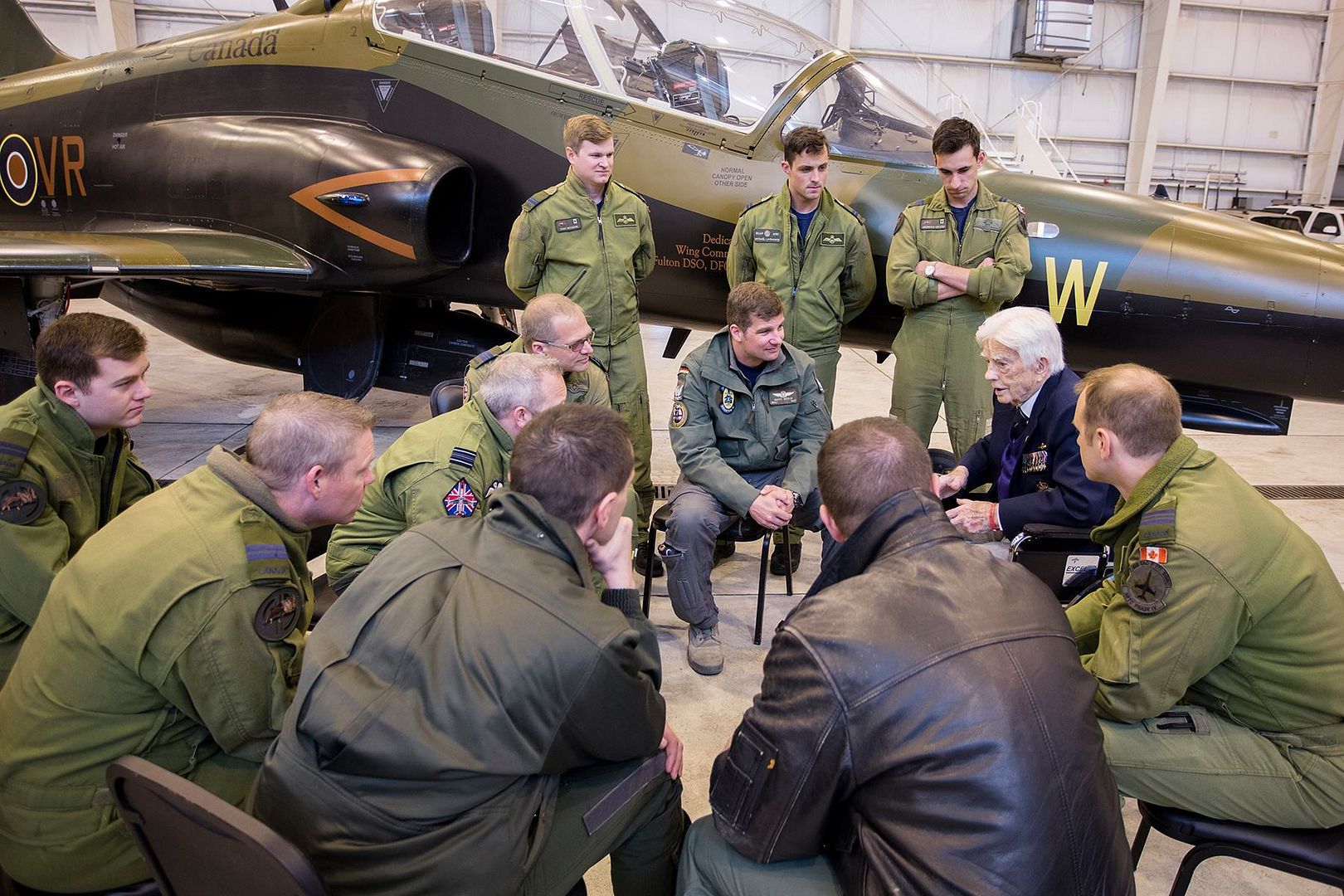
Post a reply
- Go to Next topic
- Go to Welcome
- Go to Introduce Yourself
- Go to General Discussion
- Go to Screenshots, Images and Videos
- Go to Off topic
- Go to Works in Progress
- Go to Skinning Tips / Tutorials
- Go to Skin Requests
- Go to IJAAF Library
- Go to Luftwaffe Library
- Go to RAF Library
- Go to USAAF / USN Library
- Go to Misc Library
- Go to The Ops Room
- Go to Made in Germany
- Go to Campaigns and Missions
- Go to Works in Progress
- Go to Juri's Air-Raid Shelter
- Go to Campaigns and Missions
- Go to Works in Progress
- Go to Skinpacks
- Go to External Projects Discussion
- Go to Books & Resources
